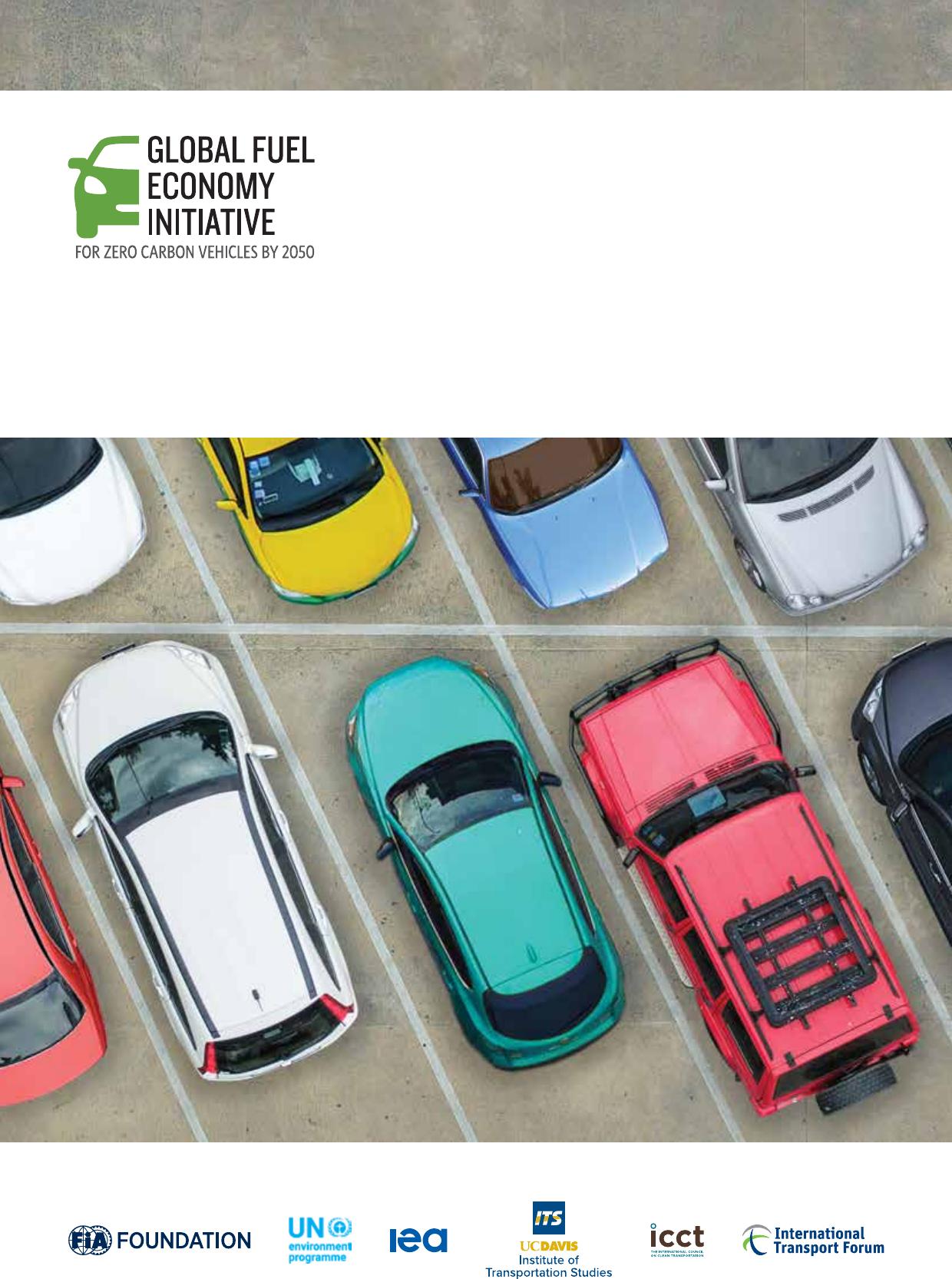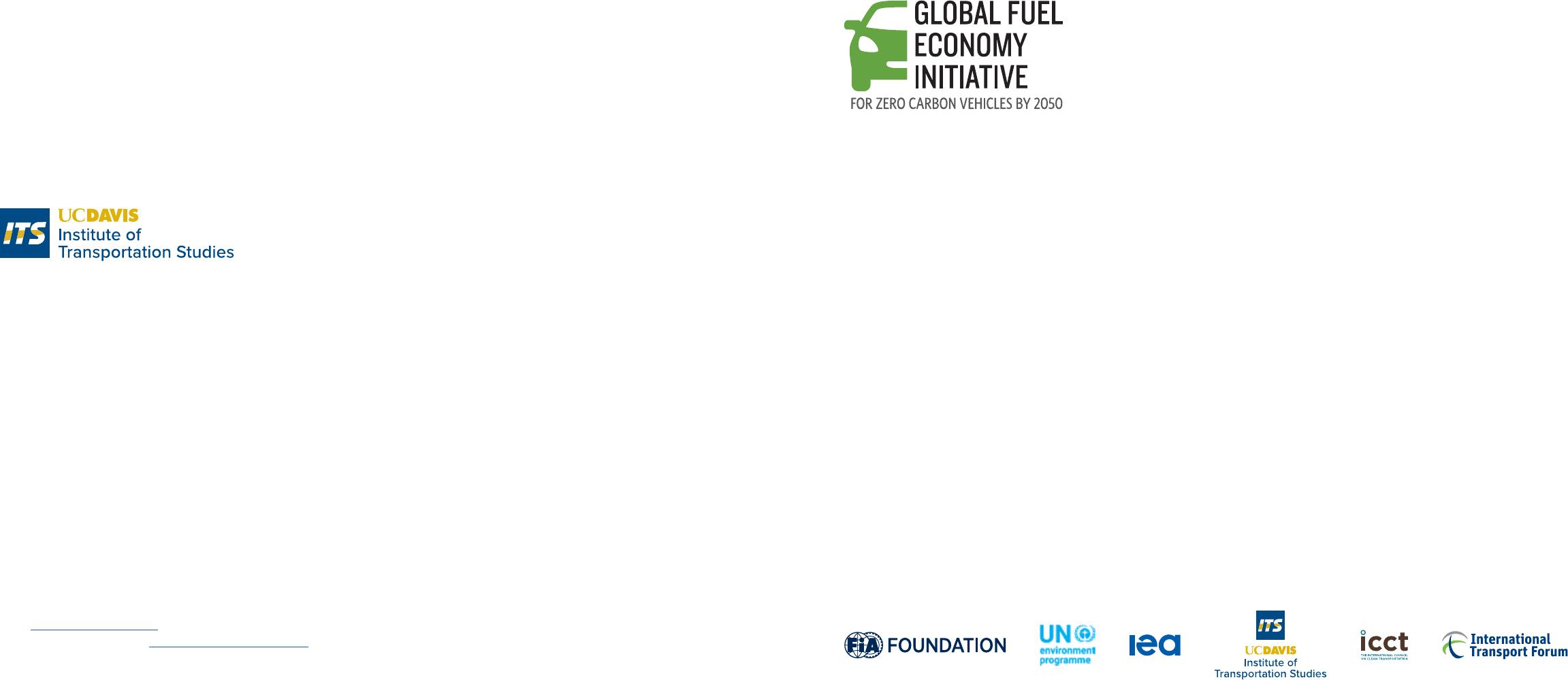TRENDSINTHEGLOBALVEHICLEFLEET2023MANAGINGTHESUVSHIFTANDTHEEVTRANSITIONACKNOWLEDGMENTSTRENDSINTHEGLOBALVEHICLETheprojectwasdevelopedattheEuropeanTransportandEnergyResearchCentreoftheInstituteofTransportationFLEET2023Studies,UniversityofCalifornia,Davis,andmanagedbyPierpaoloCazzola.MANAGINGTHESUVThisreportwasauthoredbyPierpaoloCazzola,LeonardoPaoli,andJacobTeter.Allauthorscontributedtothedevelopmentofthedataprocessingmethodology,buildingonearlierexperiences,inparticularwithpreviousGFEISHIFTANDTHEEVbenchmarkingreports.LeonardoPaoliledonupdatingthedataandmakingthempubliclyavailable.TRANSITIONSheilaWatson(FIAFoundation)providedfeedbackonthedraftreportandJohnPap(FIAFoundation)managedtheeditorialprocess.Theauthorswouldliketothankpeerreviewerswhoprovidedessentialfeedbacktoimprovethequalityofthereport.TheyincludeElizabethConnelly(IEA[InternationalEnergyAgency]);MatteoCraglia(InternationalTransportForum);FrancoisCuenot(UnitedNationsEconomicCommissionforEurope);EduardoEspitiaEcheverria(WorldBank);LewFulton(UniversityofCalifornia,Davis);MathildeHuismans(IEA);AlexKörner(UnitedNationalEnvironmentProgramme);AdityaRamji(UniversityofCalifornia,Davis),MaríaSantosAlfageme(InstitutoSuperiorTécnico,Lisbon);JulesSery(IEA);andJacopoTattini(JointResearchCenter,EuropeanCommission).TheprojectwasfundedbytheFIAFoundation.DesignbyDianaFaunerandJohnRigby.PhotographybyAlamy,GettyImages,iStockandShutterstock.DOI:10.7922/G2HM56SVDatasetonZenodo.DOI:10.5281/zenodo.10148349November2023CONTENTSExecutiveSummary14.3Vehicletaxation454.3.1Country-leveltaxationframeworks451Introduction54.3.2Keyexamplesofcountry-widedifferentiatedvehicleregistrationtaxes454.3.3Vehicletaxationrelatedtointernationaltrade462Keydevelopmentsinlight-dutyvehiclemarkets64.3.4Localvehicletaxesandcharges472.1Newsalesofpassengercarsandlightcommercialvehicles64.4Changesinvehicletaxestoaddressvehicleweightincreasesandequity-related482.2Energyefficiencyofnewvehicles8challenges2.2.1Technicaldeterminantsoftheenergyefficiencyofvehicles114.4.1Changesincountry-leveltaxationframeworks482.2.2Tailpipecarbonemissionsofnewlight-dutyvehicles134.4.2Changesinvehicletaxationrelatedwithinternationaltrade492.3Vehiclesalesbypowertrain134.4.3Changesinlocalvehicletaxesandcharges502.4Vehiclesalesbysegment154.5Fueltaxationandcarbonprices502.5Vehiclesizeandweight194.5.1Roaduserchargestocomplementorprogressivelyreplacefueltaxation514.6Alternativeenergyinfrastructure(EVchargers)523Analysisofthevehiclemarketdevelopmentsandimplicationsforpolicyaction214.7Sustainablefinanceanddevelopmentaidfunding543.1ImpactsoftheshifttowardsSUVs213.1.1EnergyandCO2emissions21Annex:Methodologicalnote553.1.2Vehicleweight21A.1Descriptionofdatasources553.1.3Roadsafety23A.1.1Fueleconomyinmajorcarmarkets(2005-2017)data,GFEI_0517553.1.4Equity23A.1.2GFEI2021data,IEA_19553.2TheroleofEVsintheshifttowardsSUVs25A.1.3AutomotivesalesdatafromMarklines553.3ImpactsoftheEVtransition26A.1.4CO2emissionsfromcarsandvans,EEA,EEA573.3.1EnergyandCO2emissions26A.2Descriptionofdataprocessingsteps573.3.2Vehicleweight27A.2.1PreparingMarklinessalesdata573.3.3Roadsafety30A.2.2PreparingIEAspecificenergyconsumptiondata573.3.4Equity31A.2.3PreparingEEAdata573.4AreSUVsandEVsincreasingtheriskofaglobaldivide?31A.2.4MatchingofpowertraincategorieswithMarklinescategories593.5Needforpolicyactiontoaddressexistingchallenges32A.2.5Joiningspecificenergyconsumption,weight,andfootprintdatatosales59data4Policyoptions35A.2.6ImprovementsinICEvehicleefficiencytechnologies594.1Regulatorypolicyframeworksonenergy,environmentandsafety37A.2.7MismatchbetweenvehiclefactoryshipmentsandregistrationsinChina594.1.1Environmentalregulations37A.3ApplyingnewWLTCcorrections604.1.2Roadsafetyregulations39A.3.1Re-benchmarkingNEDCtoWLTCconversionfactors614.1.3Useofregulationsinvehicletrade40A.4Regionalaggregations614.1.4Urbanaccessrestrictions404.1.5Targetedregulatoryrequirementsforspecificusageprofiles40Abbreviationsandacronyms664.2Regulatorychangestoaddressvehicleweightincreasesandequity-related40Unitsofmeasure66challenges4.2.1Regulationsonvehiclefootprint41References674.2.2Regulationsonbatterycapacity414.2.3Otherregulatoryrequirementsapplyingspecificallytobatteries41Endnotes774.2.4Changesinexistingenvironmentalregulations424.2.5Changesinexistingroadsafetyregulations444.2.6Changesintargetedregulatoryrequirementsforspecificusageprofiles44TRENDSINTHEGLOBALVEHICLEFLEET2023-MANAGINGTHESUVSHIFTANDTHEEVTRANSITIONEXECUTIVESUMMARY2022.TheyearlyrateofenergyefficiencyimprovementSportUtilityVehicles(SUVs),underpinningincreasesinbetween2019and2022wasmorepronounced(closelarger,heavier,andmorepowerfulvehicles,hascontinuedThisisthelatestupdateofabenchmarkingreportlookingdecreasedinallmajorcarmarketsfrom2019toto6%)inmarketswhereEVsalesincreasedthemost,inmajorautomotivemarketsandacrossnearlyallatthespecificfuelconsumptionoflight-dutyvehicles2022,improvingatanaverageyearlyrateof3.2%namelyChinaandEurope.InNorthAmerica,lowercountries(FigureES3).In2022,salesofSUVsovertook(LDVs).Whilereportingdatastartingin2005,itfocusesandreaching6.9Lge/100kmin2022(0.64kWh/uptakeofEVsandacontinuedtrendinsalesoflargerandsalesofconventionalcarsatagloballevel,reachingonchangesthatoccurredbetween2019and2022.km).Thisisadoublingoftheaverageimprovementheaviervehicleshasresultedinayearlyimprovementrate51%ofthetotal.Globally,theaveragevehicleweightofrateobservedbetween2005and2019(1.6%)(Figureof1.6%.IncountrieswhereEVsarenotwidelydeployed,LDVshasalsoreachedanall-timemaximum,at1530Keydevelopmentsincludea15%contractionofglobalES1).DirectCO2emissionshavedeclinedevenfaster,annualimprovementratesarealsocloseto1.5%.kg.Averagefootprinthasstagnatedafter2019/2020atLDVsalesin2020asaconsequenceofthepandemic,atarateof2.1%peryearbetween2005and2022,about4.2m2.Increasestookplaceinlow-andmedium-andalimitedrecoveryinsalesthrough2022.TheaselectrificationaffectscarbonemissionsmorethanTheefficiencyofnewvehiclesisalsolinkedwiththesize,incomecountries,typicallystartingfromalowerbaseline.sales-weightedspecificenergyconsumptionofLDVsenergyconsumption.weight,andpowerofnewcars.Along-termshifttowardsLimiteddeclinesoccurredmainlyinChinaandEurope.FIGUREES1:TrendsinthespecificenergyconsumptionofnewlightdutyvehiclesinmajormarketsFIGUREES2:GlobalLDVsalessharesbypowertrainSalesshare12Lge/100km1.1290100%kWh/km75%gCO/km27050%1125%0.92500%20052006200720082009201020112012201320142015201620172018201920202021202210BatteryElectricPlug-inHybridHybridMildHybridICEPetrolICEDieselICEOther9230Note:ICEstandsforinternalcombustionengine.Sources:thisassessment(detailsintheAnnex)basedonIEA,2019a;IEA,2021a;EEA,2023a;EEA,2023bandMarklinesdata.0.7210819070.617060.415051304110200250062002700820092010201120122013201420152016201720182019202020221022200250062002700820092010201120122013201420152016201720182019202020221022ChinaNorthAmericaEuropeJapanOtherCountriesWorldNotes:Lgestandsforlitresofgasolineequivalent,anditisusedtostandardisefuelconsumptionaccordingtotheirvolumetricenergyFIGUREES3:GlobalLDVsalesbysegmentcontent,likekWh/km.Thereare9.3kWhperLge.HistoricalspecificenergyconsumptionvalueshavebeenbenchmarkedaccordingtonewunderstandingoftheratiobetweenNEDCandWLTPtestcycleenergyintensityandCO2emissionsperformance.Thisrevisionhasimprovedthe100%real-worldrepresentativenessofthereportedspecificenergyconsumption.SalesShare75%Sources:thisassessment(detailsintheAnnex)basedonIEA,2019a;IEA,2021a;EEA,2023a;EEA,2023bandMarklinesdata.50%25%TheglobalaverageannualrateofenergyintensityTherapidaccelerationinenergyefficiencyseeninrecent0%reductionsintheperiodfrom2020to2022yearsismainlyduetotheuptakeofelectriclight-duty200520062007200820092010201120122013201420152016201720182019202020212022was4.2%.Ifthisrateofimprovementcouldbevehicles(EVs,whichincludebothbatteryelectricvehiclessustainedthrough2030,itwouldbringLDVsvery[BEVs]andplug-inhybrids[PHEVs])(FigureES2).LargeSUVSmallSUVSmallCarMediumCarclosetomeetingtheGFEItargetofdoublingtheElectricpowertrainsconsumethreetosixtimeslessLargeCarLCVUnclassifiedShareSUVenergyefficiencyofnewLDVsalesby2030fromaenergythaninternalcombustionenginevehiclestocover2005baseline.aunitofdistanceandtheirsalessharereached15%inSources:thisassessment(detailsintheAnnex)basedonIEA,2019a;IEA,2021a;EEA,2023a;EEA,2023bandMarklinesdata.1TRENDSINTHEGLOBALVEHICLEFLEET2023-MANAGINGTHESUVSHIFTANDTHEEVTRANSITION2ThetwomaintrendsunderpinningdevelopmentsinPOLICYOPTIONSAdaptingexistingpolicyandregulatoryinstruments•Sustainablefinanceframeworks,importanttohelptheglobalcarmarket–amarketshifttowardsSUVscanalsohelpaddresstheseissues.achieveabetteralignmentbetweenthedecisionsandthetransitiontowardEVs–havefar-reachingManagingthesedevelopmentsrequiresabroadrangetakenbyinvestors,corporationsandotherentities,implicationsfortheautomotiveindustry,aswellasofpolicyactions.•Vehicletaxationreforms–includingthecanbenefitfromupdatesintheirtaxonomiesontheenvironmentandsociety.integrationofweightandpricesasmodulatingregardingweight-relatedattributesofvehicles.•Theadoptionandcontinueddevelopmentofparametersforvehiclestaxesandcharges,Shiftstolargerandheaviervehiclesledtoincreasedfundamentalpre-requisites:technicalstandards,atthenationalandatthelocallevels–can•Financialinstrumentsdesignedtofacilitateoilconsumption,directCO2emissionsandvehicleincreasedlow-carbonelectricityavailability,andhelpsteervehiclemarketsawayfromSUVsaccesstoEVsforcapital-constrainedhouseholdsweight,sizeandpower.Withouttheshifttowardsremovaloffossilfuelsubsidies.andencourageEVadoptionwithoutreducingandsmallbusinesses,aswellasinitiativesSUVs,energyuseperkmforcombustionenginegovernmentbudgets.favouringaccesstocapitalatlowercost,arevehiclescouldhavefallenatanaverageannualrate•Acoherentpolicyframeworkisalsoneededcrucialtohelpfavouringanequitabletransition,thatis30%higherthanitdidfrom2010to2022.beyondtailpipeemissions,takingaholistic•Fossilfueltaxesandcarbonpricingmechanismsdomesticallyandinternationally.IntheabsenceoftheSUVshift,vehicleweightapproachtoaddressimpactsofLDVproductionofferimportantopportunitiestoprovideeconomicincreasesforthesesamevehiclescouldalsohaveandoperationsfromalifecycleperspective.incentivesforEVs.IncentivesneedtobetargetedWhileitisalsotechnicallyfeasibletomakeprogressbeenmorethanhalved.onmorevulnerablehouseholdsandbusinesses,byreformingtraderulesandtariffsappliedtocriticalNovelregulatorymechanismscanaddressissuesfacilitatingamoreequitableandinclusiveminerals,EVbattery,andvehicles,progressonthisImpactsoftheSUVshiftonenergyuseanddirectrelatedtoincreasedvehiclesizeandweight.transition.TheycanbefinancedfromrevenuesdependsupontheeffectivenessofthedialogueandemissionsofCO2perkmarebeingoffsetbyincreasedfromfossilfueltaxesandcarbonpricing.negotiationstakingplaceattheintergovernmentalelectrification,thankstomarkedlylowerspecificenergy•Theintroductionofacaponvehiclefootprint,inlevel.Possibleimprovementstotrade-relatedpoliciesconsumptionversuscombustionvehicles.absolutetermsandasasales-weightedaverage,•Regulatoryandfiscalmeasuressupportingonvehiclesincludedifferentiatedtariffsbasedonpairedwithnetdeclinesgoingforward,tolimituniversalaccesstoEVcharginginfrastructurepowertrain,batterysize,energyefficiency,GHGElectricvehicleshowevertendtoweighmorethanandthenreversetheSUVshift.areneededtoenableconsumerstogainmoreemissions,vehicleweightandfootprint.Theyarefeasiblecombustionvehicles,andtheirrisehasaddedtotheconfidencetoundertakealargershareoftheiraslongasthedifferentiationalignswithrulesoforigin,weightincreasescomingfromtheshiftfromsmall•Corporate-averageregulatoryrequirements,tripsevenwithashorterrange,therebyalsoenvironment-andnationalsecurity-relatedexceptionsandmediumcarstoSUVs.similartothoseinplaceforfueleconomyoraddressingweight-relatedchallengesforEVs.foreseenbytheWorldTradeOrganization(WTO).CO2emissions,havingbatterycapacity(kWh/Despiteincreasesindisposableincomeofvehicle)astheregulatedparameter.Thesehouseholdsworldwide,theSUVshiftwascouldbeespeciallyeffectivetocomplementinstrumentalforanincreaseinoriginalequipmentthefootprintregulationstoreversetheSUVmanufacturers(OEM)profitabilitythatremainedshift,addressingcriticalmineralissuesfrominplaceevenafterthecontractionobservedinthethedemandsideandequityissuesspecificallyglobalLDVmarket.This,however,alsoresultedinrelatedwithEVsthroughproductdiversification,relevantaffordabilityandequitychallengeswithinwhileleavingroomforinnovationinbatteryandacrosscountries.HigherinvestmentcostschemistriesandprovidingflexibilityinneededforEVsexacerbatedthesechallenges,evencompliancestrategiesforautomakers.ifsavingsfromlowerenergyandmaintenancecostsforEVshelptomitigatethiseffectonatotalcostof•Theuseofvehiclefootprint,ratherthanweight,ownershipbasis.isalsosuggestedasthebestchoiceasamodulatingparameterinexistingregulationsLegacyOEMshavebeenslowtoentertheEVmarket,onspecificenergyconsumptionordirectCO2especiallyinsmallersegments,despitetheriskofemissions,alongsidetightenedrequirementsexposuretolong-termlossesofmarketsharestoforlargervehicles(includingbothICEVsandChinesecompetitors.Reasonsincludethenear-termEVs).Thisisbecauseregulatingbasedonfocusonhigherprofitability,thecostofthebatteriesfootprintcanincentivizelightweightingasanforBEVsandcomplexpowertrainsforPHEVs,energyconsumptionreductionstrategy,whereaschallengesinthedevelopmentofnewbatterysupplyweight-basedregulationsfailtodothis.chainsandlargecapitaloutlaysforinvestmentinnewindustrialfacilities.ThisreportproposesalsototargetmorestringentenvironmentalandsafetyregulationsonhighlyutilizedEquity-relatedchallengesandgreaterexposurevehiclessuchascompanycars,taxis,governmentoflow-incomehouseholdsandbusinessestothefleets,andride-andcarsharingservices.MeasurescombinedmarkettransformationtowardsEVsandrequiringhigherEVmarketsharesandincentivizingSUVspointtowardsthepossibilityofagrowingelectricvkmintheseusecasescanenhanceefficiencyglobaldivide,notonlywithindifferentincomegroupsintheuseofmineralsforEVbatteriesandmayalsowithincountries,butalsobetweenmajordevelopedgeneratepositivespilloversintermsofequity.economiesandothercountries.3TRENDSINTHEGLOBALVEHICLEFLEET2023-MANAGINGTHESUVSHIFTANDTHEEVTRANSITION41INTRODUCTION2KEYDEVELOPMENTSINLIGHTDUTYVEHICLEThisreportisthelatestupdateandsixthinstalmentChina,Europe,Korea,JapanandNorthAmerica,1MARKETSoftheGlobalFuelEconomyInitiative’sbiannualresultinginsubstantialenergyintensityandGHGbenchmarkingreportonlight-dutyvehiclesales,emissionreductions.2.1NEWSALESOFWorldwide,thesalesoflight-dutyvehicles(LDVs)extendingtheanalysisfrom2019through2022.PASSENGERCARSAND–includingpassengercarsandlightcommercialPreviousreportstrackedthetechnical,market,andChapter3analyseskeydeterminantsoftheobservedLIGHTCOMMERCIALvehicles2–steadilyincreasedthrough2017,andthenpolicydriversoffueleconomyandCO2emissionsmarketdevelopments,withaspecificfocusontheVEHICLESsloweddownthrough2019(Figure1).Longterm-performanceofnewlight-dutyvehicles(LDVs)atshifttowardsSUVsandtheincreaseinEVshares.IttrendsweredisruptedbytheCovid-19pandemicinacountry,regional,andgloballevel(Cuenotandexaminesthebroaderimpactsofthesedynamics,2020,whichresultedinarapiddropofsalesacrossFulton,2011,CuenotandKörner,2013,IEA,2019a,focusingonvehiclesize,weight,andpriceincreases,allregions:globally,15%fewerLDVsweresoldinandIEA,2021a).Thesereports,togetherwithotherandconsidersaspectsrelatedwithenergy,emissions2020thanin2019.Following2020,salesrebounded,GFEIanalyses(Cuenot,2017),havedocumentedtheofCO2andlocalairpollutants,roadsafety,demandforbutarestillaround10%lowerthantheywerebeforerisingmarketsharesofSportUtilityVehicles(SUVs),mineralsresources,andequity.thepandemic.andmoregenerally,oflargerandheaviervehicles,andanalysedtheimpactofthesetrendsonenergyThefollowinganalysis,inChapter4,reviewspoliciesFIGURE1:GlobalLDVsalesbyregion2005-2022efficiencyandCO2emissionsinmajorLDVmarkets.alreadydevelopedbygovernmentstoaddresstheimpactsofrecentmarketdevelopments,identifiesmillionunits100Thisreporttracksthiscontinuingtrend,highlightingbestpractices,andrecommendschangesandnew90keyimplications,includingreducedenergyandregulatoryinstrumentsthatarebestsuitedtoaddress80resourceefficiency,increasedvehicleproductionthechallengesdiscussedinChapter3,placinga70costsandreducedaffordabilityforvehicleowners–greateremphasisonsolutionsthathelpbridgetherisk60exacerbatinginequalitieswithinandamongcountriesofaglobaldivide.50–aswellasheightenedinjuryandmortalityrisksto40pedestrians,cyclists,andcardriversalike.ExaminingThemethodologicalapproachofthisupdatediffers30vehiclesalestrendsinlow-andmedium-incomefrompreviousGFEIbenchmarkingreports.Ratherthan20countries,thisworkalsoextendsthemesdevelopedrelyingonadatabasewithdetailedmodel-levelandin10intheUCDavisreportcommissionedbytheFIAsomecasestrim-leveldataandincludinganextensiveFoundationfortheZEVTransitionCouncil,“Facilitatinglistofvehicletechnicalparameters(e.g.,weight,0aTransitiontoZero-EmissionVehiclesintheGlobalfootprint,enginecapacity,numberofdoors,presence2005200620072008South”(CazzolaandSantosAlfageme,2023).ofefficiencytechnologiessuchascontinuouslyvariabletransmissions,turbochargers,etc.),thisdataChapter2illustratesthatthetendencytowardsupdatereliesonlowerresolutiondata(stillatthelargermarketsharesforvehiclesinlargerheaviermodellevel)fromMarklines.TheMethodologicalvehiclesegmentsispersistentandwidespread.AnnexoutlinesthemethodsusedtoensureascloseThesameanalysisalsoshowsarapidincreaseinaspossibleconsistencywithpreviousreports,andtovehicleelectrification,withstrongEVadoptioninverifytheaccuracyandvalidityofthisassessment.20092010201120122013201420152016201720182019202020212022ChinaNorthAmericaEuropeJapanandKoreaIndiaIndonesia,Thailand,Vietnam,SouthAfricaBrazil,Mexico,MalaysiaMiddleEastOtherCountriesNote:LDVsalesincludedinthisanalysisandinthisgrapharethoseforthecountrieslistedinannexTableA6.EuropeincludesallmembercountriesoftheEuropeanEconomicArea(EEA)plusSwitzerlandandtheUnitedKingdom.NorthAmericaincludestheUnitedStatesandCanadabutexcludesMexico,includedinthesamegroupasBrazilandMalaysia,astheyhavesimilarcharacteristicswithrespecttoGDPpercapita,whilestillhavingacomparablepopulationdensity,thepresenceofanautomotivemanufacturingcapacityandnotbeinganetimporterofoilandpetroleumproducts.Totalsalesforthissetofcountriesareequivalenttoroughly85%ofthetotalvehiclesalesaccountedbyOICA–includingcommercialvehicles(OICA,2023),meaningthattheyrepresentthevastmajorityoflightdutyvehiclesalesglobally.Sources:thisassessment(detailsintheAnnex)basedonIEA,2019a;IEA,2021a;EEA,2023a;EEA,2023bandMarklinesdata.5TRENDSINTHEGLOBALVEHICLEFLEET2023-MANAGINGTHESUVSHIFTANDTHEEVTRANSITION6Thereboundinsaleshasbeensloweddownbyacombinedshareofthesematuremarketsoutofthe2.2ENERGYandPHEVs,reflectingthefactthatelectricpowertrainsstretchedsupplychain–especiallyduetoashortageofglobalmarkethasdeclinedfromover70%in2005toEFFICIENCYOFNEWconsumethreetosixtimeslessenergytocoveraunitmicrochips–thathasstruggledtokeepupwithswingsunder50%in2022.VEHICLESofdistanceincomparisonwithpowertrainsreliantonindemand(JPMorgan,2023;Brinley,2023,Straughan,internalcombustionengines(ICEs)andtheirsalesshare2023;Burkackyetal.,2021;Burkackyetal.,2022).LDVsalesinNorthAmericadeclined14%in2020Thespecificenergyconsumptionofnewvehicleshasreached15%in2022.Shiftsinthemarketstructure,asdiscussedbelow,fromtheir2019level,andhavedroppedafurther5%decreasedsincethebeginningofthisbenchmarkingaccompaniedbychangesinvehiclepricesaslargersincethen,to13.9millionvehiclesin2022.Globalexercise.Theglobalsales-weightedaveragefuelTheyearlyrateofenergyefficiencyimprovementvehiclesareabovethoseofsmallerones,discussedsupplychainconstraintsandrapidinflation,withtheconsumptionforLDVssoldin2022was6.9Lge/100kmbetween2019and2022wasmorepronouncedininChapter3,arealsoinfluencingconsumerchoicespricesofnewcarsandtrucksrisingevenhigherthan(0.64kWh/km)6,nearly30%lessenergythanthevaluemarketswhereEVsalesincreasedthemost,namelyregardingtheacquisitionofanewvehicle,includingotherconsumergoods(BureauofLaborStatistics,in2005.In2020,GFEIpartnersreaffirmedtheirtargettoChina(5.9%)andEurope(5.8%).InNorthAmerica,throughpostponementofpurchases(GfK,2023;Shmuel,2023),justifythisreduction.5doubletheenergyefficiencyofnewLDVsalesby2030loweruptakeofEVsandacontinuedtrendinsales2022;Romei,2022)oranincreasedconsiderationoffroma2005baseline.Ifitcanbesustainedthroughoflargerandheaviervehicleshasresultedinayearlysecond-handoptions,wheretheyareavailable(RochInJapan,salesofLDVsdeclinedbymorethan10%2030,theglobalaverageannualrateofenergyintensityimprovementrateof1.6%.IncountrieswhereEVsareBaranowskietal.,2023;Manheim,2023).sincethepandemicandremainedroughlyconstantreductionintheperiodfrom2020to2022(4.2%)wouldnotwidelydeployed,annualimprovementratesarethereafter.bringLDVsveryclosetomeetingtheGFEItarget.closeto1.5%.TheChineseLDVmarkethasundergoneaveryrapidrisesincethebeginningofthecentury.ChinabecameInKoreathepandemicdidnotleadtoanyreductionWorldwide,thepaceofannualreductioninenergyFuelpricesandincomelevelsremainkeydeterminantstheworld’slargestLDVmarketin2009andfrominsales,buttherehasbeenasmalldeclinesinceconsumptionperkmdeclinedoverthe2010s,butofvehicleenergyuseperkm,leadingtosystemic2020through2022,withannualsalesof21million2020.In2022,KoreaandJapanaccountedfor8%markedimprovementscanbeseenfrom2019onwards,differencesacrossnationalandregionalmarkets,vehicles,ithasbecomebyfarandawaytheworld’sofglobalLDVsales,thesamesharetheyaccountedassalessharesofelectricvehicleshavebeguntorampasalreadyidentifiedinearlieranalyses(IEA,2019a,largestautomotivemarket,accountingfor29%offorpre-pandemic.upsubstantially(Figure2).TherapidaccelerationinIEA,2021a)andshowninFigure3.TheFigureshowsglobalLDVsalesin2022.Allthesame,China’ssalesenergyefficiencyimprovementsseeninrecentyearsisspecificenergyconsumptionplottedagainstgasolinepeakedin2017andhavesincebeenslowlydeclining.TheEuropeanmarkethasbeenslowerthanothersmainlyduetotheuptakeofEVs,whichincludebothBEVspricesandGDPpercapita,bothcorrectedbasedonSeveralfactors,oftenlimitinggrowthincarownership,torecoverfromtheimpactsofthepandemicduetopurchasingpowerparities.Resultsshowthathigherfuelhelpexplainwhythestabilizationofcarsalesoccurredregionalshortagesofvehiclecomponentsthatwereprices(andtaxes)7tendtobepairedwithlowerenergywhenthenumberofcarspercapitainChinaisstillaggravatedbyRussia’sinvasionofUkraine(VDA,consumptionperkmandalsothatspecificenergywellbelowthelevelsobservedineconomieswith2022).ThishasledEurope’sshareoftheglobalmarketconsumptionishigherincountrieswithlowerlevelsofhigherpercapitaincome.Thesereasonsinclude,intodeclinefrom21%in2019to18%in2022.fueltaxation,acrossdifferentlevelsofaverageincome.8additiontorecentsupply-chainchallenges:VehiclesalesinemergingmarketssuchasIndia,FIGURE2:Trendsinthespecificenergyconsumptionofnewvehiclesinmajorcarmarkets•theearlyphaseofatransitionfromagrowthIndonesia,andBrazilgrewsubstantiallybetweenmarketwheremostvehiclesweresoldtofirst-2005and2010,buttheirgrowthhassloweddownLge/100km12timeownerstoamature“replacement”market;since.In2022,thesemarketsaccountedfor22%ofglobalsales.Thepandemicandtheensuingeconomic11•significantinvestmentsinpublictransport,difficultieshavealsotakenatolloncarsalesintheseincludingurbanandintercityrailservices(Xinhua,countries,withadeclineof20%in2020.Saleshave102020;IEA,2019b;andOuetal.,2022);sinceregained7%,buttheyarestillbelowpre-pandemiclevels.Amongthesemarkets,theIndian9•thefrequentuseofpoliciesmanagingaccessmarkethasbeenparticularlydynamic,asitdeclinedbytopersonalvehiclesincities,alsoinlightoftheastaggering30%in2020buthassinceregainedalltransitiontovehicleelectrification(Feiqietal.,thelossesandsalesvolumesin2022exceedingpre-2020;Liuetal.,2022;Jinetal.,2023;andHeetpandemiclevels.al.,2018);and8•apro-activedeploymentofdigitally-enabledsharedmobilityservices(Yinetal.,2022).37The2020pandemicalsohadamuchsmallerimpact6intheChinesemarketthaninallothermarkets,withsalesonlydecliningaround5%yearonyear.Salesin5Chinahavesubsequentlyremainedfairlyconstant.4SalesinmaturemarketssuchasNorthAmerica,200520062007200820092010201120122013201420152016201720182019202020212022Korea,JapanandEurope4remainedmostlystagnantthrough2019.WithsalesincreasinginChinabynearlyChinaNorthAmericaEuropeJapanOtherCountriesWorldseven-foldin2020,relativeto2005(anddespitethedecreaseinsalesfrom2017onwards)andwithotherNotes:Datafrom2005to2017isbasedonFuelEconomyinMajorCarMarkets2005-2017(IEA,2019a),whilefrom2019onwardsdatafollowscountries,suchasIndia,Indonesia,andBrazil,thethenewmethodologyoutlinedintheannex.Theyear2018isshownastheaverageinvaluesbetween2017and2019.Sources:thisassessment(detailsintheAnnex)basedonIEA,2019a;IEA,2021a;EEA,2023a;EEA,2023bandMarklinesdata.7TRENDSINTHEGLOBALVEHICLEFLEET2023-MANAGINGTHESUVSHIFTANDTHEEVTRANSITION8FIGURE3:Evolutionofspecificenergyconsumptionandgasolineprice(left)andGDPpercapita(right),usingpurchasingpowerparities,2019-2022BOX1:9.09.0REVISEDBENCHMARKINGOFNEDCTOWLTCCONVERSIONAUSTRALIAUSA8.5FuelConsumption(lge/100km)CANADA8.5PHILIPPINESCANADAUSAFuelConsumption(lge/100km)RUSSIAPHILIPPINESRUSSIASpeed(km/h)CHILEAUSTRALIA8.0CHILE8.0ARGENTINAARGENTINA7.5BRAZILBRAZILMALAYSIACHINA7.5MALAYSIA7.0EGYPTCHINAToenableglobalcomparisonsacrosscountriesand140KOREAmajormarkets,fuelconsumptionandCO2emissions7.0dataareconvertedfromregionalornationaltestUNITEDKINGDOMGERMANYcyclestoasinglegloballyharmonizedtestcycle,theEGYPTWorldwideharmonizedLight-dutyTestCycle(WLTC).GERMANYUNITEDKINGDOMNEDCWLTP6.5FRANCEInearlierreports(from2016to2021),conversion6.5KOREAfactorsweretakenfrompowertrain-specific(i.e.1206.0INDIAITALYgasolineanddieselICE)zerointerceptregressionsITALYdevelopedbytheICCT(Kühlweinetal.,2014).105.5TURKEYJAPANThisapproachisrevisedhere,usingregressions6.0basedonactualtypeapprovaldataprovidingCO2100emissionsbasedonboththeNEDCandWLTCtestFRANCEINDIAcycles,asreportedbytheEuropeanEnvironmentalTURKEYAgency(EEA)forlight-dutyvehiclesregisteredJAPANacrossEuropebetween2019and2022.11Thisled80toarevisionofthegapbetweenNEDCandWLTC,5.5meaningthatitisnowlargerthanithadbeeninitiallyassessedin2014,inlinewithotherliterature(Pavlovicetal,2018,JRC,2023).605.05.0Table1highlightsthemaindifferencesinthe400.00.51.01.52.02.53.03.54.04.55.05.5assessmentofspecificfuelconsumptiondueto010203040506070thisupdate.Theseresults,basedonEEAdataGasolinePrice(2022USDPPP)andcomparedwiththoseofthe2014assessmentGDPPPPpercapita(thousand2017constantUSD)(Kühlweinetal.,2014),indicatethattheearlier20NEDCtoWLTCconversionfactorswerelowerbyLow-mediumincome,low-mediumfueltaxationLow-mediumincome,highfueltaxationafactorof1.05forgasoline-and1.20fordiesel-0Highincome,highfueltaxationHighincome,low-mediumfueltaxationpoweredLDVs,incomparisonwithupdatedvalues.47614822029236443650858065272479686894010121084115612281300137214441516158816601732Time(seconds)Notes:Arrowsshowthechangefrom2019to2022.Sources:Specificenergyconsumptionfromthisdataassessment(seetheAnnexforsourcesandmethods)Asinter-cycleconversionfactorsfortestcyclesGasolinepricesfromtheIEAenergypricesdatabase(IEA,2023a)GDPpercapitaPPPandPPPconversionsarefromtheWorldBankOpenDatausedindifferentregions(e.g.,betweenCAFEand(WorldBank,2023).JC08andNEDC)assessedin2014remainaccurate,thefactorssummarizedinTable1havebeenusedThetrendsinthespecificenergyconsumptionofnewEurope,IndiaandKorea)andhybridpowertrainstorebaseresultsassessedinearliereditionsofvehiclesshowninFigure2canbeanalysedlookingat(IEA,2019a).thiswork,whilemaintaininginter-cycleconversionthreephases.Thefirstspanstheyearsbetween2005factorsunchanged.and2017,thesecondrunsfrom2017to2020andtheBetween2017and2020,improvementsinratedthird(alsohavingimportantimplicationsforFigurespecificenergyintensityhavemostlystagnatedItisalsoworthhighlightingthatagapremains3)followstheyear2020.Figure4summarizeskeyatagloballevel,withaveragespecificenergybetweentheWLTCfactorsandreal-worldfueldevelopmentscharacterizingeachofthesephases,consumptionhovering7.5Lge/100km(0.7kWh/consumption,ashasbeenestablishedbyanumberconsideringthedevelopmentofkeydrivingfactorskm).Thisperiodofstagnatingimprovementscanbeofrecentassessments(Tietgeatal.,2017;Cragliaandtheirevolutionovertheyears.largelyexplainedbytwocounteractingdrivers.andCullen,2019;IEA,2019a;Dornoffetal.,2020;Komnosetal.,2022).Between2005and2017,averagefuelconsumption•Ontheonehand,newvehiclesbecamelarger,declinedatayearlyrateof1.8%,withmostheavier,andmorepowerful,withashiftinmarketTABLE1:RegressionresultsforgasolineanddieselconversionbetweenNEDCandWTLCimprovementshavingoccurredintheearlierpartsegments(theSUVshareincreasedfrom38%toofthisperiod.Theseimprovementsweredrivenby46%)drivingfuelconsumptionupward.PowertrainNEDCtoWLTCratioICCT2014NEDCtoWLTCratioupdateRatiobetween2014andregulationsinmajorcarmarketsaimingtoreduceGasoline1.128EEAdata2019-22updatedfactorfuelconsumptionandCO2emissions,setting•Ontheotherhand,thebeginningofgrowing1.05thepaceoftechnologydeploymentinawaythatmarketsharesofelectricvehicles(EVs),1.185alsoinfluencedothermarkets.Carmakerslargelysubstantiallyloweringsales-weightedaverage1.20deliveredtheseimprovementsthroughimprovedfuelconsumptionandtailpipeemissions.Diesel1.0291.235internalcombustionengine(ICE)andvehicletechnologies.TheseincludedturbochargersandElectricvehiclesalesincreasedfrom1.5%in2017toThevaluesreportedherearefortheratiobetweenNEDCandWLTCemissionsperformance(gCO2/km)forpassengercars.Theseratiosimprovedtransmissions,enginedownsizing,material4%in2020,onthebackofsupportivegovernmentweredeterminedalsoseparatelyforpassengervehiclesandlightcommercialvehiclesforallbasicpowertrain-fuelcombinationsintheEEAsubstitutionandlight-weightingtechnologies,anpoliciesandmarket-andtechnology-drivencostincreaseduseofdieselpowertrains(especiallyindeclines(IEA,2018;2019b;2020).dataset(gasoline,diesel,naturalgas,LPG,gasoline-electric,diesel-electric,e85).SincedirectCO2emissionsforbattery-electricandfuel-cellelectricvehiclesare0gCO2/km,ratiosforspecificenergyconsumptionareunaffectedforthesepowertrains.FullregressionresultsareprovidedintheAppendix.9TRENDSINTHEGLOBALVEHICLEFLEET2023-MANAGINGTHESUVSHIFTANDTHEEVTRANSITION10FIGURE4:ChangesinLDVspecificfuelconsumptionanditsprincipaldriversFIGURE5:Specificenergyconsumptionplottedagainstvehiclemass,bypowertrain,fortopsellinglight-dutyvehiclesinEurope2005-20172017-20202020-202210Specificenergycomsumption(Lge/100km)-10%-5%0%5%10%SEC%SUV16%8%EV6%HVICESEC4FootprintWeight2-10%-5%0%5%10%-10%-5%0%5%10%Notes:SECstandsforspecificenergyconsumption,calculatedasthecompoundannualrateofincrease/decrease.0100012001400160018002000220024002600ICESECstandsforthespecificenergyconsumptionofICEvehicles,calculatedascompoundannualrateofchange.Footprintstandsforthe800averagevehiclefootprint,calculatedascompoundannualrateofchange.Weightstandsfortheaveragevehiclemass,calculatedascompoundannualrateofchange.%EVreferstothechangeinthemarketshareofelectricvehiclesovertheperiod.%HVreferstothechangeintheWEIGHT(KG)marketshareofhybridvehiclesovertheperiod.%SUVreferstothechangeinthemarketshareofSUVsovertheperiod.Greenindicatesacontributionthatdecreasesspecificenergyconsumption.Redindicatesacontributionthatincreasesspecificenergyconsumption.ICE-PetrolICE-DieselHybridPlug-inHybridBatteryElectricSources:thisassessment(detailsintheAnnex)basedonIEA,2019a;IEA,2021a;EEA,2023a;EEA,2023bandMarklinesdata.Source:basedon2021EuropeanregistrationdatafromEEA,2023a;EEA,2023b.SpecificenergyconsumptionforPHEVswascalcuatedusingautilityfactorderivedfromtheall-electricrangereportedintheEEAdatabaseusingafunctionreflectiveofreal-worldusage(FraunhoferISI,2021),specificenergyconsumptionofelectricityfordrivingphasedinall-electricmodeandspecificfuelconsumptionforotherdrivingphases.Between2020and2022,theglobalaverageoftheconsumptionofnewvehicles.Thecasesofmoremotiveenergyperunitdistance.Forexample,fuelrequirementsbyroughly20%vs.ICEspecificenergyconsumptionofnewvehiclesalesEuropeancountriesandChinaareparticularlyalargeSUV(suchasaFordF150)poweredbyapowertrains,thankstotheuseofelectricdecreased8%.Thisequatesroughlytoa4.2%year-visible,astheyhaveundergonethefastestchange.gasolineengineconsumesaround11Lge/100kmpropulsionindrivingphaseswheretheICEon-yeardecrease,doublewhathasbeenobservedInChina,thechangewassopronouncedthatitnow(1kWh/km),whileamediumcar(suchasaVWisparticularlyinefficient,whichmorethaninanyyearpreviouslyovertheentireGFEIdatabasefitswellwithintheclusterofdevelopedcountriesGolf)consumes6.4Lge/100km(0.6kWh/km).offsetshigherenergydemand(torechargetheperiodthatstartedin2005(ascoveredbythisserieswithhighfuelprices,whilestillhavingarelativelyConversely,powertrainsthatmoreefficientlyconvertbatteries)indrivingconditionswithbetterICEofbenchmarkingreports).Thissuggeststhat,startinglowlevelforfueltaxation.inputenergyintomotionconsumelessenergytoenergyefficiency.in2020,trendsinspecificenergyconsumptionhavedrivethesamedistance.enteredanewperiod,heavilyinfluencedbytherise2.2.1TECHNICALDETERMINANTSOF•Batteryelectricvehicles(BEVs)convertaroundofEVmarketsharesacrossallmajorLDVmarkets.THEENERGYEFFICIENCYOFVEHICLESDifferencesinspecificenergyconsumptionacross75%oftheenergytheyreceiveintomotion.powertrainsreflectdifferencesinthecapacityofIndeed,ChinasawEVsalessharestarttogrowveryThespecificenergyconsumptionofvehiclesdifferentpowertrainstoconvertenergyintomotion•Plug-inhybridscombinethebenefitsofBEVsandrapidlyin2019.Europefollowedin2020.Since2022,dependsprimarilyontwophysicalcharacteristics:it(IEA,2021a).hybridsinawaythatdependsontheextenttoaremarkablegrowthisstartingtooccuralsoinNorthisproportionaltotheweightandsizeofthevehicle,whichtheyaredrivenincharge-depletingmodeAmerica.WithEVsalesaccountingfor15%oftheanditisinverselyproportionaltotheefficiencyof•Gasoline-poweredICEsconvertroughly20%-25%(inwhichcasetheirenergyefficiencyperformanceglobalmarketin2022,andlimitedchangesinthethepowertrain.oftheenergyavailableinthefuelintomotion.isclosetoaBEVs)orincharge-sustainingmodeenergyuseperkmofnewICEVs,theimpactofEVs(inwhichcasetheybehaveinawaythatissimilaronthespecificenergyconsumptionoflight-dutyFigure5showsresultsrelativetovehiclessoldin•Dieselpowertrainsaregenerallymoreenergytoaconventionalhybridvehicle).vehiclesisnowsignificant,evenattheglobalscale.2022intheEuropeanmarketandreflectsdifferencesefficientthangasolineICEswithsimilartakingplaceacrossbothweightandpowertrains.performance,requiringroughly15%to20%lessHybrids,plug-inhybrids,andbatteryelectricvehiclesThesurgeinEVmarketsharesthatoccurredenergythangasolineICEstoperformthesamealsorecover,withlimitedlosses,thekineticenergyofafter2020ispairedwithstrongerchangesintheWeight-relatedtrendsbypowertrainshowthatservice,despiteaweightpenalty.vehiclesduringbraking,withlargerenergyefficiencypatternsshowinFigure3,sincemarketswithhighheaviervehicles(whicharegenerallyalsolarger,andadvantagesvs.ICEsforheaviervehicles.FurtherincreasesinEVsalessharesarethosecharacterizedtendtobeSportUtilityVehicles,orSUVs)require•Hybridvehiclesconvertaround35%ofthevariabilitydependsondrivingspeedsandtheuseofbythemostrelevantdropsinthespecificfuelfuel’senergyintomotion,cuttingliquidauxiliaries(e.g.,airconditioning).911TRENDSINTHEGLOBALVEHICLEFLEET2023-MANAGINGTHESUVSHIFTANDTHEEVTRANSITION122.2.2TAILPIPECO2EMISSIONSOFNEWfrom2005-2019,and4.6%between2019andAsshowninFigure5,hybridvehiclesofferenergyrespectively,in2019.Sincethen,hybridsaleshaveLIGHTDUTYVEHICLES2022–fasterthanthedeclineinspecificenergysavingsrelativetogasoline-fuelledvehicles.TheyfurtherincreasedinKorea,reachinga12%marketconsumption.Similarly,weobservethatallmarketsalsoofferreducedairpollutantemissionsrelativetosharein2022.From2019onwards,hybridshavealsoThetailpipecarbondioxideemissionsfromnewsaleswhereelectrificationhasadvancedCO2emissionsdiesel-fuelledvehicles.ThistechnologywaspioneeredmadeinroadsintheEuropeanmarket,mostlydrivenhaveevolvedinaverysimilarwaytothespecifichavedeclinedfasterthanspecificenergyconsumption.inJapan,wherehybridvehiclesaccountnowforaboutbyregulatorypressurestoreducefuelconsumptionenergyconsumption,asshowninFigure6.Thetwoone-quarterofsales.Worldwide,hybridsalessharesandreflectingincreasedmodelavailability.Hybridquantitiesareproportionalandcloselyrelated.2.3VEHICLESALESBYremainedconstantfrom2013to2019,accountingsalesincreasedinEuropefrom4%in2019to19%inPOWERTRAINforroughly3%ofallvehiclesenteringthemarket.2022.HybridsalsogrewinmarketrelevanceinNorthForvehiclespoweredbyfossilfuels,declinesinOverthisperiod,relativelylowoilpricesandlimitedAmerica,withsalessharesreaching5%in2022.tailpipeCO2emissionsaredirectlyproportionaltoFigure7summarizesthedynamicstheLDVmarketavailabilityofhybridmodelshavelimitedmarketDespiteagrowingtrend,hybridvehicleshavesmallthedeclinesinspecificenergyconsumption.Thekeyhasevolvedintermsofvehiclepowertrains.Itpenetration,mostlytoJapanandKorea,wherehybridmarketshareinChina,reflectingastrongpolicyfocusdifferenceintrendsbetweenthetwoparametersconsidersbothglobaldevelopments(acrossthesalessharesreached20%and6%ofthetotal,onBEVs.isdrivenbythepresenceofEVs,andinparticularwholeperiodanalysedhere)andspecificcases,ofBEVs:theirspecificenergyconsumptionisrepresentedbyselectedyearsandtargetedmarkets.FIGURE7:LDVsalessharesbypowertrain:globalandinselectedmarketsaround70%lowerthanthatofICEs,whiletheirCO2emissionsare100%lower,astheyemitnoCO2Until2019,95%ofallvehiclessoldgloballyweretailpipeemissions.poweredbytraditionalinternalcombustionenginepowertrains.AmajordriverforimprovementsinUntil2019,95%ofallvehiclessoldgloballywerefueleconomythrough2019wastheintroduction,poweredbytraditionalinternalcombustionenginegrowthandeventualdeclineofdieselpowertrainsinpowertrains.AmajordriverforimprovementsinfuelEuropeandIndia.Dieselenginesprovedtobeagoodeconomythrough2019wastheintroduction,growth,solutiontoreduceCO2emissions,butimprovementsandeventualdeclineofdieselpowertrainsinEuropecameattheexpenseofincreasedairpollutantandIndia.emissions.12Thediscoveryoftheseincreasedemissionsin2015hasmarkedthebeginningoftheThismeansthattheelectrificationtrendisstrongerdeclineforthispowertraininbothEuropeandIndia.thantheSUVsshift,whenlookingatthisparameter.In2022,dieselpowertrainsaccountedfor23%ofTherefore,unlikespecificenergyconsumption,CO2salesinEuropeand25%inIndia.emissionshavecontinuouslydeclinedatagloballevel.Thedeclinewas1.6%,onaverage,peryear,gC02/km100%Salesshare75%50%25%0%200520062007200820092010201120122013201420152016201720182019202020212022ChinaNorthAmericaEurope100%100%100%75%75%75%50%50%50%FIGURE6:TrendsinthetailpipeCO2emissionsofnewvehiclesinmajorcarmarkets25%25%25%2900%0%0%100%100%100%270201020192022201020192022201020192022JapanKoreaOtherCountries25023021075%75%75%19050%50%50%17025%25%25%1500%0%0%201020192022130201020192022201020192022110BatteryElectricPlug-inHybridHybridMildHybridICEPetrolICEDieselICEOther200520062007200820092010201120122013201420152016201720182019202020212022ChinaNorthAmericaEuropeJapanOtherCountriesWorldNotes:ICEstandsforinternalcombustionengine–Otherincludescompressednaturalgas(CNG)andliquefiedpetroleumgases(LPG)poweredvehicles.Sources:thisassessment(detailsintheAnnex)basedonIEA,2019a;IEA,2021a;EEA,2023a;EEA,2023bandMarklinesdata.Sources:thisassessment(detailsintheAnnex)basedonIEA,2019a;IEA,2021a;EEA,2023a;EEA,2023bandMarklinesdata.13TRENDSINTHEGLOBALVEHICLEFLEET2023-MANAGINGTHESUVSHIFTANDTHEEVTRANSITION14PHEVsandBEVs,accountedforlimitedsharesatthecars,withhighergroundclearanceandheightandthatFigure8showsglobalLDVsalesbymarketsegment,globalleveluntil2016,atwhichpointsalessurpassedmayhaveinitiallybeendesignedtobeabletodriveoff-clearlyillustratingthatthemaindevelopmenttwomillionunits(IEA,2017).By2019,EVsreachedroad,includetheso-calledSportUtilityVehicles(SUVs)observedovertheperiodcoveredbythisanalysis2%ofglobalsales.Norwaywasanearlyadopter,withand,inspecificmarkets(mainlyinNorthAmerica)also(2019-2022)hasbeenanincreaseintheshareofshareswellaboveglobalaveragealreadybefore2019.pick-uptrucks.SUVsandacorrespondingdecreaseinthesalesofBy2019,EVsalesaccountedfor56%ofthemarketincars(especiallysmallandmediumcars).OntheglobalNorway,morethantentimesthe5%shareofChinaandForthepurposesofthisreport,thepassengercarscale,SUVssawtheirmarketsharerisefrom22%inthe3.5%sharefortheEuropeanmarketasawhole(IEA,marketisdividedintofivecategories:small,medium,2005toroughlyhalfoftheLDVmarket(including2020andthisassessment).EVsalessharesincreasedandlargeconventionalcarsandsmallandlargeSUVs.cars,SUVs,andLCVs)in2022.sharplyin2020inEurope,withOEMssellingmoreEffortsweremadetoharmonizesegmentdefinitionsEVstocomplywiththemorestringentCO2emissionacrossallvehiclemarkets.Inadditiontoanincreaseacrossallmajormarketsinstandards,astheyintegratedEV-specificincentivesthemarketshareofSUV,Figure8–whichincludesmechanisms.13InthatyearEuropewasthelargestEVAllelseheldequal,SUVstendtohaveahigherdetailsforthemainglobalautomotivemarkets–alsomarket.ItsEVsalessharetripledandreached10%(IEA,specificenergyconsumptionthancars,duetoalargershowssignificantdifferencesinmarketsegmentation2021bandthisassessment).In2021,thesametrendcross-sectionalarea(whichincreasesairdrag)andacrosscountries.occurredinChina,wheretheEVsalessharetripledoverlargerweight(whichincreasestheenergyneededforthepreviousyear,reaching15%(IEA,2022andthisacceleration,i.e.toovercomeinertia).LightcommercialFIGURE8:LDVsalesbysegment:globalandinselectedmarketsassessment).EVsalesacceleratedsignificantlyin2022vehicles(LCVs)areprimarilyintendedforthecarriagealsoinNorthAmericaandKorea,withEVsreaching7%ofgoods.Theytendtobelargerthancarsandhave100%and10%ofthemarket,respectively.Inotherdevelopingmorespaceforfreightthanforpassengers,buttheyalsoSalesShareandemergingeconomies,EVsalessharesarestillbelowsharemanyofthetechnologycharacteristics(especially75%2%.Despitethis,EVsaccountedfor14%ofallnewLDVintermsofpowertrains)ofcarsand,forthisreason,aresalesglobally.Ofthese,two-thirdsarepurebatteryoftensubjecttosimilarregulatoryrequirements.Table50%electricvehicleswhiletherestarePHEVs(IEA,2023b2showspopularvehiclesofthesecategoriesineachofandthisassessment).themaincarmarkets.25%2.4VEHICLESALESAllelseheldequal,SUVstendtohaveahigher0%BYSEGMENTspecificenergyconsumptionthancars,duetoalarger200520062007200820092010201120122013201420152016201720182019202020212022cross-sectionalarea(whichincreasesairdrag)andInternationalregulationsdefinepassengercarsaslargerweight(whichincreasestheenergyneededforChinaNorthAmericaEuropepower-drivenvehicleswithfourormorewheelsacceleration,i.e.toovercomeinertia).Lightcommercialdestinedprimarilyforthecarriageofpeople(UN,2005,vehicles(LCVs)areprimarilyintendedforthecarriage100%100%100%UN,2023).Thepassengercarmarketisdividedintoofgoods.Theytendtobelargerthancarsandhavedifferentsegments,basedonvehiclesizeandshape.morespaceforfreightthanforpassengers,buttheyalso75%75%75%Conventionalcarstypicallyincludesedans,hatchbacks,sharemanyofthetechnologycharacteristics(especiallyormultipurposevehicles.Largerformsofpassengerintermsofpowertrains)ofcarsand,forthisreason,areoftensubjecttosimilarregulatoryrequirements.Table2showspopularvehiclesofthesecategoriesineachofthemaincarmarkets.50%50%50%25%25%25%0%2017201920220%2017201920220%20192022100%Japan100%Korea2017IndiaTABLE2:Topsellingvehiclemodelsbysegmentinkeymarkets100%75%75%75%MarketSmallcarMediumcarLargecarSmallSUVLargeSUVLCV50%50%50%ChinaLiL9EuropeWulingHavalH6Foton25%25%25%UnitedStatesHongguangXian-glingM1VWLavidaToyotaCamryWVT-Roc0%0%0%MinievChevrolet201720192022201720192022201720192022EquinoxFiat500VWGolfAudiA4BMWX5RenaultTraficLargeSUVSmallSUVSmallCarMediumCarLargeCarLCVUnclassifiedShareSUVKiaRioToyotaCorollaTeslaModel3FordF-150FordTransitSources:thisassessment(detailsintheAnnex)basedonIEA,2019a;IEA,2021a;EEA,2023a;EEA,2023bandMarklinesdata.15TRENDSINTHEGLOBALVEHICLEFLEET2023-MANAGINGTHESUVSHIFTANDTHEEVTRANSITION16TheNorthAmericanvehiclemarketisalsocharacterizedTheKoreanmarkethasshownsimilarrecenttrendsdomesticmanufactureofsmallvehicles.Recentacrosssegments,noracrossgeographies.InChina,bythehighestshareofLargeSUVs,whichincludeinsegmentationasEurope,withtheexceptionofthemarketdevelopments,however,showanerosionofEVsaccountedforthree-quartersofsmallcarsalesvehiclesthatarelocallydefinedas“fullsizedSUVs”andrelativesharesofconventionalcars;largecarshavemarketsharesofsmallvehicles,infavouroflargecarsin2022(Figure10),withtheHongguangminiEV,“pickups,”andarenotcommoninotherpartsofthelargermarketsharesinKorea,andsharesofsmallandandsmallSUVs.asedanwithatopspeedofaround100km/hthatworld.SharesarehighinbothCanadaandtheUnitedmediumcarsaresmaller.soldfromaroundUSD6,500touptoUSD15,000,States(79%and75%in2022,respectively).AustraliaSpecificenergyconsumptionvariessignificantlybybeingthetop-sellingmodelbothin2021and2022(notrepresentedinFigure8)hasalsolargeSUVshares,Japanhassimilarmarketsegmentationcharacteristicsvehiclesegment:largeSUVsarethemostenergy(vanVyk,2023).Chineseautomakershavebeenwith76%.LargeSUVsaccountedforonequarterofalltoEurope,buttheshareofsmallcarsisevengreater,intensivetypeofvehicle,whilesmallcarsarethecompetingintenselyformarketshareinthesmallNorthAmericanvehiclesalesin2022.GrowthintheseandthatofSUVsevensmaller.EuropeandJapansharemostefficient(Figure9).SmallSUVsandlargecarselectriccarsegment,andhavebeenwillingtosustainsegmentshasremainedstrong,withtheoverallSUVahighrelianceonoilimports.Thesignificantresilienceareroughlyequivalentsincetheformertendtotightmargins;Wulingfurthercutthestartingpriceofmarketshareincreasingby9percentagepointsfromofsmallcarsalsopointstoastrongpeculiarityofthehavehigherweightandlargercross-sectionalarea,theHongguangminiEVtoaround4,300USDinMay2019to2022.Japanesemarket.14whilethelattertendtohavehigherpowerratings.2023(Reuters,2023).EVssoldinothersegmentsWhenlookingattrends,itbecomesclearthatnotareoftensoldatfarhigherpricepoints,eitherbyInChina,SUVsaccountedfor45%ofthemarketinIndiaalsohashighsharesofsmallcarsales,followingallsegmentshaveimprovedatthesamerate.IntheestablishedEVleaderssuchasBYDandTeslaorby2022,asharethatincreasedby4percentagepointsalong-standingtraditionofhighfueltaxesandperiod2010to2019,smallSUVshaveundergonenewmarketentrantssuchasNio,LiAuto,andXPeng,from2019.NearlyallSUVssoldfallinthesmallSUVthefastestefficiencyimprovements,asthissegmentwhohaveyettopostprofits(Leplâtre,2023).category,asisthecaseinmostotherglobalmarkets.transitionedandevolvedfromanichecomposedLargecarsalsoaccountforasignificantshareofthemostlyofsmaller4x4vehiclestotheworld’smostInEuropeandtheUnitedStates,theshareofelectricmarket(26%)in2022,upby3%since2019.Chinahaspopularsegment.Thespecificenergyconsumptionsalesinthesmallcarsegmentisfarlowerthaninwitnessed,overthepastdecades,notonlyasurgeinofsmallSUVsimprovedby3%peryear,whileallChina(Figure10).InEurope,largeSUVsarethemostvehicledemand,butalsoafasttransitionfromsmallerothersegmentsimprovedatratesbetween1%andheavilyelectrifiedsegment,withnearlyhalfofallsalesvehiclestolargerones,asthedisposableincomeofits2.5%peryear.Intheperiodbetween2019andbeingelectric,followedbythemuchlargersegmentcitizensrose.2022,thestrongestefficiencyimprovementshave–intermsofsalesvolumes–ofsmallSUVs;withbeenobservedinsmallcars,withspecificenergyEuropeanautomakersapparentlyseekingtoreplicateEurope’sshareofSUVsisthelowestamongthethreeconsumptiondecliningatastaggering4.3%perthepossibilitytolock-inhighermarginsbysellinglargestglobalmarkets,accountingfor41%ofallsales.yearinthecaseofsmallcars,drivenmostlybyrapidmoreSUVsevenintherapidlyelectrifyingmarket.However,SUVsalesinEuropehavealsoconsistentlyadoptionofelectriccars,inparticularinChina.NorthAmericaseesadifferentdynamic,whereEVsgrownsince2017.Conventionalcarsstillaccountforaremostlyfoundinsmallandlargecars(withTeslathemajorityofvehiclessold,howevertheshareofAsexplainedinSection2.3,electricpowertrainsleadinginthelargecarsegment).Acrossallthreemediumcarshasbeenshrinkingfast,whilesmallSUVsignificantlyreduceenergyconsumption.However,markets,themediumcarsegmenthasrelativelylowsalesincreased.theirmarketpenetrationisnotequallydistributedlevelsofEVpenetration.FIGURE9:GlobalspecificenergyconsumptionbyvehiclesegmentFIGURE10:Electricvehiclesalessharebyvehiclesegmentinkeyautomotivemarkets,2022161.5ChinaNorthAmericaEuropeSpecificenergycomsumptionLCV(Lge/100km)KWh/km141.3121.1LargeSUVSmallSUV100.9LargeCarMediumCar80.7SmallCar60.60%25%50%75%100%0%25%50%75%100%0%25%50%75%100%40.4ElectricVehiclesOtherVehicles200520062007200820092010201120122013201420152016201720182019202020212022SmallCarMediumCarLargeCarSmallSUVLargeSUVNote:Electricvehiclesincludeplug-inhybridandbatteryelectricvehicles.Sources:thisassessment(detailsintheAnnex)basedonIEA,2019a;IEA,2021a;EEA,2023a;EEA,2023bandMarklinesdata.Source:thisassessment(detailsintheAnnex)basedonIEA,2019a;IEA,2021a;EEA,2023a;EEA,2023bandMarklines17TRENDSINTHEGLOBALVEHICLEFLEET2023-MANAGINGTHESUVSHIFTANDTHEEVTRANSITION18FIGURE11:FootprintandweighttrendsacrossmajorLDVmarkets5.02000Footprint(m2)Weight(kg)4.5180016004.014003.512003.010002.5800200520072009201120132015201720192021200520072009201120132015201720192021USAChinaEuropeJapanIndiaWorldOtherCountriesSources:thisassessment(detailsintheAnnex)basedonIEA,2019a;IEA,2021a;EEA,2023a;EEA,2023bandMarklinesdata.TABLE3:Averagevehiclecharacteristicsbysegment(left)andchangeinsalessharebysegment(right)WorldAverageAverageweightSpecificEnergyConsumptionMarketsharechangefootprintSmallcarkgLge/100kmkWh/km2010-20172017-2022Mediumcarm210504.90.46-9%-3%3.5135060.56-3%-8%LargeCar4.016606.50.60-3%-1%SmallSUV4.515206.60.6119%10%LargeSUV4.1214010.50.98-2%1%5.216707.60.7118%11%LCV4.4Source:thisassessment(detailsintheAnnex)basedonEEA,2023a;EEA,2023bandMarklinesdata.2.5VEHICLESIZEANDgreaterweight.17AsshowninTable3andFigureFIGURE12:Globalvehicleweight(left-handside)andfootprint(right-handside)trends,includingandexcludingEVsWEIGHT5,forICEVsthisshiftisalsoassociatedwithsystematicdifferencesinspecificfuelconsumption16004.50Twomajorglobaltrendsareaffectingtheaverageacrosssegments,pointingtoakeyroleoftheshiftWeight(kg)vehiclesize(bestrepresentedbytheattributeofinmarketsegmentationinlimitingenergyefficiencyFootprint(m2)4.25footprint)15andweight16aretheshiftofmarketimprovementsforLDVs.1500segmentstowardsSUVsandelectrification.Recentdevelopments,however,followingtheyear14004.00Bothweightandfootprinthavebeenontherise2020,alsosuggestthattheincreasingtrendforsince2010(Figure11),theyearthatalsomarksvehiclefootprinthassloweddown,andvehiclesize13003.75achangeinpaceinthetransitionacrossmarketevenexperiencedaslightdeclinein2022(Figuresegmentsglobally(Figure7).Theshiftfrom12).Vehicleweight,ontheotherhand,continuedto12003.50(especiallysmallandmedium)carstoSUVshasincrease.Amajordeterminantofthisdevelopment20102012201420162018202020222010201220142016201820202022beenakeydriveroflargeraveragefootprintandistheadoptionofEVs.ThereasonisthatEVstendtohavesimilardimensions(andfootprint)toICEVs,Allvehicles,excludingEVsAllvehiclesbutgreaterweight,largelyduetotheheavybatterythattheycarry(asfurtherdetailedinChapter3).Sources:thisassessment(detailsintheAnnex)basedonIEA,2019a;IEA,2021a;EEA,2023a;EEA,2023bandMarklinesdata.19TRENDSINTHEGLOBALVEHICLEFLEET2023-MANAGINGTHESUVSHIFTANDTHEEVTRANSITION203ANALYSISOFTHEFIGURE13:GlobalyWeaorlryldrateofchangeinspecificenCerhgiynaconsumption,withafocEuusroonpteheimpactoftheSUVshiNft,o2r0th10A-2m0e2r2icaVEHICLEMARKETDEVELOPMENTSAND0.0%0.0%China0.0%Europe0.0%IMPLICATIONSFORNorthAmericaPOLICYACTIONWorld-01..00%%-01..00%%-01..00%%-01..00%%--21..00%%--21..00%%--21..00%%--21..00%%--23..00%%--23..00%%--23..00%%--23..00%%--43..00%%--43..00%%--43..00%%--43..00%%-4.0%-4.0%-4.0%-4.0%AllvehiclesICEvehiclesAllvehicles,excludingSUVsICEvehicles,excludingSUVsNote:ObservAedllrvaetehiisctlehesyearlyrateIoCfEimvperhoivcelmesentinSEC.WiAthloluvteEhVic,wleisth,eSxUcVlu:idsitnhgeSraUteVosfimprovementICthEatvwehoiuclldehsa,veexcbleuedniancghSieUveVdswithoutEV(BEVandPHEV)sales.WithoutSUV,withEVs:istheratethatwouldhavebeenachievedifLDVsegmentsharehadremainedthesameasitwasin2010.WithoutSUV,withoutEVs:istheratethatwouldhavebeenachievedwiththesameLDVsegmentsalesshareas2010andwithoutEVsales.Sources:thisassessment(detailsintheAnnex)basedonIEA,2019a;IEA,2021a;EEA,2023a;EEA,2023bandMarklinesdata.ThisChapterfocusesonthetwomajortrendsidentifiedatanaverageannualratethatis30%higherthanitFIGURE14:Rateofchangeinvehicleweight,withafocusontheimpactoftheSUVshift,2010-2022inChapter2:ashiftinmarketsegmentstowardsactuallydid.19ThegapislargerinChina(around50%)SUVsandarecentrapiddevelopmentofvehicleandnarrowerinEurope(around20%),asthefirstWorldChinaEuropeNorthAmericaelectrification.TheanalysisconsiderstheimpactoffocusedonEVswhiletheotherfocusedonimproved1.4%boththesedevelopmentsonenergyuseperkm,directtechnologiesforICEs(asdiscussedinSection3.3.).1.4%1.6&1.4%1.2%CO2emissions,roadsafety,andequity.Specificsections1.2%1.4%1.2%1.0%covertheimplicationsthattheEVtransitionhadontheGapsintermsofdirectemissionsofCO2areeven1.0%1.2%1.0%0.8%SUVshift,andmakesthecasethatthecombinedshifttolarger,asCO2emissionsarealmostdirectlyproportional0.8%1.0%0.8%0.6%SUVsandtheEVtransitionareleadingtoincreasedriskstofueluseforICEVs,20andEVsdonotemitCO2at0.6%0.8%0.6%0.4%ofaglobaldivide.Thelastsectionlaysoutreasonsthatthetailpipe.Gapsareslightlynarrowerwithlifecycle0.4%0.6%0.4%0.2%justifythepolicyinterventionselaboratedinChapter4.accountingofgreenhousegasemissions,as:0.2%0.4%0.2%0.0%0.0%0.2%0.0%-0.2%3.1IMPACTSOFTHE•Light-dutyEVshavesignificantlylowerlifecycle-0.2%0.0%-0.2%SHIFTTOWARDSSUVSemissions,overtheirlifetime,withrespecttoICEVs-0.2%ICEvehicles,excludingSUVs(Bieker,2021),butthelifecycleemissiongap,Thissectionoutlinesimpactsthattheshifttowardsespeciallyinplaceswithcarbon-intensivegridmixes,AllvehiclesICEvehiclesAllvehicles,excludingSUVsSUVshadonenergy,directCO2emissionsperisnotaswideastheenergyefficiencydifferential.km18andvehicleweight,alsoconsideringrelatedSources:thisassessment(detailsintheAnnex)basedonIEA,2019a;IEA,2021a;EEA,2023a;EEA,2023bandMarklinesdata.implicationsforroadsafetyandequity.•ThevariationofspecificenergyconsumptionforEVsacrossvehiclesegmentsissmall(asshowninFigure5forthecaseofEuropefor2022,andasalsoshowninIEA,2019a,withdatafromdifferentgeographies).3.1.1ENERGYANDCO2EMISSIONS3.1.2VEHICLEWEIGHTthat,intheabsenceoftheSUVshift,vehicleweightcouldhavebeenstronger,inpercentageterms,inincreasescouldhavebeenmorethanhalvedrelativeEuropeandChinathanintheUnitedStates.TheyFigure13showshistoricalevolutionsinspecificFigure14illustratestrendsinvehicleweight,globallytotheincreasethatactuallyoccurred(whenexcludingalsoindicatethatweightincreaseshavebeenmoreenergyconsumptionforthemainautomotivemarketsandinthemainmarkets,excludingtheeffectoftheEVimpactsoftheEVtransition)between2010and2022.pronounced,overtime,outsideoftheUnitedStates,globally,comparingdevelopmentsincasesthattransition(discussedinSection3.3.2),butincludingevenifaverageLDVweightintheNorthAmericanincludeorexcludeashiftinmarketsegmentation,theimpactsoftheSUVshift.AsSUVsareheavierthanRegion-specificresultsshowninFigure14indicatethatmarketisstillwellaboveallothersinabsoluteterms(bytakingtheyear2010asthebaseline.Thedataindicatesmallandmediumcars(Table3),andasthemainnetsavingsinweight(andrelatedmaterialdemand)about15-20%).thatenergyuseperkmforICEvehicleswithouttheshiftsinmarketsegmentationconsistofadeclineinshifttowardsSUVs(andthesubsequentincreasesinsalesshareofsmallandmediumcarsandanincreasevehiclesize,weightandpower)couldhaveimprovedinsmallSUVsalesshares,thedatainFigure14indicate21TRENDSINTHEGLOBALVEHICLEFLEET2023-MANAGINGTHESUVSHIFTANDTHEEVTRANSITION223.1.3ROADSAFETYrideheight)fromcars.IntheUnitedStates,thisTakingcentralestimates,forallregions,thegaparepossibleandarealsoconsistentwiththeincreasesdesignincompatibilityhasdecreasedfollowingabetweenamediumcarandasmallSUVpriceisinaveragevehicleageinreplacementmarketslikeTheshifttoSUVsalsohadimplicationsforroadtraffic2009voluntarycommitmentamongautomakersontheorderof10%to20%,and25%to60%theEUandNorthAmerica(EuropeanEnvironmentinjuries.Worldwide,roadtrafficinjuriesaretheleadingtostandardizetheheightofenergy-absorbingbetweenasmallcarandasmallSUV,withthelargestAgency,2023,forEuropeandParekhandCampau,causeofdeathforchildrenandyoungadultsaged5-29structuresacrossallvehicles.Nevertheless,weightgapindevelopedeconomieswithlowfueltaxes2022,fortheUnitedStates),22evendespiteincreasesyears,andthecostofroadtrafficcrashesisestimatedatdifferences,togetherwithsomedegreeofcontinuing(IEA,2019a).21Similargapsemergefromarecentofaverageincomelevels,whichprovidedhouseholdsaround3%ofGDPacrossmostcountries(WHO,2022).incompatibility,increasemortalityrisksfordriversofcomparisonbetweensmall/mediumcarsandsmallwithalargerbudgetforvehiclepurchases).Thecarsincrashesbetweenpick-upsorSUVsandcarsbySUVsfordifferentEuropeanbrandsandmodels,whichsignificantpricegapsshowninFigure15,combinedStudiesanalysingtheimpactofincreasesinvehiclearound25%(MonfortandNolan,2019).foundthatsmallSUVscarryapricepremiumof8%towithacontinuedexpansioninSUVsalesshares,weightandsizeonmotorist,passenger,andpedestrian30%withrespecttocomparablesmallandmediumarealsoconsistentwiththeincreasedprofitabilitysafetyshowthatcollisionswithlarger,heaviervehiclesEvidencealsoshowsthattheseverityofinjuriesandthecars(Krajinska,2023).registeredbytheautomotiveindustryafter2020,aremorelikelytoresultinmoresevereinjuriesriskofmortalityissubstantiallyhigherforpedestrianstakingplaceevenwithadeclineinsalesvolumes(includingbraindamage)ordeath,bothtodriversthatarehitbyminivans,pickups,andSUVs,duetoFigure16indicatesalsothatICEpowertraincosts(StrickerandCorrea,2023),andnotwithstandingaofsmallervehiclesandtocyclistsandpedestriansfactorssuchasgreaterimpactforce,higherfront-endmakeuplowersharesofthetotalvehiclepriceforcontextualeffectduetoincreasedinflation.(Ossianderatal.,2014;VandenBerghe,2021;Edwardsdesigns,andlargerdriverblindspots(Tyndall,2023,smallSUVswithrespecttosmallandmediumcars.andLeonard,2022,NuyttensandBenMessaoud,NuyttensandBenMessaoud,2023).IntheUnitedThissuggeststhatashiftinmarketsegmentationThisalsoresultedinrelevantaffordabilityandequity2023).SuchstudiesprimarilyfocusontheimpactsofStates,pedestrianshitbyapickuptruckareroughlytowardsSUVs,withoutmajorchangesinpowertrainchallenges,withinandacrosscountries.Since2019,largerandheaviercarsinNorthAmerica(andespecially70%morelikelytodiethanthosehitbyacar,andthosetechnology,isnotonlylikelytoleadtowardsaveragenewcarsalespriceshaverisenfasterthanintheUnitedStates–wherecarcrashesareamongthehitbyanSUVaretwiceaslikely(Tyndall,2023).Ifallincreasesinturnover,butalsotowardslargerprofitinflationinmostregions.Forexample,theaverageleadingcausesofdeath)andEurope.lighttrucks(minivans,pickuptrucksandSUVs)soldmargins,formanufacturers.SuchadevelopmentispriceofnewcarsintheUnitedStatesinearly2023from2000-2019hadbeencars,pedestriandeathsinconfirmedalsobyanalysespointingtolargermarginswas30%higherthanin2019(thiscomparespricesRecentanalysesconductedintheUnitedStatesfind2019couldhavebeenreducedby30%(Tyndall,2021).availableforlarger,premiumICEVs(Sussamsetal.,ofthesamecars,andhenceisnotaresultoftheshiftthatlargetrucks,minivansandSUVsdonotnecessarily2018;Slowiketal.,2022).ThisisalsoconsistenttoSUVs)(BureauofLaborStatistics,2023).Newmaketheroadsmoredangerous,inaggregatedterms,3.1.4EQUITYwithreportsshowingincreasesinOEMprofits,evencarbuyerstendtobehigher-incomehouseholdsfordriversorpassengers.However,risksaredistributedwithdecliningsales(WelchandNaughton,2023and(Krisher,2022)thatcanaffordlargerandmoreunevenly.IncreasedinjuryandmortalityratesforTheanalysisdevelopedbytheIEAandtheICCTin2017Hersh,2023).expensivevehicles.However,thechoicesmadebyoccupantsofsmallervehiclesaregenerallyoffsetby(assummarizedinFigure15)showsthatvehiclepricesthissegmentofthepopulationaffectthechoiceslowerratesforoccupantsoflargervehicles(Ossiandertendtobehigher,acrossallmainautomotivemarkets,Combiningtheseestimateswiththedecade-longandaffordabilityofcarsalesforthesecond-handetal.,2014).forsmallSUVs–thesegmentthatkeepsexperiencingtendencyofaglobalshifttowardsSUVsshowsclearlymarket(see,forinstance,Krisher,2022).23Thelower-significantincreasesinmarketshares–thanforthattheresultingimpactledtosignificantincreasesincomesegmentofthepopulationthatreliesontheInadditiontotheirgreaterweightandsize,pickupsmallandmediumcars–thesegmentsthat,globally,inOEMrevenueswithrespecttoacounterfactualsecond-handmarketisalsolikelytobeaffectedbytheandSUVdesignsdivergesomewhatacrosskeyexperiencedthemostrelevantcontractions.withouttheshift.Drawbacksrelatedtopotentialrecentaveragepriceincreaseofvehicles,whichwasparametersthatinfluencecrashsafety(forinstancemarketgrowthhigherthanwhathasbeenobservedcompoundedbyashifttowardsSUVs.FIGURE15:Evolutionofvehicleprices,bysegmentandeconomiccluster,fortheyear2017FIGURE16:Shareofpowertraincostsininternalcombustionenginevehiclepricefordifferentvehiclesegments1508040%Powertrain7035%OthervehiclecomponentsPrice(thousandUSD)1206030%PowertraincostasVehiclePrice(thousandUSD)5025%percentageofvehiclepricePercentageofpowertraincost904020%intotalvehicleprice3015%60Developedeconomieswith2010%comparativelylowfuelprices/taxes105%300%Developedeconomieswith00comparativelyhighfuelprices/taxesSmallSmallCarCarEmergingeconomiesMediumSmallLargeLargeVan/MediumSmallLargeLargeVan/CarSUVCarSUVLCVCarSUVCarSUVLCVSegmentSource:adaptedfromIEA,2019a,withrevisionoflabelsusedforvehiclesegmentstomatchnamesusedinthisreport.Source:adaptedfromITF,2020a,withrevisionoflabelsusedforvehiclesegmentstomatchnamesusedinthisreport.23TRENDSINTHEGLOBALVEHICLEFLEET2023-MANAGINGTHESUVSHIFTANDTHEEVTRANSITION24Thiseffectisstrongerinhigh-incomecountries,commonpathtoaccessmotorization.Therefore,FIGURE17:PowertrainsharesgloballyandinmajorEVmarketsglobally,withEVssingledout,2019and2022wherethereisahighershareofSUVsales.However,ahigheraveragepriceofimportsdrivenbyandatashowsthatthemovetowardslargermarketincreasedavailabilityoflargercarsexportscanleadWorldsegmentsisaglobalphenomenon.Dataonvehicletogreaterchallengesingainingaccesstomotorizedpricesbysegmentandglobalregion,availablefrommobilityincountriesstronglyreliantonsecond-100%IEA,2019a(andshowninFigure15)showaclearhandvehicleimports.Duetogreaterconstraintsin75%pricegapbetweencars(especiallysmallandmediumtherangeofmobilitychoices,equityimpactsdue50%cars)andsmallSUVs.Assalessharesofsmallandtovehiclepriceincreasesarealsomorerelevantin25%mediumcarsshrinkandsharesofsmallSUVsrise,countrieswithlimitedaffordable,accessible,and0%equityimpactsarealsolikelytoemerge.reliablealternativestopersonalvehicles(suchaspublictransport).2019202220192022Thedynamicsofsegmentshiftsinlow-andmedium-incomecountriesarethecombinationofdifferent3.2THEROLEOFAlllightdutyvehiclesElectricvehiclesfactorsthatvarycountrybycountry:EVSINTHESHIFTTOWARDSSUVSChinaUSAEurope•Newcarbuyersinlow-incomecountriestendtorepresentasmallandveryhigh-incomesegmentFigure17providesadditionalinsightsacrossthe100%100%100%ofthepopulation,thereforetheirhighbudgetmainglobalmarketscomparedtotheinformation75%75%75%availabilityandpreferencesleadthemtopurchasealreadyshowninFigure10.24Thefigureillustrates50%50%50%increasinglylargevehicles.Insuchcountries,theevolutionofmarketsegmentationacrossall25%25%25%lowerincomesegmentsofthepopulationdonotpowertrains(left-handbars)andforEVs(right-hand0%0%0%havethefinancialabilitytoenterthenewcarbars),between2019and2022.Thefigureshowsmarket,thereforethedemandforsmaller,morethatEVsarenotexemptfromtheshifttowardsSUVs:201920222019202220192022201920222019202220192022affordablenewcarsisweak.themarketshareofelectricSUVs(especiallysmallelectricSUVs)hasgrownsubstantiallybetween2019AlllightdutyElectricAlllightdutyElectricAlllightdutyElectric•Inmedium-incomecountries,wherevehicleand2022,inallmarkets.Thismarksanincreaseinvehiclesvehiclesvehiclesvehiclesvehiclesvehiclesownershipisontheriseanddemandgrowthproductdiversification,asEVsalsogainedoverallisstrong,smallandmediumcarsareretainingmarketshares,movingbeyondearliermarketLargeSUVSmallSUVSmallCarMediumCarmarketshareasfirst-timenewcarbuyersinthesedeploymentstrategies,morefocusedonlarge,LargeCarLCVUnclassifiedcountriesaremorelikelytobeabletoaffordpremiumcarmodels.smallervehicles.TherapidgrowthdynamicsSources:thisassessment(detailsintheAnnex)basedonIEA,2019a;IEA,2021a;EEA,2023a;EEA,2023bandMarklinesdata.alsomeanthatOEMscanretainsufficientprofitEVsharesdeclinedinthesmallcarsegmentbetweenmargins.BothjustifylowerSUVmarketshares,in2019and2022,acrossallmarkets.ThisisprimarilyduetoshiftsinEuropeandtheUnitedStates3.3.1ENERGYANDCO2EMISSIONScomparisonwithhigh-inciomecountries.(wherethiswasfurtherexacerbated,in2023,bydiscontinuationoftheonlyelectricsmallcarbyaUSChapter2highlightsthekeyroleEVshaveplayedinEquityimpactsduetoincreasesinnewvehiclepricesOEM).AsshownalsoinFigure6,EVsinthesmallreducingthespecificenergyconsumptionofvehiclesindevelopedcountriesmayalsoimpactsecond-handcarsegmentmaintainedsignificantmarketsharesinafter2020.Section3.1.1discussesimpactsoftheshiftvehiclessalesinlow-andmedium-incomecountries,China.Globally,EVsalsohavelimitedmarketsharetowardsSUVsonenergyefficiencyandCO2emissionwheresecond-handvehiclepurchasesareamorewithinthelargeSUVsegment.Thisisconsistentwithtrends,excludingtheeffectofelectrification,pointingsizablemarketsharesoflargeSUVslimitedtoNorthoutthattheSUVshiftledtosignificantreductionsinAmerica,whereEVsalsohad–todate–lowermarkettherateofimprovementofenergyefficiencycomparedpenetration,incomparisonwithChinaandEuropetowhatcouldhavematerializedwithoutthisshift,and(despiterecentincreases).resultinginupwardpressureonenergydemandandCO2emissions.3.3IMPACTSOFTHEEVTRANSITIONThissectionanalysesthespecificeffectofincreasedEVdeploymentonthegapinenergyuseperkmSimilartothecaseoftheSUVshiftcoveredin(outlinedinSection3.1.1),consideringtheimpactsSection3.1,thissectionassessesimpactsontheEVonspecificenergyconsumptionoftheshifttoSUVstransitiononenergyandCO2emissions,weightandinEVs.LikeFigure14,Figure18showshistoricalmaterialneeds,roadsafety,andequityindifferentevolutionsinspecificenergyconsumptionforthemainsub-sections.25automotivemarketsglobally,comparingdevelopmentsthatactuallyoccurredwithacounterfactualthatexcludestheshiftinmarketsegmentation(onthetopoftheresultsalreadyincludedinFigure14).25TRENDSINTHEGLOBALVEHICLEFLEET2023-MANAGINGTHESUVSHIFTANDTHEEVTRANSITION26FIGURE18:Globalyearlyrateofchangeinspecificenergyconsumption,withafocusontheimpactoftheEVtransition,2010-2022FIGURE19:WeightasafunctionofelectricrangeforbatteryelectricvehiclesWorldChina0.0%EuropeNorthAmerica300030000.0%Weight(kg)0.0%0.0%Weight(kg)2500250020002000-1.0%-1.0%-1.0%-1.0%-2.0%-2.0%-2.0%-2.0%1500AverageICE1500AverageICE1000vehicleweight1000vehicleweight5005000-3.0%-3.0%-3.0%-3.0%3006009000300600900NCAElectricRange(km)ElectricRange(km)SmallCarMediumCarLargeCarSmallSUVLargeSUVBatteryChemistry:NMCLFP-4.0%-4.0%-4.0%-4.0%Source:analysisbasedondatafromEVVolumes(EVVolumes,2023).AllvehiclesICEvehiclesAllvehicles,excludingSUVsICEvehicles,excludingSUVsSources:thisassessment(detailsintheAnnex)basedonIEA,2019a;IEA,2021a;EEA,2023a;EEA,2023bandMarklinesdata.Overall,resultsshowninFigure18pointtowardthreefactors:specificenergyconsumption,batteryTheelectricrangeofavehicleisdeterminedbybatteryTherelevanceofrangeasakeydeterminantofnetincreasesinenergysavingsfromEVs,acrossalltechnology,andrange.capacityandweight(Figure19),aswellasbythevehiclebatterysizeisalsoimportantconsideringPHEVsmarkets.WithoutEVs,savingswouldhavebeen40%aerodynamicsandpowertrainefficiency.AllelsebeingandBEVsindependently,sincePHEVsaremeantloweratthegloballevel.DespitelowerimpactsonEVs,duetothepossibilityequal,rangeisdirectlyproportionaltobatterycapacity,torelyonall-electricrangesmainlyfortripswithtorecoverenergyinregenerativebraking,specificandthusalsovehicleweight.Figure19showsthat,onshorterdistances–andthereforehavesmallerbatteryTheroleofEVsistheresultoftwoeffects.Ononehand,energyconsumptionforEVsstillvariesacrossmarketaverage,adding100kmofrangeadds330kgtovehiclepacks(Figure20)–whiletheystillrelyontheHEVEVshavemarkedlylowerspecificenergyconsumptionsegments.Europeandata(Figure5)showthatsmallweightforaBEV(lessadditionalweightisneededforpowertrainincharge-sustainingmodeforlongerversuscompetingtechnologies(seealsoFigure5,BEVsconsumelessenergy,onaverage(14-15Wh/smallerBEVs,giventheirlowerenergyintensity).EVsdistances.26Assuch,theycomewiththeadvantageshowingthisclearlyforthecaseoftheEuropeanmarket).km),thanlargeall-electricSUVs(18-20Wh/km).withrangesbelow400kmhaveaweightthatisroughlyoflowerrequirementsintermsofbatterymaterials,Ontheotherhand,likeallvehicles,specificenergySmallEVsalsohavelowervehicleweightsthanlargesimilartoaverageICEvehicles,whileforlongerrangewithrespecttoBEVs,andthedisadvantageofhavingconsumptionforEVsalsoincreaseswithincreasingEVs,astheyneedsmallerbatteriesforthesamerangevehicles,weightrapidlyincreases.aweightpenaltyduetotheICE.27vehicleweight(andthereforealsowiththesegmentshift(Figure19).MotortechnologycanalsocontributetotowardsSUVs),eventhoughtheseincreasesarelessweightsavings,sincehigherefficiencymotors(usuallyFIGURE20:AveragebatterycapacityforPHEVsandBEVsgloballyandinthemainLDVmarketspronouncedthanforotherpowertrains.usingrare-earthrichpermanentmagnets)candeliverbetterspecificenergyconsumption.100EnergysavingsduetoEVsarestrongerinrecentyearsandinmarketsthatsawalargerEVmarketBatterytechnology(includingchemistryandpackAverageBatteryCapacity80penetration.InChinaandEurope,electrificationhadarchitecture)mattersforvehicleweightbecauseit(KWh/vehicle)averystrongroleinthedecreaseofaveragespecificdeterminestheenergydensityofthebattery(Wh/kg).60energyconsumptionofnewvehicles.IntheUnitedBettertechnologiesdelivermoreenergyperunitweightStates,impactsoftheEVtransitionontrendsofspecificandtendtobeusedmorefrequentlyonlargervehicles,40energyconsumptionarelesspronounced,duetolowerwithlongerranges(Figure19).HighnickelcontentEVmarketsharesascomparedtoChinaandEurope.chemistriestendtohavehighercell-levelenergy20From2020to2022,electrificationledtoreductionsindensitiesthatrangefrom240to340Wh/kg,whilespecificenergyconsumptionthatwereroughlyoffsetbylithiumironphosphate(LFP)chemistriesrange02013201420152016201720182019202020212022thedetrimentalimpactofSUVs.between150and190Wh/kg(Hasselwanderetal.,2012China2023,BatteryDesign,2022,Frithetal.,2023).PackBEV3.3.2VEHICLEWEIGHTtechnologyisalsoveryimportant,astherecanbeWorldNorthEuropePHEVsignificantdifferencesacrosschemistries,withLFPAmericaEVsareonaverage13%heavierthanequivalentICEs.performingbetterthanotherchemistries,asalsoshownThedifferentialinweightforEVscomesprimarilyfrombyBYD,withthebladebattery(Frithetal.,2023).ThisSource:thisassessment(detailsintheAnnex)basedonEVVolumes(EVVolumes,2023).theweightofthebattery,whichinturndependsonopensupopportunitiesforitsuseonvehicleswithlargerbatteriesandlongerranges.27TRENDSINTHEGLOBALVEHICLEFLEET2023-MANAGINGTHESUVSHIFTANDTHEEVTRANSITION28BOX2:FIGURE21:Rateofchangeinvehicleweight,withafocusontheimpactoftheEVtransition,2010-2022REDUCINGCRITICALMATERIALWorldChinaEuropeNorthAmericaREQUIREMENTSFOREVBATTERIESBY1.4%REDUCINGBATTERYSIZES1.4%1.4%1.4%1.2%1.2%1.2%1.2%1.0%EVbatterycathodesrequirehighpurity“criticaltargets,hasalreadybeguntoguideinvestmentfor1.0%1.0%1.0%0.8%materials”includinglithium,cobalt,manganese,andnewfacilities,aswellasdevelopmentofinnovative0.8%0.8%0.8%0.6%nickel.MagnetsthatareinmostEVmotors(exceptchemistriessuchassodium-ionbatteriesforvehicle0.6%0.6%0.6%0.4%forACinductionmotors)requirerareearthelementsapplications(Tapia-Ruizetal.,2021).Thesearebeing0.4%0.4%0.4%0.2%(mainlyneodymium,andoftenalsodysprosium,exploredbyseveralChinesebatterymakers,andare0.2%0.2%0.2%0.0%terbium,andpraseodymium).mostviableinsmallEVs(aswellasinelectrictwo-0.0%0.0%0.0%-0.2%wheelersduetolowerenergydensityandlowercost).-0.2%-0.2%-0.2%Amassivescale-upofcriticalmaterialmining,ICEvehicles,excludingSUVsprocessing,andEVcellproductionwillberequiredForagivenbatterychemistry,mineralintensityAllvehiclesICEvehiclesAllvehicles,excludingSUVsoverthecomingdecadetoenabletherapidgrowthscaleslinearlytobatterycapacityatthecelllevel.ForofEVsrequiredtomeetglobalclimatetargets(IEA,example,0.1kgoflithiumareneededpereachkWhofSource:thisassessment(detailsintheAnnex)basedonEEA,2023a;EEA,2023bandMarklinesdata.2023c).ScalinguptolevelswheresupplycanmatchcapacityforNCAandNMC811cellchemistries(thedemandgrowthwillrequireclosinggapsbetweenintensitiesaresimilarforLMO,at0.106kg/kWh,andFigure21showsweighttrends,globallyandinthethatincreasesby12%forevery500kgdifferenceglobalsupply(basedonexpansionannouncements)forLFP,at0.095kg/kWh).mainlight-dutyvehiclemarkets,consideringboththebetweenvehicles(Shafferetal,2021).ThisisalsoandEVbatterydemand,aswellasensuringthateachSUVshiftandtheEVtransition,similartoFigure18forwhatexplainsincreasedinjuryandmortalityratesstepoftheEVbatterysupplychain—mines,materialDemand-sideopportunitiesforright-sizingbatteriesspecificfuelconsumption.Theindicationsemergingforoccupantsofsmallervehiclesincrasheswithprocessing,cathodeandanodeproductionandcellcouldalsohelptoclosethematerialsupplygap,asfromFigure21areconsistentwiththeconsiderationslargervehicles,asflaggedinSection3.1.3andproduction—rampsuptofullcapacityatspeedswellasdecreaserisksposedbyregionalconcentrationoutlinedinChapter2andabove,sincetheyindicateasalsoreportedinNuyttensandBenMessaoudequivalenttoorbetterthanwhathasbeenachievedoflithium(andothermetal)miningandprocessing.thattheEVtransitionledtonetincreasesinweight(2023)forthecaseofBelgianroads.todate.ThesupplygapforlithiumisparticularlyForinstance,returningtoaveragebatterycapacitiesoftrends,addingtotheeffectoftheshiftfromsmallandacute–IEAassessedthegapbetweenEVbatteryaround40kWh/vehicle(theglobalaveragein2017),mediumcarstoSUVs.A2018studybytheInsuranceInstituteforHighwayrequirementsintheNetZeroScenarioandannouncedratherthan60kWh/vehicle(theaveragein2022–asSafety,focusedontheUnitedStates,foundthatproductionplansto2030tobejustunder40%forshowninFigure20),wouldreducelithiumdemandbyTheeffectisremarkableinthecaseofEurope,hybridvehiclesweresubjecttoa10%higherlithiumminingandprocessing(IEA,2023c).aroundone-third.Otherdemand-sidemeasures,suchcharacterizedbyrapidgrowthbothinEVshareslikelihoodtoinjureapedestrianthanICEequivalentsreducingrelianceoncarownership,togetherwithEVandbyhigherEVpenetrationintheSUVsegments.(HighwayLossDataInstitute,2018).ExtrapolatingRapidaccelerationinEVdemand,bolsteredbybatteryrecycling,couldfurtherreduceexposuretoChinaexhibitsalowerweightincreaseduetoitsEVthisresultonthebasisofcharacteristicslikeambitiousEVdeploymentandindustrialpoliciesandcriticalmineralrisks(Riofrancosetal.,2023).transition,reflectingthefactthatthemajorityofEVfasteraccelerationandlowernoise,Zipper(2023)salesareinthesmallsegment(Figure10).InthecaseclaimsthatsimilarimpactscouldalsoendupofNorthAmerica,impactsoftheEVtransitionarebeingobservableforEVs.LowernoiseiseffectivelylargerwhentheSUVsegmentshiftisnottakenintoidentifiedasareasonablecauseofhigherfrequencyconsideration,sinceEVshavemostlypenetratedinofcrashesbetweenEVsandpedestrians,inthecasesmallandlargecarsegmentstodate.ofNorway(NuyttensandBenMessaoud,2023).3.3.3ROADSAFETYWhileacknowledgingthatmostcountriesarestillinanearlyphaseofEVdeployment,analysesChapter2–inparticularSection2.5–showsthatthathavereviewedavailableevidencefromroadvehicleelectrificationishavingasignificanteffectssafetyanalysesregardingEVsinEurope(includingonvehicleweight,contributingtothecontinuationNorway)donotpointtowardsindicatorsofofanupwardtrend,despiteaflatteningofthenegativeimpactsfromvehicleelectrificationonevolutionofvehiclefootprints.Thiscontributionroadcrasheswithothervehicles(NuyttensandBenmeansthatEVsareclearlynotexemptfromMessaoud,2023).Apossiblereasonforthisistheimplicationsrelatedtoroadsafety.AvailabledatapossibilitythatEVsaremorefrequentlyequippedonroadsafetypointtoalikelihoodofpassengerswitheffectivedriverassistancefeatures,capableofbeingkilledinacollisionwithanothervehicleprotectingbothoccupantsofthevehicleandotherroadusers.29TRENDSINTHEGLOBALVEHICLEFLEET2023-MANAGINGTHESUVSHIFTANDTHEEVTRANSITION30Overall,itisthereforeimportantthatatransitionoilproductmarketprice–arebenefittingthose•GrowinginterestinbatteriesforstationaryTheanalysisdevelopedinChapter3consideredkeytowardsgreatersharesofEVscaneffectivelyconsumersandsmallbusinessesthatcanaffordtheapplications,aswellasregulatoryrequirementselementsthatunderpinnedanincreaseinmarketsharesintegratestrategiesthatlimitstheirimpactonweighthigherupfrontcost.Thesetendtobeinveryhigh-relatedwithmaterialscircularityandaprogressiveofSUVs.Itlookedattheimpactofthisdevelopmentincreases(Shafferetal,2021),whilestilldeliveringincomesegmentsofthepopulation,meaningthattransitiontowardsnet-zeroemissions,insofarasonenergyconsumption,CO2emissionsroadsafetythesizableenergysecurity,energydiversification,lowerincomesegmentsofthepopulationarenotthesepoliciesexertupwardpressureonthevalueandequity.ItoverlaidtheseconsiderationswithandGHGemissionmitigationbenefitsthatEVsareabletoreaptheeconomicbenefitsofelectrification.ofEVbatteriesandthematerialstheycontain,astransformationsduetoincreasedratesofelectrificationcapableof.Therefore,vehicleelectrificationisnotexemptfromthesecouldalsoslowdownEVdepreciation,withintheglobalLDVmarket,pointingoutcaseswhereEVsequitychallenges,atleastuntilsuchatimewhenEVsnetadvantagesforpeopleandbusinesseshavingcouldmitigateorexacerbatechallengesarisingfromthe3.3.4EQUITYnolongercomewithhigherupfrontcosts.easieraccesstocapitalatlowercosts.31SUVshift.Availabledataonvehiclepurchaseprices–suchasEVsalesareconcentratedinChinaandhigh-incomeTheimpactsofdynamicsaffectingvehiclepricesOverall,thisanalysisflaggedthefollowingkeyissues,thoseoutlinedinIEA,2019aandinfollowingtechno-countries,ashigherupfrontcosts(especiallyin(viadepreciationand/orstructuraldeterminantsofalsosummarizedgraphicallyinTable4:economicanalyses,includingSlowik,2022,forthecountriesotherthanChina)andlackofchargingbatterycosts)arenotonlylimitedtosinglecountriesUnitedStates28–pointtoasignificantpurchasepriceinfrastructuremakeEVdeploymentslowinlow-andormarkets,buttheyalsohavetransnational•WhiletheshifttowardsSUVsintheLDVmarketcouldpremiumstillcharacterizingsalesofbothPHEVsandmiddle-incomecountries.Thesameequityissuethatrelevance,throughinternationaltradeofnewandbeimportanttosupportlonger-terminvestmentsBEVs.Thispremiumisgroundedinacombinationofexistswithinindividualeconomies–aslow-incomesecond-handvehicles.Thelatterisespeciallyforstakeholdersintheautomotivesector,especiallytechnicalandeconomicfactors,including:groupsarenotyetabletoreapthesavingsthatcomeimportantformanylow-andmedium-incomeincaseswheretheneedtoinvestinelectrificationwithmoreefficientelectricvehicles–alsoexistsatcountriesinAfrica,Asia,theMiddleEastandhasnotbeenproperlyanticipated(orithasbeen•Thecostofthebatteries,forBEVs,whichthegloballevel,acrosscountrieswithdifferentlevelsLatinAmerica,astheyreceivesignificantflowsofdeliberatelydelayed)33,itiseffectivelyreducingthecurrentlystillexceedsthecostofICEofincome.usedcarsandvans(contributingtoensureamoreofferofaffordablevehiclesonthemarket.powertrains,andmajorefforts(includingtheaffordableaccesstoenhancedmobilityoptions)32possibilitytodevelopnewjointventuresbetween3.4ARESUVSANDEVSfromhigh-incomecountries(UNEP,2021).•TheshifttowardsSUVshasthereforedetrimentallybatterymanufacturersandautomotiveOEMs)INCREASINGTHERISKimpactedequity,withstrongernegativeneededtodevelopnewsupplychains.OFAGLOBALDIVIDE?IntheabsenceofstrongeffortstoacceleratetheshiftconsequencesonpartofthesocietysubjecttotoelectricmobilityintheGlobalSouth,ataffordablegreaterbarrierstoaccesscapital,bothdomestically•InthecaseofPHEVs,thecostofcomplexEquity-relatedchallengesandgreaterexposurecosts,thereisanincreasedriskofagrowingdivideandinternationally.Duetoitsupwardpressureinpowertrains,whichcombineICEswithsystemsoflow-incomehouseholdsandbusinessestothebetweenvehiclemarketsintheGlobalNorth–morenewvehicleprices,anddespiteincreasesinaveragemeanttopairengineswithelectricmotorsandcombinedmarkettransformationtowardsEVsandfocusedonnewEVpurchasesandhavinggreaterincomethattookplaceovertheyearsacrossbatteries,anywaylargerthanonhybridsandICEVs.SUVspointtowardsthepossibilityofagrowingcapitalavailabilitytoretainsecond-handEVs,anddifferentgeographies,thisshiftmayalsohaveglobaldivide,notonlywithindifferentpopulationothermarkets–moreexposedtoEVdeploymentandcontributedtoastagnationoftheglobalmarketfor•Othercostcomponents,relatedtoresearch,groupswithincountries,butalsobetweenmajorincreasedflowsofcheapandunsafeICEvehicles,newvehicles.developmentand–aboveall–investmentindevelopedeconomiesandothercountries.includingthroughsecond-handvehicletrade.newindustrialfacilities,asthesecomewithlarge•TheSUVshifthasclearnegativeimplicationsforcapitaloutlaysthatneedtoberecoveredovertime.AnumberofglobaldynamicsmayexacerbatethisRapiddeclinesinnewbatterycostsand/orenergyenergyefficiencyimprovementsandCO2emissionpotentialtrend:prices(withgreaterenvironmentalbenefitsifthesemitigation,asitledtosizablereductioninenergy•EspeciallyforlegacyOEMs,costspotentiallydeclinesarefasterforrenewableenergiesand/orefficiencyimprovementincomparisonwithaassociated(asthisvariesonacase-by-case•Increasesinfossilenergyprices,alreadyotherformsoflow-carbonelectricity,incomparisoncounterfactualwithoutthisshift.basis)withtheneedforearlydismissalofacceleratingthetransitiontoEVs,astheytendwithfossilfuels)couldmitigatetheseeffects.existingindustrialfacilities,orpartofthem(e.g.,tobepairedwithgreaterexposuretohigh•TheSUVshiftisalsoclearlypairedwithengineproductionlines),evenifothercapitalenergypricesonnon-EVdrivers.29resultingin3.5NEEDFORPOLICYincreasedvehicleweightanddemandforcostsarelikelytobealreadyamortized(contrarygreaterchallengestoaccessEVsforhouseholdsACTIONTOADDRESSmaterials,beyondwhatcanbecomeavailabletothecaseofnewmarketentrantsfocusingandbusinessesexposedtohighercostsofEXISTINGCHALLENGESfromend-of-lifemanagementofvehicles,34evenexclusivelyonelectricvehicles).borrowing,andoftenreliantonsecond-handinreplacementmarkets.vehiclepurchases.Chapter2describedkeyfeaturesofrecentThesefactors,combinedwithanear-termfocusdevelopmentsofthelightdutyvehiclemarket,providingonhigherprofitability,alsoexplainthegreater•FasterdepreciationofICEVs,includingSUVsaglobaloverviewthatcoversvehiclesalestrends,reluctanceoflegacyOEMstoentertheEVmarket,(whicharestilllikelytoremainmoreexpensivepowertraintechnologies,marketsegments,specificespeciallyinsmallersegments.Thisisthecasethanconventionalcars),withrespecttoEVs,30energyconsumption,CO2emissions,vehicleweightdespiteexposuretolong-termlossesofmarketresultingingreaterchallengestoaccessEVsforandfootprint.Chapter3analysedfurtherspecificsharestoChinesecompetitors(alreadysellingEVshouseholdsandbusinessesexposedtohigherimplicationsoftwomajortrendsidentifiedinChapter2:ataffordableprices,andacrossseveraldifferentcostsofborrowing,andoftenreliantonsecond-ashiftinmarketsegmentstowardsSUVsandarecentsegments)andprospectsforshrinkingrelevanceashandvehiclepurchases.rapiddevelopmentofvehicleelectrification.automotivetechnologyprovidersgoingforward.TheeconomicbenefitsofEVs–whichconsistoflowerrunningcostsandadecreasedexposureto31TRENDSINTHEGLOBALVEHICLEFLEET2023-MANAGINGTHESUVSHIFTANDTHEEVTRANSITION32•IncreasedmarketsharesofSUVsarealsoContrarytotheSUVshift,though,theEVtransitionPolicyisalsocrucialtohandlechallengesrelatedFurtheropportunitiescanalsoariseforotherpairedwithnegativeimplicationsforroadenablesaccesstomuchloweroperationalcosts,andwithtensionsregardingmaterialdemandandemergingeconomies,astheycouldkickstartand/safety,includingforthemostvulnerableusers,lowertotalcostofownership,especiallyforhighlysupply.Inadditiontoscalingupsupplyandinvestingorstrengthennascentmanufacturingindustries,exacerbatingequityimpacts.utilizedvehicles.Thishaspositiveimplicationsforinalternativebatterychemistries,demand-sideespeciallyiftheyaresupportedinthiseffortbyequity,aslongashurdlesinovercominghighermeasurescanplayanimportantrole(Riofrancosetal.,developmentorcleanfinance.Theseopportunities•Thenetbenefitsforenergyefficiencyupfrontcostsareaddressedbypolicy.2023).ThesearenotlimitedtoaspectsrelatedwitharenotlimitedtoLDVs,butincludeproductimprovementsandCO2emissionmitigationthetypeofmaterialsneededinEVbatteries,buttheydiversification,e.g.,withtwo-wheelers,andfromEVs.Effectivelyaddressingthesekeyissues,whilealsocovertheeffectsassociatedwiththeevolutionofimproved/strengthenedinformaland/orstructuredpursuingimprovementsacrossallindicatorsvehicleandbatterysizes.Importantly,policymeasurespublictransportservices,duetotheirhighrateofuse•TheEVtransitionwillcontinuetorequireconsidered,requirescontinuedpolicyfocusontheaimingtomanagethedevelopmentofEVbatteryandhigherlikelihoodtoleadtonetsavings,onatotalincreasingextractionandprocessingoftransitiontowardsvehicleelectrification,pairedmaterialscanalsohavepositiveimplicationsforcostofownershipbasis.materialsforEVbatteries.Overthecomingwithtargetedpoliciestomitigate,andifpossible,equity,especiallyiftheyarepairedwithotherpoliciesdecades,materialdemandwillnotonlyexceedreverse,thesizeshifttowardsSUVs.thatenhanceaccesstocharginginfrastructure.OtherargumentssupportingthecaseforareversalsuppliesthatmaybecomeavailablefromoftheshifttoSUVscomefromthelonger-termvehicleandEVbatteryrecycling,butgrowingThistransitionisachievablewiththecombinationIfnotpairedwithinvestmentsinthetechnologyriskforOEMstoremainrelevantwiththenewsalesofelectricvehicleswillrequirerapidofforward-lookingpolicyandalignmentoftransitiontowardsEVsbylegacyOEMs,theEVgenerationofvehicleowners.Continuingtoexpansionofmaterialdemandandprocessingindustrystrategyalignedwithlongertermviability.transitionalsoriskscomingwithaweakeningofpursueastrategyoffocusingonSUVscouldhave(IEA,2023c).ElectricSUVsarepairedwithChallengesrelatedtothedemandofmaterialsexistingindustrialclusters.Unlesscompensatedimportantdrawbacks,asyoungvehicleownersarehigherenergyuseperkmandlargerbatteryandmineralsforbatterysuppliesdeservespecificbynewmarketentrants,thiscanleadtooveralloftensubjecttocapitalavailabilityconstraints.38packs,exacerbatingthesechallenges.attention,duetotheirwide-rangingimplicationsdeindustrialization.DuetoimpactsonjobsandMaintainingacontinuedpresenceofOEMsintheforindustrialdevelopment,trade,andgeopolitics.theirgeographicallocation(ILO,2021),thiscanalsosmallervehiclesegmentsisalsocrucial,inhigh-•ExistingevidencesuggeststhatEVimpactsThesechallengesarelinkedwithstressesregardinghavedestabilizingeffectsonsocialandeconomicincomecountries,toreducesocialtensions,asonroadsafetyarenotyetclear.Atthesametheavailability,paceofextractionandprocessingofresilience,especiallyforcountriesthatcurrentlyhaveithelpsaddressingequity-relatedpressuresalsotime,keycharacteristicslikegreaterweightandbatterymaterials(strongerwithlargerEVbatteries)astrongstakeintheautomotiveindustry.36Policiesinvolvingdynamicsthattouchthesecond-handlessnoisearelikelytorequireriskmitigationandtheneedforgreaterdiversificationoftheandstrategicchoicesforindustrialdevelopmentvehiclemarket.strategiestoavoidnegativeimpacts,especiallybatteryvaluechain,alsoforreasonsrelatedwithshouldaddressthesedeindustrializationrisks(or,butnotonlyforvulnerableroadusers.securityofsupply.35incountriesthatdonothavestrongautomotiveIndustryandgovernmentsthatalreadyproducesmallindustryclusters,seizeindustrializationvehiclescanalsoseizeopportunitiesfrompolicy•HighupfrontcostsofEVsalsoexposetheEVPolicyiscrucialtode-risktransformativeinvestmentopportunities),whilenotlosingfocusontheneedtoactionsthatredistributevaluecreationawayfromtransitiontoequity-relatedchallenges,similarchoicesanddirectthemtowardsaproductmixmaintaineconomiccompetitiveness.largevehicleswithhighenergyuse,emissions,andtothecaseoftheSUVshift,sincelow-incomecapableofmitigatingthenegativeimpactsonmaterialdemandprofiles,tocontinuetocompeteforhouseholdsaresubjecttogreatercapitalequity,environmentandroadsafetyhighlightedinChallengesofmakingaffordablevehiclesavailablearoleasatechnologyproviderforthelikelygrowingavailabilityconstraintsandhighercostsofthischapter.Are-envisioningofindustrialprioritiesonnationalmarketscouldbecomeopportunitiesmiddleclassinemergingmarkets.Competitorsborrowing.Thisisrelevantbothdomesticallyisneededtosteercapitaltowardinvestmentsthatforcountriesthathaveretainedhighersalessharescanleveragethesesameopportunitiestoenterinandinternationally,withgreaterexposureforprovidelongertermprospectsformarketgrowthinthesmallermarketsegments,astheyhavethethesemarketsegments,withnetoverallsavingsforlow-incomecountries.andvaluecreation.possibilitytoleverageproductionalreadyexistingmaterialandenergydemand,emissions,androadforthedomesticmarket,turningittowardsexports.safety.SuchastrategywouldleverageincreasesinTABLE4:KeyissuesarisingfromtheanalysisoftheimpactsoftheSUVshiftandtheEVtransitionChinaisparticularlywellpositionedtogainmarketmarketsizeforsmallercars.sharesthroughexportsforitsEVs,thankstoitsCO2emissionsRoadsafetyEquityCriticalmineralalreadystrongEVproductioncapacity–includingPolicymechanismsspecificallyaffectingfinance–suchdemandsmallermarketsegments–andthepervasiveroleasthosestartedwiththedefinitionoftaxonomiesofthatithasacquiredacrossallstagesofthebatteryactivitiesmappingsustainability-alignedinvestmentsElectrificationsupplychain.37–arealsoimportanttocontainrisksrelatedwithSUVshifttheprioritizationofnear-termprofitsastheprimaryDuetotheirdomesticmarketstructure,othermajordriverforinvestmentchoices.InthecaseofshiftingElectrificationandSUVshiftglobalmanufacturerswithstrongerpresenceinthetoSUVs,suchrisksincludethesocializationoflosses,smallvehiclesegmentscanalsobenefitfrompolicyespeciallyrelevantinthepresenceofclimatepoliciesNote:greenindicatesthattheimpactsareminimal,orthatthetrendcanpromotebetteroutcomesonagivenmetric.YellowindicatesthatactioncapableofrebalancingopportunitiesforthatrequirerapidCO2emissionreductions.Theseissuesdoexist,andpolicymakersshouldbeawareofthis,andtheremightbeacaseforregulation.RedindicatesthatissuesshouldbevaluecreationawayfromSUVsandvehicleswithinstrumentsarealsoimportanttosupportinvestmentaddressedbypolicy,intheinterestofsociety,theeconomy,andtheenvironment.comparativelyhighenergydemandandemissions,aschoices–includingelectrification–thatarealignedlongastheycontinuetoinvestindomesticproductionwithscientificevidenceregardingclimate-andcapacitiesforEVsandbatteries.Onthisbasis,OEMsenvironment-relatedimperativesandarethereforethatareactiveinpartsofEurope,India,Korea,Japan,morelikelytobealignedwithsustainedprofitabilityandpartofLatinAmerica–allcharacterizedbysharesovertimeandlowerrisktosocializecosts(withnetofsmallervehiclesthatremainsignificant–arewellbenefitsforsocialstability,especiallyindemocraticpositionedtoexploitopportunities.politicalsystems).Source:thisassessment.33TRENDSINTHEGLOBALVEHICLEFLEET2023-MANAGINGTHESUVSHIFTANDTHEEVTRANSITION344POLICYOPTIONSTABLE5:Policyoptions,recommendedactions,andthepotentialtoaddresskeyissuesPotentialtoaddressPolicyRecommendationsCO2PollutantBatteryRoadsafetyAffordability,abatementemissionsmaterials,equityChapters2and3documentedtherelevanceofthearepre-requisitesforthediscussiondevelopedinthiscircularitySUVshiftforincreasesinenergyuse,CO2emissions,document.Thesameappliesto:weight,roadsafetyrisksandvehicleprices,aswellasEnergyefficiency/CO2/GHGRampupstringency;adoptfootprintasopportunitiesfromtheEVtransitiontoaddressmany•Safety-relatedtechnicalstandards,regulations,andstandards(withfootprintasmodulatingparameter.Implementnewstandards;ofthesechallenges,withtheimportantexceptionsoftestprocedures,toenabletheproperoperation,modulatingparameter)tightenstandardsonhigherfoorprintvehiclesincreasesinweight(anddemandforbatterymaterials)saferepair,andend-oflifehandlingofvehicleEnsurealignmentwithreal-world,ramp-upandanupwardpressureonvehicleprices(withequityequipmentandparts(includingbatteriesandPollutantemissionsstandardsstringencyincountries/regionslaggingbehind,implications,domesticallyandinternationally).electricmotors,andalsocoveringdurabilitymaintainorincreasestringencyinleadingmarketsaspects),aswellascharginginfrastructureComplementarypoliciesAdoptacomprehensiveandcoherentportfolioThisChapterbuildsuponthetrends(Chapter2)(includingsocketsandconnectors).onrenewablefuels,vehicleofpolicies,eachtargettingaclearlydefinedandtheirimplications(Chapter3),todevelopmanufacturingandend-of-liferegulatedentity,toensurealife-cyclecoveragerecommendationsonpolicyactionsthatcansupport•Energyandenvironment-relatedtechnicalSpecificsafety-relatedregulationsAdoptlegalrequirementsthathavebeencontinuedeffortstotransitiontoEVs,whilealsostandards,regulations,andtestprocedures,suchforEVsandbatteriesdevelopedbytheUNECEWP.29managingmaterial-andequity-relatedchallenges.asthoseregardingthemeasurementsofenergyDifferentiateimportconditionsbasedonvehicleTherecommendationsdevelopeddrawfrompolicyconsumption,CO2andairpollutantsemissions,orVehicletraderegulationsbasedonpowertrain/characteristics(e.g.,forEVs,basedoninstrumentsalreadyadoptedorunderconsiderationtheassessmentoftheirlifecyclecharacteristics,environmentalperformanceemissions,etc.)thatattempttosteertheautomotivemarkettowardsunderpinningpossibilitiestodevelopotherpolicies.Differentiateaccessbasedonvehicleenhancedsustainability,whileenablingeconomicUrbanaccessrestrictionsbasedonenvironmentalperformancedevelopmentandpreservingorenhancingequity.•CommunicationprotocolsandpaymentenvironmentalperformanceinstrumentsallowingtoperformchargingRegulationsspecificallytargettingMoreambitiousEVsalesrequirements,ThisChapteraimstooffersuggestionsonmeasuresoperationandrelatedeconomictransactions,highlyutilisedvehicles,basedonincentivisingormandatingall-electricvkmthatcanenablebothconsumersandOEMstofindespeciallyimportantforthevehicletoenvironmentalperformanceaddedvalueinsustainability-alignedvehiclefeatures,infrastructureinteraction.ApplyamaximumLDVfootprint,aswellasaratherthaninoptionsthataredetrimentaltohealthRegulationsonvehiclefootprintCAFEregulationatasmallerfootprinttostimulateandtheenvironment.Thefocusisoninstruments•Technicalguidelinesforfirstrespondents,productdiversificationthatorientconsumerandindustrychoicestowardsnecessaryfornewtechnologiestoensuresafetyinRegulationsonEVbatterycapacityApplyaCAFEregulationmandatingamaximumtechnologiesofferingimprovementsinenergyandcaseofcrashes.batterycapacityinkWhresourceefficiency,emissionreductions,androadAdditionalroadsafetyRequireadditionalpassiveandactivesafetysafety.Complementaryrecommendationsalsoaccount•Workforcesupportneededtoensureavailabilityofrequirementsonheavyvehiclesequipmentonvehiclesexceedingagivenweightfortheneedtoensurethatthistransitionisinclusiveskilledlabouracrossallthestepsoftheautomotive,thresholdandsociallyfair,bothdomesticallyandinternationally.energy/electricityandbatteryvaluechains.Differentiatedpurchase/registrationtaxes(includingVAT)ModulatetaxesfactoringinweightdifferencesTheserecommendationsbuildonworkdevelopedAlternativedecarbonizationoptionstoEVsusingbasedonvehiclecharacteristics(e.g.,excludinglargerandheaviervehiclesfrominearlierassessments(inparticularIEA,2018,ITF,batteries(PHEVsandBEVs),suchashydrogen(fuelcell(includingfootprintandweight)rebates)2021b,GFEI,2021,Khanetal.,2022,CazzolaandorICE)vehicles,biofuelsande-fuels,oroffsets,arenotSantosAlfageme,2023),integratingspecificinsightsthefocusofthisanalysis.Thereasonsforthisare:DifferentiatedannualtaxationonIncreasestringency(andtaxationlevels)forolderregardingthechallengesassociatedwiththeSUVshiftvehicleownershipvehicles,withpoorerenvironmentalperformanceandtheEVtransitiondiscussedinChapters2and3.•limitedavailabilityofsustainablyproducedDifferentiatelocaltaxes/chargesbasedonvehicleNovelrecommendationsincludedherefocusonpolicybiofuels,limitedmarketdeploymentandhighDifferentiatedimportdutiespowertrain/characteristics(e.g.,forEVs,basedoninstrumentstargetingvehicleweight,batterymaterials,investmentrisksassociatedwithoptionsusingemissions,etc.)andequityconsiderations.Byaddressingweight,theyhydrogenasenergycarrier(bothforvehiclesandDifferentiatelocalvehicletaxesDifferentiatelocaltaxes/chargesbasedonvehiclealsoaimtoimproveroadsafety.refuellinginfrastructure);andchargespowertrain/characteristics(e.g.,forEVs,basedonemissions,etc.)Table5summarizesthepoliciesoutlinedinthischapter,•farlowerenergyefficiency,forallhydrogen-basedFueltaxationandcarbonpricesDifferentiatelocaltaxes/chargesbasedonvehicletheactionsrecommendedwithrespecttoeachofthem,options(includinge-fuels),withimplicationsonpowertrain/characteristis(e.g.,forEVs,basedonandtheissuesthattheyhavethepotentialtoaddress.costs,makingthemlesscompetitivethanEVs;39andRoaduserchargesemissions,etc)IncreasefueltaxestolevelscommensuratewithTheimportanceofestablishingavisionregardingthe•thesheersizeoffossilenergydemandthatneedsRedistributivemeasuresenabledtheexternalitiesoffuelconsumption,thesameEVtransition,ofsettingcleartargets(alsoregardingtobereplacedtodecarbonizeroadtransport,byrevenuegenerationfromcarbonappliesmorebroadlytoeconomy-wideemissionsaccesstocharginginfrastructure)andofbroadeningrequiringextremelylargedeploymentofcarbonpricingandroaduserchargesGraduallyadoptroaduserchargestocomplementunderstandingofthebenefitsofEVs(includingthroughdioxideremovals,incontrastwithwhatisdeemedEVchargerdeploymentandotherfueltaxestofundtransportinfrastructureandpilotprojects)arenotdiscussedindetailhere,astheyfeasibleinIPCCscenarios(IPCC,2022).40regulationstoscaleupchargingcoverexternalitiesavailabilityUseofrevenuesfromtaxationreformstopromoteSustainablefinanceframeworkforpublictransportandtargetincentivesandsupportsustainableactivities(includingtolow-incomehouseholdsandbusinessesEVsandrelatedinfrastructure)MandateorincentivisetheprovisionofachargingScaleupdevelopmentaidfornetworksufficienttoensureautonomyonalltripssustainableactivities(includingwithoutexcessivebatterycapacityEVsandrelatedinfrastructure)AdoptataxonomysimilartotheoneputinplaceintheEuropeanUniontoorientinvestmentstowardssustainableactivities,includingEVsScaleupmultilateralfundingtosupportaninclusiveEVtransitiongloballyNotes:darkgreenindicatesthatthepolicycanbedesignedtodirectlyimpactortargetagivenissue.Lightgreendemotespositiveindirectimpacts.Yellowindicatesneutraleffects,orthateffectsdependonspecificcircumstances.Orangestandsforadverseindirectimpacts.Redindicatesadverseimpacts.Source:darkgreenindicatesthatthepolicycanbedesignedtodirectlyimpact,ortargetagivenissue.Lightgreendemotespositiveindirectimpacts.Yellowindicatesneutraleffects,ordependentonspecificcircumstances.Orangestandsforadverseindirectimpacts.Redindicatesadverseimpacts.35TRENDSINTHEGLOBALVEHICLEFLEET2023-MANAGINGTHESUVSHIFTANDTHEEVTRANSITION364.1REGULATORYandmaintenanceofvehiclesandoftheirsupportTABLE6:Regulationsrequiringreductionsinenergyintensity,directCO2andlocalpollutantemissionsfornewvehiclesinselectedmarketsPOLICYFRAMEWORKSinfrastructure.GiventhehigherweightofEVs,withONENERGY,repercussionsontyrewear,itisalsoimportanttoCountryFueleconomy/CO2/GHGandpollutantemissionsstandardsENVIRONMENTANDensurethatpollutantemissionregulationseffectivelyorregionSAFETYaccountfornon-exhaustemissions.However,itArgentinaCurrentpollutantstandardsareEuro5a.isimportanttoacknowledgethepossibilityofnetAustraliaAustralia’spollutantemissionsstandardsarecurrentlyatEuro5equivalence,areharmonisedwiththeEuropeanstandards,and4.1.1ENVIRONMENTALREGULATIONSbenefitsonnon-exhaustemissionsforEVs,duetoBrazildifferbasedongrossvehiclemass.reducedparticleemissionsfromregenerativebraking.CanadaPollutantstandardsarePROCONVEL8(passengercars),andPROCONVEL7(LCVs).StabilisingglobaltemperaturesandmitigatingtheWorkrecentlyfinalizedbytheUnitedNationsWorldFleetaverageGHGlimitsforpassengercarsandlighttruckscurrentlymandatea5%improvementperyearthrough2025andimpactsofclimatechangerequiresswiftactionontheForumforHarmonizationofVehicleRegulations,ChilearecloselyalignedwithUSstandards.reductionofgreenhousegasemissions.Addressingfocusedonthedevelopmentofrelatedmeasurementthehealthimpactsofpoorairqualityinurbanareas,methodologies,providesasolidfoundationforfurtherChinaSince2015,Canada’spollutantemissionsstandardshavebeenalignedwiththeUSFederalstandards.acrosstheglobe,alsorequiresswiftactiontoreducepolicydevelopmentsinthisarea(UNECE,2023a).AnewCAFEfueleconomystandardwillcomeintoeffectin2024,mandatinglimitsof18.8km/Lge(forPLDVs)and18.3km/localpollutantemissions.EuropeanLge(forLCVs).AdoptingaholisticapproachisimportantnotonlytoUnionRegulationslimitingemissionsofgreenhousegasesandtriggeraneconomy-wideresponsetothechallengeNewlyregisterednewLDVmodelsmustmeeteitherEuro6borU.S.EPATier3Bin125standardsfromSeptember2022,whilenewlylocalpollutantsarekeypolicyinstrumentsaimingtoofclimatechange(ratherthanasectorialone,whichIndiaregisteredusedLDVsmustcomplybyFebruary2023.BySeptember2024,newregistrationsofbothnewandusedvehiclesmustachievethesegoals.RegulationsrequiringreductionswouldanywaybeinsufficienttobringGHGemissionsIndonesiacomplywitheitherEuro6corU.S.EPATier3Bin70.ofdirectemissionsofCO2andlocalpollutants,withatonetzero),butalsotoreducethelikelihoodforJapanPhaseVstandardssetafleetaveragetargetof4.0L/100km(NEDC)by2025,andincludebothaper-modelstandardandaspecificfocusonLDVs,havealreadybeendeployedinregulationstoleadtounintendedconsequences.42TheCAFCstandard.severalcountries.Thisisnotonlythecaseinhigh-incomeEuropeanregulatorypolicyportfolio—summarizedKoreacountriesorgroupsofcountries,liketheEuropeanUnioninTable7—providesaclearexampleofregulatoryChina6(similartoEuro6)across16regions;China5(similartoEuro5)nationwide.ortheUnitedStates,butalso,inlow-andmedium-approachesthattargetdiscretepartsofthevehicleMexicoThe2023CO2emissionperformancestandardsforcarsandvansrequireachievingCO2emissionsreductionsrelativeto2021incomecountries,includingmajoreconomieslikeChinalifecycle,eachwithaclearlydefinedsetofregulatedNewof:15%by2025;55%(cars)/50%vansby2030;and100%by2035.andIndia(assummarizedinTable6).entities,inordertoensurethattheoverallapproachisZealandeffectivelyholistic.RussiaTheEU’scurrentpollutantemissionsstandardsareatEuro6d(fromJanuary2021).AproposalforEuro7emissionsstandardsisRegulationsgenerallytendtobetechnology-neutral,Perucurrentlyundernegotiation.toenableandspurinnovationsavailableatthelowestInternationally,theUNECEWorldForumforThailandIndia’scurrentCAFEtargetis113gCO2/kminApril2022fornewcars.possiblecost—anexceptionistailpipeairpollutantHarmonizationofVehicleRegulationsestablished,emissionsstandards,whicharedevelopedbasedonin2022,aninformalworkinggrouponAutomotiveUnitedBSVIstandards(basedonEuro6)applytoallLDVsfromApril2020.techno-economicassessmentsofpowertrain—andLifeCycleAssessment(UNECE,2023b),withtheaimStatesCurrentpollutantemissionsstandardsforgasolineanddiesellight-dutyvehiclesareEuro4equivalent.fuel-specificemissionscontroltechnologies.OverthetodevelopaharmonizedmethodologytomeasureThecurrentTopRunnerprogrambeganin2022andrunsthrough2030–targetinga32.4%improvementinfuelconsumptionpastdecade,basedontheverydynamictechnologyandGHGemissionsincurredbyvehiclesacrosstheirby2030comparedwiththe2016fleetaverage.marketdevelopmentsofEVs,manyoftheseregulatorylifecycles.43Thiscanofferanobjective,scientificandinstrumentsalreadyintegrateprovisions—suchasmultilaterallydevelopedbasistoOEMsandpartsJapan’spollutantemissionsstandardsareequivalentinstringencytoEuro6,withtestingsince2018conductedontheWorldwideincentivesortargetedsalessharerequirements—thatsupplierstodocumentperformancerelatedwithGHGHarmonizedLightVehiclesTestProcedure(WLTP).addressthespecificcaseofEVs.Keyreasonsforthisemissionsembodiedinmaterialsandcomponents.Adopted2030GHGtargetsrequirereductionsof27.8%forcarsand12%forlighttruckswhencomparedtoa2020baseline,lieintheeffectivenessofEVsinmitigatingemissions,Theharmonizedapproachwouldalsoensurethatwhile2030fueleconomystandardsare37.3%morestringentforcarsand22.7%forlighttrucks.Manufacturersmaychooseimprovingenergyefficiency,andenablingcost-effectiveconsumerscantakedecisionsaccountingforthetocomplywitheithergreenhousegasorfueleconomystandards.accesstoamorediversifiedenergymix(includinguseoflow-carbonoptionsandcouldtherebyofferascalableformsofrenewableenergy)inroadtransport,complementarysetofincentivesbeyondnationalorForpollutantemissionsstandards,forgasoline-fuelledvehicles,KoreaadoptsCalifornia’sNon-MethaneOrganicGasesfleetaverageaswellasinthesignificantimplicationsforindustrialregionalpolicyapproaches.system,whiledieselvehiclesaresubjecttoEuro6regulations.transformationsanddevelopment.41CurrentCO2andfueleconomystandardsarebasedonfootprint-basedUSstandardsfrom2012-2016buthavenotincreasedinstringencysincethattime.Stabilisingglobaltemperatureswouldrequireratchetinguptheambitionofregulatoryrequirements,andnotAmixofU.S.Tier1to2emissionslimitsandEuro3and4standardshasbeenineffectsince2004.onlyreachingzerodirectemissionsfromvehicleuse,From2022,theCleanVehicleStandardappliesGHGemissionsstandards.In2023,thestandardis145gCO2/kmforPLDVs,butalsoeffectivelyabatingGHGemissionsassociatedand218gCO2/kmforLCVs.Theseincreaseinstringencyto63.3gCO2/kmand87.2gCO2/kmin2027forpassengerlightwiththeproductionoffuels,aswellasthemanufacturedutyvehiclesandLCVs,respectively.From2016,Euro5standardsapplytoallLDVs(importsanddomesticalike).Forpollutantemissions,from2016,light-dutyvehiclesmustmeeteithertheEuro4ortheUSTier2standards.In2021,Peruestablishedstandardsthatrequirelight-dutyvehiclestocomplywithEuro6borU.S.Tier3/EPA2010emissionslimitsbyOctober2024.LDVpollutantemissionsstandardssince2012havebeenatEuro4.TheDecember2021greenhousegas(GHG)standardsforlight-dutyvehiclesrevisesCAFEstandardstobemorestringentinmodelyears2023-2026,withtargetedtemporaryflexibilitiestoaddressproductionleadtimesandincentivizeproductionofnear-zeroandzero-emissionvehicles.ThesearealignedwiththeCAFEstandardsformodelyears2024-2026forcarsandlighttrucks.Proposedmultipollutantstandardsforlight-andmedium-dutyvehiclesfor2027-2030areunderdiscussion.ThesewouldregulateGHGsaswellascriteriaairpollutants(PM,ozone,nitrogenoxides,andcarbonmonoxide).InCalifornia,LowEmissionVehicle(LEVIII)standards,whichapplybothGHGandparticulatestandardsbecomegraduallystricterfrom2015-2025.VietnamAirpollutant(criteriapollutants)arecurrentlyregulatedunderU.S.Tier3standards(whichapplythrough2025).Asof2022,light-dutyvehiclesareregulatedundertheEuro5standard.Notes:Textinitalicsreferstoemissionsoflocalpollutants.OthertextreferstoenergyefficiencyordirectemissionsofCO2.Sources:TransportPolicy.net(n.d.),AustralianGovernment,n.d.,SAC,2021,EuropeanCommission,n.d.,True,2021,ICCT,2019,ICCT,2013,NHTSA,2022,ARB,n.d.,EPA,2023.37TRENDSINTHEGLOBALVEHICLEFLEET2023-MANAGINGTHESUVSHIFTANDTHEEVTRANSITION38TABLE7:ComplementaryEUregulationsaimingforaholisticapproachonGHGemissionreductions4.1.3USEOFREGULATIONSINVEHICLE4.1.5TARGETEDREGULATORYTRADEREQUIREMENTSFORSPECIFICUSAGELife-cycleemissionphasesProcessesRegulatoryrequirementsOtherpolicytoolsPROFILESAnumberofregulatoryinstrumentsarealreadyusedVehicledesign,manufacture,Vehicledesign,manufacture,Regulationoncircularitytoregulatevehicletradeflows.CurrentpracticesrangeEnvironmentalregulationspromotingenergyefficiencyincludingmaterialextractionincludingmaterialextractionrequirementsforvehiclefromfulltraderestrictions(e.g.,forusedvehiclesimprovements,CO2andlocalpollutantemissionandprocessing,andend-of-andprocessing,andend-of-lifedesignandonmanagementinmajormanufacturingcountriesormarketslikesavings(includingviatheEVtransition)havethelifemanagementmanagementofend-of-lifevehiclesBrazilandIndia)totheabsenceofanyrestrictionsstrongestmeritforhighlyutilizedvehicles,given(proposed)whatsoever(e.g.,withinfree-tradeareaslikethethatthesearetheoneswhereupfrontcosts(andEnergyproductionVehiclecomponentdesignEuropeanUnionandtheNorthAmericanFreeTradealsoemissionsresultingfrombatterymanufacturing,andmanufacture,includingBatterydurabilityCarbonpricing(EmissionAgreement).ThediversityofregulationswasoneofforEVs)canbemostrapidlyoffset,thankstolowerVehicleandfuelusematerialextractionandrequirements(UNGlobalTradingScheme)thekeyreasonsbehindinternationaleffortsaimingtooperationalcosts,lowerenergyrequirementsperkm,processing,andend-of-lifeTechnicalRegulation22,harmonizeregulatorytexts(UN,2021).and(intermsofsocietalandenvironmentalcosts)managementrecentlyintroduced)CarbonBorderAdjustmentlowerGHGandpollutantemissions.45PrimaryenergyextractionMechanismParametersusedtoregulateinternationalusedvehicletradeflowstypicallyincludeageandpollutantLikeenvironmentalregulations,thereisalsoacaseforEnergyconversionEUbatteryregulation(recentlyEnergyEfficiencyDirectiveemissionlimitsandnecessitatecompliancewithhigherstringencyonsafetyrequirementsforhighlyupdated)EffortSharingRegulationkeyroadworthinessrequirements,leveragingUNutilizedvehicles,duetotheirmorefrequentpresenceinEnergyuseduringoperationsregulationsfortechnicalconsiderations.activetraffic—whichincreasesthelikelihoodofcrashes.RegulationonmethanePoliciestargetingeconomy-emissionsintheenergysectorwidedecarbonisation,Veryfewtrade-relatedregulationsintegrateaspectsPublicprocurementpoliciesarewellsuitedtorequire(proposed,beingnegotiated)includingfromtheindustrydirectlylinkedwithenergyefficiencyandCO2greaterregulatorystringencybyincentivizingorsector(e.g.,steel,aluminiumemissions,andparticularpowertraintypes(includingrequiringdisproportionateprocurementofEVsRenewableenergydirectivemanufactureandrecycling)EVs).NewZealand’sCleanCarStandard,whichcameandadoptionofenhancedroadsafetyfeatures.(proposedupdate,closetobeintoeffectin2023,isthefirstregulatoryinstrumentThisappliesbothincaseswherepublicauthoritiesfinalizedthatrequiresimporterstoreducetheCO2emissionssubsidizetheacquisitionofvehiclesusedforsharedofthevehiclesenteringthecountry(WakaKotahi,transportservicesandwherevehiclesaredirectlyElectricitymarketdesignn.d.)anditrepresentsabestpracticecaseglobally.ownedbythepublicadministration.46(proposedupdate,beingVehiclesarecollectivelyrequiredtomeetasetofnegotiated)targets,currentlysetuntil2027,withagrowinglevelof4.2REGULATORYstringencyovertime(TeManatūWaka,n.d.).Non-CHANGESTORegulationontailpipeCO2Vehicletaxationcomplianceissubjecttothepaymentofpenalties,ADDRESSVEHICLEemissionsFueltaxationpervehicleandgCO2/km,similartoregulatoryWEIGHTINCREASESrequirementsinplaceintheEuropeanUnion(onlyANDEQUITY-RELATEDTargetedcarbonpricingforapplicabletonewvehicles).ThestandardisalsoCHALLENGESroadtransportpairedwithdifferentiatedvehicletaxation(theCleanCarDiscount),asdiscussedinsection4.3.EvidenceavailablefromChapters2and3showsSources:thisanalysisbasedonlegalandnegotiatingtextsinUN,2022;EuropeanUnion,2023a;EuropeanUnion,2023b;EuropeantheimportanceofintroducingoraddingelementsCommission,n.d.;EuropeanCommission,2021,EuropeanParliament,2023a;EuropeanCommission,2019,EuropeanCouncil,2022,European4.1.4URBANACCESSRESTRICTIONSaccountingforweight-andequity-relatedissuesParliament,2023b;andEuropeanUnion,2023c.toexistingregulatoryframeworks.DoingsocanRegulatorymeasuresexistnotonlyatthenationaleffectivelymitigatethenegativeeffectsoftheSUV4.1.2ROADSAFETYREGULATIONSequipmentofvehiclestoreducethechanceandorsupra-nationallevel,butalsoatregionalandshiftonenergyefficiency,GHGemissions(especiallyseverityofcrashes.Therequirementsalsofacilitatemunicipallevels,especiallyinEurope(UrbanAccessforICEVs)andmaterialdemand(especiallyforEVs).RegulationsarealsoappliedtoroadvehiclestotradebyreducingdivergenceacrossmarketsandRegulations,n.d.).LowEmissionZones(LEZs)andimproveroadsafety.Thesespanavarietyoftopics,providingaclearregimegoverningliability(PerniceZeroEmissionZones(ZEZ)arethemostcommonincludingactivesafety(brakes,steering,tyres,andDebyser,2023).typeoflocalenvironmentalregulationappliedtoelectronicstabilitycontrols),passivesafety(toroadvehicles.TheygenerallyrestrictaccesstominimizetheriskandseverityofinjurytovehicleSpecificsafety-relatedregulationsaddressthecasesub-categoriesofvehiclesbasedonenvironmentaloccupantsortootherroadusersincaseofcollisions,ofEVsandbatterytechnologies.Theserequireperformance(insomejurisdictionslimitingaccesssafetybelts)andothergeneralsafety-relatedaspectscontinuousmonitoringandupdates.KeyexamplestoEVsandothertechnologieswithzerotailpipeCO2(e.g.,glazing,lighting).Newtechnicalprovisionsandincludethecaseofrequirementsrelatedtothermalandlocalpollutantemissions).Insomecases,theyarealsobeingdevelopedtoaddressthespecificitiesofrunaway,thermalpropagation,electrolyteleakage,complementurbanaccessfees,discussedinSectionvehicleconnectivityandautomation(UN,2021).andsafetyrequirementsintheeventofacrash.These4.3.4,onvehicletaxation.issuesarebeingaddressedbytheUNWorldForumTheadoptionoftheserequirementsisrootedinfortheHarmonizationofvehicleregulations(UNECE,theneedtoimprovethebehaviour,handling,and2023c;UNECE,2023d;ITF,2020b).4439TRENDSINTHEGLOBALVEHICLEFLEET2023-MANAGINGTHESUVSHIFTANDTHEEVTRANSITION404.2.1REGULATIONSONVEHICLEImportantly,thisapproachcanalsoeffectively•End-of-liferequirements(includingcollectionwithincreasingstringencyofthestandardsasFOOTPRINTintegrateflexibilitymechanisms(includingOEMtargetsandobligationstargetsfortherecoveryvehiclefootprintincreases,offerstheopportunitypooling),enablingcontinueddiversificationofofmaterials)—suchasthosealreadyintegratedtoeffectivelytightentherequirementsapplicabletoTheintroductionofacaponvehiclefootprint,productsandstrategiesfordifferentOEMs(includingintheEUBatteryRegulation(EuropeanUnion,largervehicles(includingbothICEVsandEVs).inabsoluteterms,couldeffectivelylimitvehiclethepossibilitytomeettheneedsofhighlyutilized2023b).Theseareparticularlyrelevantinsizeincreases.Acorporate-averageregulatoryvehicles,suchastaxisandsharedcars,forwhichaddressingchallengesrelatedwithEVbatteryMostregionshaveadoptedregulationsusingweightrequirement,similartothoseinplaceforfuellargerbatterypacksarejustifiablyrequired).materialdemand.Thisisespeciallyimportant(andnotfootprint)asamodulatingparameter.economyorCO2emissionsbuthavingfootprintasforthenextgenerationofEVbatteries,astheseUndersuchaframework,CO2emissionsstandardstheregulatedparameter,wouldalsohelpreverseEquityaspectscouldalsobeindirectlytargetedbythisregulatoryobligationscanensurethatthearemorestringentforlightervehicles.VehicletheSUVshiftobservedsince2010andcouldapproach,asgrowthinbatterycapacitiestendstobenecessaryinvestmentstoenabletherecyclingoflight-weightingisaneffectivemeanstoreducecomplementacap.pairedwithgreaterdeploymentofEVsinlargervehiclebatterymaterialscanbemadeontime,facilitatingfuelconsumption,butweight-basedstandardsfailsegmentsandacaponthefleet-averagecapacitycangreaterrelianceonrecycledmaterialsasEVstoincentivizeenergysavingtechnologiesbasedFootprint-basedregulationscouldbebetterthaneffectivelypromoteadifferentiationoftheofferaswellintroducednowandinthenearfutureapproachonweightreduction,aslowerweightvehiclesareweight-basedones,asthelatterwouldneedasgreaterdiversityofdifferentbatterysizesavailabletheendoftheirusefullife.subjecttomorestringentCO2emissionslimits.differentiatedtreatmentfordifferentpowertrainsforanygivenmodel.Hence,wheneverpossible,switchingfromweight-(namelyforEVs,duetobatteryweight),subjecttoDuediligencereportingrequirements—alsobasedtofootprint-basedstandardscanhelptouncertaintiesduetovaryingenergydensityacrossThisnovelregulatoryapproachcanfurtherofferintegratedintheEUBatteryRegulation—aimtoeffectivelyincentivizelight-weighting.differentbatterytechnologies.importantopportunitiestointroducedemand-addresssocial(includingprotectionofhumanrights,basedpoliciestoaddresschallengesspecificallyhumanhealth,communitylife,includingthatofAlternativeapproachesbasedonweightastheThecapwouldcomewithstrictlimitations,withoutrelatedwiththesurgeindemandforEVbatteryindigenouspeoples,theprotectionofchildren,andmodulatingparameterarepossible,buttheyhaveflexibilitymechanisms,butitwouldonlybeapplicablematerialsaccompanyingtheEVtransition,alsogenderequality)andenvironmental(protectionoftherisklosingeffectivenessinpromotingtheuseoftothelargestvehicles.Sales-weightedregulatoryhelpingtomoderateeventualsupplyconstraints.thenaturalenvironmentandbiologicaldiversity)materialsubstitutionandlight-weightingsolutionsasapproachesarebettersuitedtoinducefleet-wideIfbasedonbatterycapacity,ratherthanweight,itconsequencesofindustriesinvolvedintheextraction,energy-savingtechnologiesforICEVs.changes,integratingflexibilitiestoenablecompliancecouldleavegreaterroomforchangesinchemistriesprocessing,andtradeofcertainrawmaterialsandleaveroomforproductdiversification.tohelpinachievingthisgoal.Ifbasedonweight,andsecondaryrawmaterialsusedforbatteryRegardlessofwhichmodulatingparameterisapplied,itcouldlimittherelevanceoftechnologiesthatmanufacturing.Theseareimportantformanagingtighteningrequirementsforlarger(inthecaseofRegulationsonfootprintcouldhavepositivehavelowergravimetricenergydensitiesthanthoserisksassociatedwithEVbatterysupplychains,andfootprint)orheavier(weight)light-dutyvehiclesimplicationsforequity,astheywouldreducethealreadyinuse.arealsobeingusedavoidde-industrialization(awouldhavepositiveimplicationsforenergyandscopeforcontinuedsizeincreases,therebyaddressingchoicethatneedstobeaccompaniedbyastrongCO2savings,withoutnegativeequityimplicationschallengesarisingfromthetransformationsoccurringDuetocompetitionamongmajoreconomiesforthefocusontheneedtoensureeffectiveindustrial(aslargervehiclestendtobesoldathigherinautomotivemarkets.acquisitionofbatterymaterials,47thispolicyislikelycompetitivenessandtheavoidanceofprotectionism,pricespurchasedbywealthiercustomers,andaretorequireinternationalcoordinationtobemaximallyforreasonsofeconomicsustainability).thereforethosewithgreatermarginsavailablefor4.2.2REGULATIONSONBATTERYeffectiveandviable.Forthisreason,internationalforaEVdeployment,resultinginahighershareoftheEVCAPACITYwithspecificmandatestomonitortheavailabilityandTheseprovisionsareadditionaltootherdeploymentcostfallingonpremiumvehiclemodels).priceofcriticalmaterialsandtoensurecontinuedrequirementsonbatterydurability(importantforAsecondnewregulatoryinstrument,cuttingacrossavailabilityatthegloballevel,asinthecaseoftheIEA,theoptimaluseofminerals,inadditiontoconsumerRegulatoryrequirementsthatarefocusedonCO2environmentalandsafetyaspects,couldbeparticularlycanplayacrucialenablingroleinthiscontext.protection),whichsawamajormilestonebeingemissionsratherthanbeingspecificallydesignedwellsuitedtoensureeffectiveandefficientutilizationfinalizedin2022,inthecontextoftheWorldForumforEVscanalsobenefitsignificantlyfromlegalofbatterymaterials.Thiscouldalsobebasedona4.2.3OTHERREGULATORYfortheHarmonizationofVehicleRegulationsframeworksenablingthedevelopmentofstrategiescorporate-averageregulatoryapproach,solelyappliedREQUIREMENTSAPPLYING(UNECE,2022).Batterydurabilityrequirementsbasedonlifecycleaccounting.InEurope,arecenttoEVsandhavingbatterycapacityastheregulatedSPECIFICALLYTOBATTERIESforLDVsrequirethatEVsretainatleast80%(andproposaldevelopsharmonizedrulesforaccountingparameter.Therequirementcanbesettoprevent70%)oftheirchargeforatleast5(and8)yearsGHGemissionsoftransportservices(EuropeanorevenreversethecontinuedtendencytowardsanSpecificregulatorytoolscanalsobeappliedtoor100,000km(160,000km),whichevercomesCommission,2023a).ThiscanhelpestablishingincreaseinbatterysizesshowninFigure20.batteries,astheyarekeycomponentsofEVs,withfirst,andoutlinehowtoaccountfor“virtualrange”alevelplayingfieldbetweentransportmodes,majorrelevanceforvehicleweightandevolutionsinincaseswhereEVsareusedtoprovidepowertowhichcanhelptomoreeffectivelyallocatematerialUsingweightastheregulatedparametercouldalsomaterialdemand.Regulatoryrequirementsregardingelectricitygrids.Similarrequirementsarenowbeingdemandoccurringfromsystemicresponses,notbepossiblebutitrisksleadingtolimitationsintheextendedproducerresponsibilitycanbeintegrateddevelopedalsoforheavy-dutyvehicles(UNECE,limitedtoshiftsacrosslight-dutyvehiclesegmentswayinnovationcanhelpaddressmaterialavailabilityintoexistinglegislation.Thesecanaddress:2023e)and–likeotherUNGlobalTechnicalandpowertrains.Equityimplicationsdependoncriticalities.ThisisduetothefactthatsomeoftheRegulations–offeranopportunityforacommonthenatureofthesystemicresponse.Asystemictechnologiesalreadyusedtohandlematerialavailability•Materialtraceability,solutionsfacilitatingbasisforcountry-specifictransposition.responsetoemissionreductionfortransportservicesconstraintsrelyonbatterychemistriesthathavelowerre-use,repurposingandrecycling(includingcanconsistofanincreasedrelianceonsmallerEVs,energydensities(suchasLFPorsodium-ion,ratheranelectronic“batterypassport”—adigital4.2.4CHANGESINEXISTINGprovidingopportunitiestolowerelectricitydemand,thanNMCorNCA),whichispartlycompensatedbyrecordonbatterypacksthatprovidesdataonENVIRONMENTALREGULATIONScharginginfrastructureneedsandbatterymaterialsimprovedcell-to-packarchitectures(asdiscussedinbatterycharacteristics,suchcarbonfootprint,requirements(ITF,2023).SuchashiftcouldalsoSection3.3.2).stateofhealth,proceduresfordismantling,andTheuseofvehiclefootprintasamodulatinghelpaddressequitychallenges,sincesmallerelectriccompositionofthebattery).parameterofexistingregulationsonspecificenergyvehicles(includingquadricycles,discussedinBoxconsumptionordirectCO2emissions,incombination3,andtwo-orthree-wheelers)aremorelikelytobeavailableatlowerprices.41TRENDSINTHEGLOBALVEHICLEFLEET2023-MANAGINGTHESUVSHIFTANDTHEEVTRANSITION42BOX3:4.2.5CHANGESINEXISTINGROADthecaseofequity,positivespilloversareespeciallySAFETYREGULATIONSimportantinemergingeconomies(duetogreaterTHECASEOFQUADRICYCLESdifficultiestoovercomehigherupfrontcosts).TheGiventheirimpactonweight,documentedinreasonisthatatargetedpolicyapproach,e.g.,Electrificationhasbeenaccompanied,especiallyinwithmanufacturingcostsavings,enablingquickerChapters2and3,andtheirgrowingmarketshares,mandatingacceleratedEVadoptionforridesharingAsiaandalsotosomedegreeinEurope,byincreasingmarketdeploymentandshortenedtimetomarketEVs—likeSUVs(whichalsohaveadditionalchangesandtaxiservicesorgovernmentfleets(allofwhichinterestinquadricycles,four-wheeledvehiclessubject(Robert,2020).ingroundclearance)—alsoneedstringentroadfacelowercostofaccesstocapitalthanlow-incometolimitationsonmaximumweightandspeed.Reasonssafetyrequirements.householdsandbusinesses)canbringmoreEVstoforthisinterestincludeaffordabilitychallengesforOtherreasonsthatspurredOEMinterestalsoemergingeconomies,alsomakingEVsmorebroadlyconventionalLDVs,stemminginpartfromtheSUVincludeopportunitiestoattractyoungercustomers,73NewCarAssessmentProgrammes(NCAPs)haveavailablelocallyinthesecond-handvehiclemarket.shiftandEVtransition,recentincreasesinfuelprices,pairedwithpositiverepercussionsrelatedwithbeenpromotedbyconsumerprotectionorganisationsandopportunitiesforOEMstodeploythesemodelsbrandloyalty(Adolf,2022),andlimitedrisksfortoenhancevehiclesafetyfeatures,tointegratebestGoodpracticeexamplesexistindevelopedandatlowerpricepointscomparedtoconventionalcars.thesevehiclestojeopardizetheirmainmarkets(aspracticesinexistingregulatorytextsrelatedwithemergingeconomies.InCalifornia,theCleanMilesIncreasedrelianceonquadricyclescanalsobeparttheyalsocompeteaspossiblealternativestotwo-activeandpassivesafety(EuroNCAP,2022).TheyStandard(GovernmentofCalifornia,2018)requiresofasystemicresponsetothedecarbonizationandwheelers),alsolinkedwithrestrictionsintermsofalsohaveatrackrecordofbeinganimportantdriveraprogressivereductionofGHGemissionsperelectrificationoftransportservices(ITF,2023).segmentsubstitutionpotential.74ofenhancementsofinternationaltestprocedurespassengerkmbyridesourcingservices,encouragingunderpinningtechnicalregulationsonroadsafetyafasterEVtransitionforthehighlyutilizedvehiclesThespecificregulatorydevelopmentsinplaceforToensurethatitcaneffectivelyleadtonetbenefits,(GlobalNCAP,2018;Perl,2020).Theworkalreadyprovidingthem.49InLondon,amandaterequiringalllighterEVs(includingquadricycles)couldbeanincludingintermsofsafety,ashiftinfocusfromcarsdevelopedintheseframeworksisparticularlyrelevantnewlyregisteredtaxistobezero-emissioncapableenablerofmarketgrowth:theseparate(andlesstowardsquadricycles–includingelectricones–intoofferingsolutionstoimproveandexpandthescopeasof2018wasfollowedshortlyafterwardsbyastrict71)regulatoryframeworktowhichquadricyclesurbanareas,needstobeaccompaniedbyadequateofsafetyregulations.voluntarycommitmentfromUbertotransitionaresubject72hasbeenanimportantfeaturemakingsafetyprovisions(ITF,2023).KeyexamplesincludeeverycarontheappintheBritishcapitaltobefullyquadricyclesattractivetoOEMs,asthisallowedforchangesincurrentprovisionsregardingtheuseDuetoitsspecificrelevanceforroadsafety,weightcanelectricby2025(ITF,2020a;TfL,2016;Mayoroffasterdesignprocesses,minimizationofcomponentsofairbags,crashtestsandothersafetyfeaturesalsobeconsideredasacriterionfortheintroductionLondon,2019;Uber,2018).50IntheBalkans,Tiranaand–forsuccessfulmodels–hasalsobeenpaired(NCAP,2016).ofadditionalsafetyregulationsand/orrequirements(Albania)gaveprioritytoEVs,HEVsandEuro6tointegrateactivesafetyfeatures.Consideringvehiclestoenableaccesstoadditionaltaxilicenses.thecorrelationbetweenvehiclesize,weightandThishasledtoinvestmentsbyseveraloperatorstoprice,documentedinChapter3andinIEA(2019a),deployEVsandtoinvestincharginginfrastructure,differentiatedsafetyrequirementsbasedonweightstartingasearlyas2016,withcontinuouslycouldalsobringaffordabilitybenefits,astheycouldincreasingEVandchargingstationdeploymentoverincreaseaffordabilityandconsumerdemandforlightertime(EnergNETMob,2021).vehicles",whilefocusingpricesincreasesonheavy(andanywaylessaffordable)marketsegments.Specificregulatoryrequirements,raisingthelevelofambitionforfleetelectrification–includingleasing4.2.6CHANGESINTARGETEDcompaniesandotherfleetmanagers,alsoalignwellREGULATORYREQUIREMENTSFORwithbettercapacityfororganizationalfleetplanningSPECIFICUSAGEPROFILESdecisionsandgreaterrelevanceoftotalcostofownershipandlifecycleemissions,aswellasgrowingMorestringentenvironmentalregulations(i.e.,considerationplacedonenvironmental,socialandvehicleefficiencyorCO2standards,andlocalgovernance(ESG)goals,asthebasisforinvestmentpollutantemissionsstandards,aswellasspecificdecisionsbyfleetoperators(Daina,2023).requirementstotransitionvehiclestowardsEVs)forhighlyutilizedvehiclescanpromoteefficientuseThedifferentiationofenvironmentalregulatoryofmineralsforEVbatteriesandmayalsogeneraterequirementsbasedonfootprintasamodulatingpositivespilloversintermsofequity.parameter(asdiscussedinSection4.2.3)orsafetyregulationsbasedonweight(asdiscussedinsectionInthecaseofminerals,theadvantagecomesfrom4.2.4)isalsoapplicable,inprinciple,tothecasethefactthatEVsthataremoreintensivelyusedofhighlyutilizedvehicles.TherationalbasisfordisplacemoreGHGemissionsandoildemandthischoiceliesinthefasterreturnonthecapitaleachyearperunitbatterycapacity.Examplesinvestment(pricepremium)forelectricorotherwiseincludetaxisandsharedmobilityservicesaswellmorefuel-efficientvehiclesthatrequiregreaterasmunicipalserviceandpostalfleets,whichareamountsofenergyfortheiroperationsandthataredrivenhighercumulativelifetimedistancesthanmorefrequentlyintraffic.Morestringentregulatoryprivatecars(MorfeldtandJohansson,2022).48Inrequirementsforlargerandheaviervehiclescouldalsomakesmallerandlightervehiclescomparativelymoreaffordable,therebyreorientingconsumerchoicestowardsthem.43TRENDSINTHEGLOBALVEHICLEFLEET2023-MANAGINGTHESUVSHIFTANDTHEEVTRANSITION44DifferentiatedregulationsbasedonweightandCarpenterandAntich,2022).57ThishasadverseTABLE8:Vehicletaxationframeworksinselectedcountriesandregionsfootprintarelikelyeasiertoimplementatthelocalequityimplications,ascorporationsaremoreablelevel.Oneexampleisgivenbyfootprint-specifictowithstandahighertaxburdenontheirbalanceCountryorregionFueleconomy/CO2/GHGandpollutantemissionsstandardsaccessorparkingrestrictionsinselectedurbansheetcomparedtomanyprivatehouseholds,ASEANareas,suchascentraldistricts(ITF,2023).Thisisespeciallyinlower-incomecountries(CarpenterandChinaIntheAssociationofSoutheastAsianNations(ASEAN),Singaporeadopteddifferentiatedtaxation,basedonthealsojustifiedbyconstraintsrelatedwiththelimitedAntich,2022).environmentalperformanceofvehicles,starting2012.DifferentiatedvehicletaxesbasedonCO2emissions/kmavailabilityofstreetspace.51EuropearealsoinplaceinIndonesia(intheformofaluxurytaxthatusesenginesizeasadiscriminatingparameter)andVehicleregistrationtaxesalsotendtobehigherinThailand.Malaysiaappliesdifferentiatedvehicleexcisetaxesbasedonenginesize.ThePhilippinesdifferentiates4.3VEHICLETAXATIONcountriesthatdonothaveavehiclemanufacturingIndiavehicletaxesbasedonvehicleprice.industry,generatinglargerrevenuestreamsforJapan4.3.1COUNTRY-LEVELTAXATIONgovernmentsthanincasesofcountriesthataremajorLatinAmericaChinaappliesvehiclepurchasetaxes,allowingreductionsforqualifiedenergy-savingvehiclesandexemptingEVsFRAMEWORKSvehicleproducers(CarpenterandAntich,2022).UnitedStatesandfuelcellelectricvehicles(FCEVs).VehiclesaresubjecttodifferenttypesoftaxesandThedesignofvehicletaxationschemesalsohasTaxesaredifferentiatedbasedonenginepower(Austria,Bulgaria,Croatia,Italy–alsodifferentiatingbypowertrainfees(oracombinationoffeesandsubsidies,inimplicationsforgovernmentrevenues.Revenue-type–andSpain)capacity(Belgium,CzechRepublic,Hungary,Romania),CO2emissions/km(Cyprus,Luxembourg,feebatesorbonus/malusschemes)applicableatneutralfeebatesorbonus/malusschemesarebetterandSweden–alsodifferentiatingbypowertraintype).Denmark,Finland,theNetherlandscombineweightandthecountrylevel,generallyappliedatthetimeofsuited,fromanequityperspective,forcountrieswithCO2emissions/kmasmodulatingparametersforvehicletaxes.FrancecombinesCO2emissions/km,weight(frompurchaseofvehicles(e.g.,asregistrationorvaluehigherincomesandstrongcardependency(since2022),andpower.From2023,FrancewillalsomandateaceilingonEVmanufacturingemissionsforEVstoqualifyaddedtaxes)and/orduringvehiclelife(intheformlowerincomehouseholdshavefeweralternativesforsubsidies.Germany,Greece,Ireland,andPortugalcombineCO2emissions/kmandenginecapacity.Latviausesofannualcirculation/ownershipchargesorrecurrenttocarownershiptoaccessmobility).Revenue-weight,enginecapacity,andpower.EVsandFCEVsareoftenexemptedfromorsubjecttotaxationadvantages:e.g.,fees,possiblyincludingparkingandemissionsgeneratingframeworksaremorelikelytohaveinAustria,Belgium,Cyprus,CzechRepublic,Denmark,France,Germany,Ireland,Italy,Latvia,Luxembourg,Poland,certifications).lowerequitychallengesinemergingeconomies,58Romania,Slovakia,Slovenia,Spain,andSweden.especiallyifuniversalaccesstomobilityisensuredVehicletaxationcanbedifferentiatedbasedwithgreaterinvestmentsinpublictransport.IndiaapplieslowertaxratesforEVsandFCEVsandalsodifferentiatestaxratesbetweencarsandSUVs,penalizingondifferentpossiblecriteria.Theparametersthelatter.currentlyusedbygovernmentsasdiscriminantsforVehiclecirculation/ownershiptaxesareuseddifferentiatedtaxationincludeenergyefficiency,insomecountriestoencouragemorefrequentTaxationfavouredtheadoptionofsmallercarsforalongtimeinJapan,where“Kei-cars”benefitedfromtaxdiversification,security,GHGandpollutantvehiclerenewal,especiallywhentheyaredesignedexemptionssincetheirdesignationasthesmallestvehiclesegmentinJapan,resultinginmajorcontributorstotheemissions.52Otherdiscriminatingparametersincludesuchthatchargesincreaseovertime.Thiscanconsistentlyhighmarketsharesofthesevehiclesinthecountry.Additionally,localpoliciesexemptKei-carsfromenginecapacity(mostcommonlyforframeworksbebeneficialfromanenvironmentalandsafetytherequirementthatappliestoallotherprivatecarstoowna“garagecertificate”–adedicatedparkingspotpermit.setupbeforetheEVtransitionandtheadoptionofperspective,aslongasvehicleperformanceonHowever,likeallcars,theyarenotallowedtouseon-streetparkingovernight.downsizingasanenergyefficiencymeasure),power,thesemetricsisimproving.Animportantlimitationandprice53(CarpenterandAntich,2022).ofthisapproach,particularlyincar-centrichigh-Brazilappliesvehicleregistrationtaxes,includingexemptionsforEVs.Colombiahasdifferentiatedtaxationbasedincomecountries,isthatcirculationtaxescomeonLDVcategories,withhighertaxratesformoreexpensivevehiclesandincentivesforEVs.ElSalvadorhastaxForICEVs,allthesediscriminatingcriteriacanhavewithequitychallengesforcapital-constrainedincentivesforEVs(BEVsandPHEVs).Mexicoappliestaxratesbasedonvehiclepriceswithincentivesorexemptionsimpactsonbothweightandequity,asenergyuse,householdsandbusinesses,whooftenrelyonattheFederalandStatelevelforEVs.PeruandUruguayalsoapplytaxexemptionsforelectricandhybridvehicles.CO2emissionsandpoweralltendtobecorrelatedsecond-handcars.Similarconsiderationsalsoapplywithweightandprices(IEA,2019a).ForEVs,theforlow-andmedium-incomecountries,wherecarVehicleregistrationtaxesareappliedattheFederallevel,andsoaretaxcreditsforEVsandFCEVs.ComplementarydecouplingbetweenGHGemissionsandpricesbuyersalsorely,toalargedegree,onsecond-handmeasures,includingtaxesandexemptionsforenergysavingvehicles,EVsandFCEVsareappliedattheStatelevel–canleadtoequity-relatedchallenges,54requiringvehicleimports.e.g.,viatheCleanVehicleRebatePrograminCalifornia.correctiveredistributionalmeasures.4.3.2KEYEXAMPLESOFCOUNTRY-Sources:NEASingapore,2022;ITF,2022;PWC,2022;electrive,2023;ACEA,2022;LipscyandSchipper,2013;ParkingReformAtlas,2021;EnsuringthatdifferentiatedtaxationiseffectiveinWIDEDIFFERENTIATEDVEHICLEUNEPetal.,2020;OECD,2020;IRS,2023;CaliforniaSalesTaxHandbook,n.d.;CaliforniaARB,n.d..fosteringprogressonenergyefficiencyandCO2REGISTRATIONTAXESemissionsrequiresthattheseparametersbecomesecond-handusedvehicles.InNewZealand,where4.3.3VEHICLETAXATIONRELATEDkeydeterminantsofwhatdefinesthedifferentiatedTheuseofdifferentiatedtaxesonvehicleacquisitionsecondhandimportsarethevastmajorityoftheWITHINTERNATIONALTRADEtaxation.55Asinthecaseofregulations,itisalsoiscurrentlycommoninmostcountries.Thisisthenewlyregisteredvehicles,theCleanCarDiscountcriticalthatdifferentiatedtaxationtakesintocasefortaxesappliedtohouseholds(summarizedexpandedearlierrebatesforBEVsandPHEVsintoTrade-relatedtaxationpolicies,inparticulardutiesconsiderationlifecycleperformance.56forselectedcountriesandregionsinTable8)and,arevenue-neutralfeebateorbonus/malusschemeappliedtoimports,can,likeproductionincentives,increasingly,alsofortaxationframeworksappliedto(NewZealandTransportAgency,2023).Thecontributetotheorientationofconsumers’choicesAsageneralrule,registrationtaxesaresubstantiallybusinesses(Harding,2014;CarpenterandAntich,programhasuniquefeaturesglobally,asitappliesandindustryinvestments,insofarastheyeffectivelyhigherthancirculation/ownershiptaxes,also2022andEuropeanEnvironmentAgency,2022).differentrebateandfeecurvesfornewversususedalterproductprices.Tradepoliciesarealsocloselybecausethelatterhavearecurrentnature.vehicles(withrebatesandfeesforusedvehiclesrelatedwithinternationaltaxationregimesincluding,inCompanycarsalsotendtobesubjecttolowerRegistrationtaxesaremostfrequentlyappliedtonewbeingabouthalfthoseappliedtonewvehicles).Theparticular,rulesandinstrumentsthatweredevelopedtaxationratesthanprivatevehicles(Harding,2014;vehiclesorusedvehicleimports.Inspecificcases,pairingofthisdifferentiatedvehicletaxationwithundertheframeworkoftheWorldTradeOrganization.59includingFranceandNewZealand,theyalsoapplytoNewZealand’sCleanCarStandard(discussedinSection4.1.3)isespeciallyinteresting,asitistheonlyTheWTOframeworkattemptstopromoteopencaseofcoherentlydevelopedregulatoryandtaxationtradeandavoidprotectionism,whileallowingformechanismsapplicabletobothnewandsecond-specialprovisionsandflexibilityfordevelopinghandimportsaimingtoaddressbothCO2emissionscountries.Itallowsfortheapplicationofduties,andtheEVtransition.45TRENDSINTHEGLOBALVEHICLEFLEET2023-MANAGINGTHESUVSHIFTANDTHEEVTRANSITION46followingspecificprocedures.Relevantagreementssignificanttrade-relatedtensionsacrosstheworld.4.4CHANGESINsubsidiesorpreferentialtaxationtoregulatoryregimesincludeoneonSubsidiesandCountervailingDomesticsubsidiesandtariffsarebeingformulatedVEHICLETAXESTOthatrecognizetheneedtoaddresstheexternalitiesofMeasures(SCM)(WTO,n.d.a)andtheGeneralinconsiderationofprospectsforcontinuedEVADDRESSVEHICLEEVs,andtocollectrevenuestomaintaininfrastructure.AgreementonTariffsandTrade(GATT)(WTO,marketgrowthandalsoinlightofthescaleofWEIGHTINCREASESn.d.b).TheseplaceconstraintsontheuseoftheindustrialtransitionneededtodecarboniseANDEQUITY-RELATEDInJapan,fiscaladvantagesforKei-cars60weredeployedsubsidiesbutdonotbanthemoutright,excepttransportandenergy.Tensionsaredriven,aboveall,CHALLENGESwiththeaimtolimitenergyuse,ratherthanvehicleiftheyarecontingentuponexportperformancebytheextensiveusebydifferentmarketplayersof(orbattery61)weight.ThisisbecauseJapanisfullyorlocal-contentrequirements(WuandSalzman,measuressupportingthescaleupofEVs,automotive4.4.1CHANGESINCOUNTRY-LEVELreliantonfossilenergyimports,andthisreliancealso2014).Otherwise,subsidiesarepermissibleunderbatteries,andrelatedsupplychains–includingTAXATIONFRAMEWORKShadnegativeimpactsonitstradebalance.However,WTOlawaslongastheydonotnegativelyharmthesupportschemesbasedondomesticcontent(CSIS,increasedconsiderationofbatterymaterialsascriticaltradeinterestsofothercountries,meaningthata2022),asthesearenotalignedwithWTOrules.EvidenceavailablefromChapters2and3showscommoditiesshedsnewlightontheJapaneseKei-cargovernmentmaytakeunilateralactionsindomesticThesemayhavestrongimplicationsonthewaytheimportanceofintroducingorrefiningelementspolicies:similarinstrumentscouldbeworthseriousadministrativecourtsagainstanothergovernment’sdutiesapplicabletocarsandothertransportvehiclesrelatedwithweight,footprint,materialrequirementsconsideration,especiallyincircumstanceswherethesubsidyifitfindsthatthesubsidycausesorthreatenswilldevelop.KeyexamplesofcontroversialmeasuresandequitytothecriteriaalreadyusedfortheavailabilityofbatterymaterialsisconstrainedandinmaterialinjurytoanestablisheddomesticindustryincludethecaseoftheNewEnergyVehicleSubsidydeterminationofvehicletaxation.Doingthiscancountriesthatdonothaveaccesstothenecessary(WuandSalzman,2014).Programme,whichcametoanendinChinainbeinstrumentalinsteeringconsumerdemandandresources,domesticallyorviatheirtradepartners.2022butmaystillbecomplementedbysupportiveindustryinvestmentsawayfromthecontinuedTheWTOagreementsalsoallowforotherpoliciesatthelocallevel—leadingtoamovebytheincreaseinvehiclesizeandweight,mitigatingtheNorway,thecountrythatisbyfarthegloballeaderinexceptionstoGATT,includingtheneednottoEuropeanUniontoinvestigatefurther(AizhuandnegativeeffectsoftheSUVshift,managingthosetransitioningtoelectriclight-dutyvehicles–at88%discriminatebetween“like”productsanddomesticBlenkinsop,2023;EuropeanUnion,2023d)andtheofEVsinareaswheretheyfacegreatercriticalities,marketsharein2022(IEA,2023b)–hassince1995andforeignproducts(WTO,n.d.candWTO,InflationReductionActintheUnitedStates,whichandultimatelyreducingrisksofassetstrandingleviedapurchasetaxonICEVvehiclesthatisbasedonn.d.d).Themostrelevantinthecontextofvehicleincludescountry-specificprovisions(USCongress,fromgovernmentalactiontofosterclimatechangevehicleweight,CO2andNOxemissions.TheweighttaxtraderelatewithArticleXXoftheGATT(WTO,2022;USTreasury,2023).mitigationandsustainability.appliestocarsabove500kg,andincreaseslinearly,n.d.e).Thisrecognizesthattheprotectionofwiththetaxperkgincreasingabove1,200kgandtheenvironmentincludingnaturalresourcesisa4.3.4LOCALVEHICLETAXESANDPoliciesalreadydeployedinsomecountriesofferagainabove1,500kg.TheCO2emissionstaxcurvelegitimateobjectofgovernments.CHARGESimportantexamplesoftaxationandpricingreformsincreasesatregularintervalsaswell,andvehiclescapableofbetteraddressingchallengesrelatedwithwithCO2emissionsbelowacertainvalueareawardedAutomobileemissionstandardsaimingtoprotectairTheapplicationofchargesandtaxesisalsopossibletrendstowardsvehicleweightandsizeincreasesdeductionstothetax(althoughtheminimumtaxis0;qualityandreduceGHGemissionsarewellsuitedatthelocallevel,anditiscommonpracticeinsomeandelectrification.Theycanalsoinformstrategiesi.e.,consumersdonotreceiveasubsidyortaxrebate).tocomplywiththeArticleXXexceptiontonationalcities.MeasuresinthiscategoryincludeparkingtotransitionfromincentivizingEVadoptionthroughStartingin2023,Norwaydiscontinueditsexemptiontreatment.Precedentforthisexists:inthespecificandaccessfees(i.e.,congestionorcordonpricing),ofelectricvehicleswithastickerpriceexceedingNOKcaseofgasguzzlertaxesappliedintheUnitedStates,limitedtospecificurbandistrictsorapplicable500,000(aboutUSD46,000)fromVAT.AtthesamedifferentiatedtaxationforvehicleswithhigherGHGacrosslargerurbanareas.Thesepoliciesoftenhavetime,itaddedanadditionalfeeonvehicleimportsemissionswasalsodeemedinlinewithWTOrulessystemicimpactscapableofenhancingenergy(includingallEVsandusedvehicles)basedonweight(WTO,1994).Akeyaspectofthealignmentistheefficiencyandreducingenvironmentalimpacts—(TollCustomsNorway,2023).Whiletheannouncedrequirementthattheapplicationofconditionsnote.g.,bystimulatingshiftsinmodalmixestowardschangeinthetaxregimeledtoaspikeinICEVandBEVdifferbasedonthecountryoforigin.non-motorizedorpublictransport(andmorerecentlysalesinDecember2022,withsalesofmorethan2.5alsotosharedmobilityservices).timestheDecember2021volumes(Holland,2023),TradedutiesregardingcarsandothertransportvehicleslongertermimpactsaremorelikelytoleadtoincreasedarecurrentlyappliedinternationallyonthebasisofInsomecases,theyalreadyintegrateadditionalproductdiversificationforEVs,awayfromheavydifferentframeworks.Thesespanfromfullexemptionsincentivestosupportthesamegoalsthroughvehicles(andbatteries).fromanyduty,asinthecaseoffree-tradeagreements,technologyshifts,asinthecaseoftargetedtotheapplicationofarangeofdifferentdutyrates,exemptionsordifferentiatedchargesbasedoninothercases.Importleviesdifferentiatedbasedonpollutantand/orCO2emissionlevels.Themostenvironmentalreasonsalsoexist–e.g.,SouthAfricaiconicareprobablythecasesofurbanaccess(PWC,2022)–andtherearecaseswherespecificchargesinplaceinselectedcitiesglobally,includingexemptions(sometimesconditionaltoprices)orLondon,Milan,StockholmandSingapore,alsoreductionshavebeenappliedforEVs(e.g.,Argentina,intendedtomanageefficientlytheuseofscarceroadArmenia,Colombia,Ecuador,Indonesia,Paraguay,space(ITF,2021a).Philippines,RwandaandThailand)(PWC,2022;IEA,2020;GlobalTradeAlert,2022;GEF2021;Randall,Differentiatedlocaltaxesandchargesbasedon2022;TrendsInAfrica,2023;UNEPetal.,2020).vehicleweightandfootprintarenotcommonbutpioneeringinitiativesarestartingtoarise.TheseareRecentdevelopmentsregardingtradeandtariffsofdiscussedinsection4.4.3.criticalmaterials,batteries,andEVsareleadingto47TRENDSINTHEGLOBALVEHICLEFLEET2023-MANAGINGTHESUVSHIFTANDTHEEVTRANSITION48France’sbonus/malusfeebateschemewasrevisedresourcedepletionandroadsafetyconcerns,while4.4.3CHANGESINLOCALVEHICLEGrenobleisexpectedtoadoptasimilarmeasureinin2022tolevyadditionaltaxesonheaviervehicles.alsoaccountingfortherelevanceofchangesinbatteryTAXESANDCHARGESthenearfuture.Vehiclesthatweighmorethan1,800kgaresubjecttoanchemistriestomanagematerialcriticalities),aswelladditionaltaxofEUR10/kg,withtheadditionalweightmorestringentrequirementsforactiveroadsafetyTaxesandchargesadoptedatthelocallevelcanRegardingequity-relatedchallenges,duetothetaxceilingatEUR50,000.However,BEVs,FCEVs,andfeaturesandprogressivityoftaxationwithpricealsobetailoredtospecificobjectivesassociatedSUVshiftandEVtransitionandtheapplicationofPHEVswithanall-electricrangehigherthan50kmincreases.withchallengesposedbyvehicleweightincreasesdifferentiatedchargesforlargevehiclesandICEVsareexempt(GovernmentofFrance,2023).Arecentandequity-relatedaspects.Higherparkingfeesforvs.EVs(butalsoregulatorymeasureslimitingproposalsuggestedtodefineaneligibilityscalefortheAscorporatecarscanaccountforlargesharesofnewlarger,heaviervehiclesadoptedinParisandothercirculationforICEVs,andinparticularlow-andzero-Frenchbonus/malus(stilldependentongCO2/km),vehicleregistrations—andarethemajorityinahigh-Frenchcities,startingin2024,arerecentprominentemissionzones),recentanalysisdevelopedinFrancemodulatedonthebasisofsizeorweightofthevehicle,incomeareasliketheEuropeanUnion(Carpenterandexamplesofdifferentiatedfeesbasedonvehicleflaggedtheimportanceoftargetedreliefmeasuresratherthanbasedonitsprice,orbycrossingweightAntich,2022),likelymorethanthatinmedium-andweight,currentlyrepresentingbestpracticeglobally.accompanyinglow-incomehouseholds,especiallyinandsize(RobinetandGérardin,2022).Theideafollowslow-incomecountries—thesechangescanalsoprovidecasesoflimitedaccesstoalternativemodes,andinaanearlierproposal,alsoaimingtosupportconsumerawaytoincreasetheavailabilityofmoreaffordableandDifferentiatedfeeswillfirstberolledoutinthephasewhenlimitedvolumesofsecond-handEVsaredemandandvaluecreationforsmallerandlightersustainablesecond-handcars,includingEVs,forlower-fourcentralurbandistricts,takingintoaccountavailable64(RobinetandGérardin,2023).vehicles,helpingtomakeEVsavailableatlowerprices,incomehouseholdsandbusinesses.thevehiclesizeandweight,andenginetype(VilleminimizeCO2emissionscomparedtoICEvehicles,deParis,2023;Riposseau,2023;Willsher,2023;4.5FUELTAXATIONandalsocomparedwiththelifecycleemissionsof4.4.2CHANGESINVEHICLETAXATIONDow,2023andSergeev,2023).EVsmaybeexemptANDCARBONPRICESlargerEVs(Meilhan,2019).OtherbenefitsincludetheRELATEDWITHINTERNATIONALTRADEfromlargerfeesorbesubjecttodifferentweightpossibilitytolimitincreasesinpublicspendinglinkedtothresholds,aimingtoaccountforhigherweightforEfficientlevelsoftaxationonfossilfuelsusedinincentiveschemesbylimitingtheirapplicability.FurtherDecisionstakenattheWTOconsideredthattheuseofcomparablesizewithICEVs.Exemptionsarealsotransport,arecrucialfordiscouragingthedeploymentbenefitsareassociatedwithlowerpressureonresourcedifferentiatedtaxationbasedonprices(andthereforeforeseenforlargefamilies,low-incomefamilies,ofvehicleswithlargerweightandfootprint,andextractionrelatedwithEVbatterymaterials.alsoproductdifferentiationwithintheautomobileanddisableddrivers.FeesareexpectedtorangealsoforfosteringtheEVtransition,asshownincategory),includingforimports,isalignedwithWTOfromEUR15permonthforelectricvehiclestoChapter2.AfirstpriorityisremovingharmfulandOthervehicletaxationtoolsthatcanhelpdisincentiviserules,aslongasthedifferentiationisnotimplementedtriplethatforthelargestandheaviestICESUVs.Inunsustainablesubsidiesforfossilfuels,butefficientthepurchaseoflargerandheavierEVsandfavourthetoprotectthedomesticproductionofautomobilesFrance,Lyonhasalsoannouncedtheplantoadopttaxationshouldincludealsoother“external”costspurchaseofsmaller,moreefficientones,includescaling(WTO,1994).Thecomplianceofautomobileemissionasimilarparkingfeestructurefrom2024,andhasduetoenvironmentaldamage,congestion,crashes,downEVpurchaseincentivesproportionallytoenergystandardsaimingtoprotectairqualityandreducealreadyproposedafeestructurethatstartsatEURroaddamageandgeneralconsumptiontaxes(Parryconsumption(withadvantagesformoreenergyefficientGHGemissionswithWTOrules(byvirtueofArticle15permonthforallbutthelargestcarswithlow-etal.,2021).65TaxingfossilfuelsforroadtransportisEVs),andaddingapurchasetaxproportionaltoEVXXoftheGATT)alsoindicatesthat,inprinciple,thereemissionsstickers(Crit’Airvert);EUR30permonthalsocrucialtoavoidgivingacompetitiveadvantagetoenergyconsumption.arepossibilitiestoconsiderothercriteriaallowingtoforICEcarsfrom1000-1725kgandHEVsfromcarbon-intensiveoptions,whichrisklockinginGHGaddressenvironmentalchallengesinducedbyvehicle1000-1900kg;andEUR45permonthforICEVsandemissionsforlongperiodsoftime.Duetothevariabilityofmissionprofilesfordifferentweightincreases,suchasthoseassociatedwithmineralHEVsheavierthan1725and1900kg,respectively,vehicles,includinginparticularhighlyutilizedcarsandavailabilityrelatedwithEVbatteries.aswellasforcarswithlow-emissionstickersvansusedintaxiandcar-orridesharingservices(bothweighingmorethan2200kg(Riposseau,2023).ofwhicharemorelikelytoneedlargebatterypacksAsinthecaseofotherthemoregeneralconsiderationstofulfildailydrivingoperations),thereismeritintheontrade-relatedtaxes,developedinSection4.3.3,theconsiderationofdedicatedexceptions/rulesforthesetopicisthesubjectofsignificantgeopoliticaltensions.usecases(conditionaltoeffectiveuseofvehiclesforPartofthereasonliesinexportrestrictions,especiallytheseservices,e.g.,byrequiringminimumamountofincaseswheretheseareappliedtomaterialsforwhichkm/yeartoaccesstotaxrebates).California’sCleanamajorglobalsuppliercontrolshighsharesofoverallMilesStandard(GovernmentofCalifornia,2018),globalextractionandprocessing,andwhichserveaswhichrequiresthatridesourcingservicesreduceGHGkeyinputsfortheautomotiveEVandbatteryindustries,emissionsperpassengerkm,issynergisticallypairedalongwithotherstrategicsectors—withkeyexampleswithincentiveprogramsforashifttoEVs,isanexamplerelatingtopracticesappliedbyChina,forrareearthsofapolicycapableofdeliveringCO2cutsatlowercostsand,morerecently,graphite(WuandSalzman,2014,(RajagopalandPhadke,2019).EuropeanCommission,2023b).Regardingcorporatecars,equityconsiderationscallforThissuggeststhat,whilethereisthetechnicalexistingprivilegestobeeffectivelyremoved(Harding,possibilitytomakeprogressonchangesinvehicle2014;CarpenterandAntich,2022).Especiallyifpairedtaxationrelatedwithinternationaltradethatcouldwithanoverallupwardrevision,freeingupbudgethelpaddressingcriticalitiesflaggedinChapter3forredistributionalpurposes,62corporatecartaxes(namelyvehicleweightincreases,mineralavailability,canalsobebetterusedtofosteranalignmentwithandequityaspects),theirpracticalviabilitydependssustainabilityobjectives.63ThismaybeachievedbyupondevelopmentsintheeffectivenessofprocessesfactoringinstrongerdifferentiationsbasedonGHGfacilitatingdialogue,andonnegotiationstakingplaceatemissions(reversinglowerpurchasegrantsforEVstheintergovernmentallevel.inmanycountries),size,weightoracombinationofthese(integratingelementscapableofaddressing49TRENDSINTHEGLOBALVEHICLEFLEET2023-MANAGINGTHESUVSHIFTANDTHEEVTRANSITION50SomeleveloffueltaxationisalreadyinplaceinmostwidenetzeroemissionsincludedintheClimateLaw4.6ALTERNATIVEinfrastructure,ataffordableelectricityprices,is—butnotall—countries,primarilyintheformof(EuropeanUnion,2021).ThisincludestheproductionENERGYeffectivelydeveloped.GovernmentsandOEMsshouldexciseandvalueaddedtaxes.66Differencesinexistingofkeymaterialsneededintheautomotivesector,INFRASTRUCTUREthereforecollaboratetospeedupthedevelopmentofataxationschemesacrosscountriesareinfluencedbytheinparticularaluminiumandsteel,aswellasother(EVCHARGERS)capillarycharginginfrastructurenetwork.historicalavailability(orlackthereof)ofoilresources,materialsnecessaryforroadtransportinfrastructurewithlowertaxratesgenerallyappliedincountrieswith(namelyiron,steel,andcement).TheanalysisinChapter3highlightsthefactthatTheAlternativeFuelsInfrastructureRegulationhigheroilreserves,resourcesanddomesticproduction,increasedEVsalesarebeingaccompaniedbyincreases(AFIR)oftheEuropeanUnionisthefirstexampleofaandhighertaxratesfornetoilimportingcountries.4.5.1ROADUSERCHARGESTOinbatterysize.ThisisduetopreferencesorientedregulatoryinstrumentthatrequirestheconstructionofAccordingtotheInternationalMonetaryFund,however,COMPLEMENTORPROGRESSIVELYtowardslong-rangevehicles,especiallyforwealthyaminimumnetworkofchargingandrefuellingstationsunder-pricingofroadfuelsispervasiveacrossmanyconsumers,achoicethatislikelytobeexacerbatedbyalongthetrans-Europeanroadnetwork,includingcountries,with70%ofglobalgasolineconsumptionREPLACEFUELTAXATIONlimitationsintheavailabilityofEVcharginginfrastructure.severalurbannodesand,asnationalplansarealsobeingpriced,in2021,atlessthan60%ofefficientfinalized,onothermajorroads,ineachMemberStatelevels67,and50%ofdieselfuelbeingpricedatlessthanRoaduserchargesareapolicysolutionthatoffersLargebatteriesforEVsareaninefficientuseofscarce(EuropeanUnion,2023g).halftheefficientlevel(Parryetal.,2021).thepotentialtomakeupforlostfuel-dutyrevenuesresources,especiallyforpersonalvehicles,astheyandadequatelypricevehicleoperations.OptingforarenotbeingdrivenforthevastmajorityofthetimeInaddition,awiderangeoftechnicalstandardsBeyondtaxationoftransportfuels,theadoptionofthissolutionwouldeffectivelyswitchthetaxbaseto(typicallytheyareparkedaround95%ofthetime).andotherregulatoryrequirementsarestillbeingeconomy-widecarbonpricingisparticularlyrelevantindistancetravelledratherthanenergyuse(ITF,2021b;Bottleneckslimitingtheavailabilityofmaterialsneedednegotiatedatthetimeofwriting,suchastheEnergycountriesthathavelimitedavailabilityoffossilenergy.OECD,2019b).tomanufacturebatteriesareexacerbatedbythesePerformanceofBuildingsDirective.TheDirectiveNotwithstandingchallengesrelatedtoincreasesinchoices,callingfordemand-sidemeasurestomitigateincludesprovisionsregardingelectricvehicles,fossilfuelpricesduetogeopoliticaltensions,carbonDistance-basedchargeseffectivelyapplythetheseissues(Box2).Policiesthatcanshiftsalestowardgroundedontheconsiderationthatcharginginpricingisessentialtomeetingobjectivesalignedwith‘polluterpays’principle,wherethosewhoproducesmallerEVs,incentivesbasedonactualelectricvkmrelationtobuildingsisparticularlyimportant,sinceclimateimperatives,includingaglobaltransitiontonetpollutionbearthecostsofthedamagetheyinflictforearlydeployment,andpromotingall-electricdrivingthisiswhereelectricvehiclesparkregularlyandforzeroemissions.Carbonpricesnotonlysupportshiftsonothersortheenvironment.Location-specificforPHEVs,69couldeffectivelydelivermorefossilfuellongperiodsoftime,slowchargingiseconomicalinconsumerchoicestowardslow-andzero-carbonandtime-dependentdistance-basedchargesdisplacementatlowercoststhanastrategypromotingandtheinstallationofrechargingpointsinprivatetechnologies,butalsoleveragetheresidualdemandforcouldprovideacost-effectivewaytoaddressfewerEVswithlargerbatteries.LargeEVbatteriesspacescanprovideenergystorageservicestothecarbon-intensivefuelstocollectgovernmentrevenues,congestion,whosecostsareparticularlyhighinalsoincreaseaveragevehiclecosts,thuslimitingthebuildingandintegrationofsmartchargingserviceswhichwillbecrucialtofinancingredistributivepoliciesurbanareasandatcertaintimesofday.ChargesEVtransition,anditsbenefits(lowertotalcostofandsystemintegrationservicesingeneral(Europeanduringtheenergytransition(anaspectthathasspecificcouldalsopotentiallybedifferentiatedtoincentivizeownership)tohighincomehouseholds.Commission,2021).Pre-cablingistobecometherelevanceforEVs,intransport,duetotheirhigherPHEVstodriveinall-electricmodeandtoreflectnormforallnewbuildingsandbuildingsundergoingupfrontcostandtheresultingequitychallenges).differentimpactsonstreetspaceoccupationandThevalue-addedoflong-rangeEVsforconsumersmajorrenovation,andbarrierstotheinstallationofroadsafetyrisksforvehicleswithdifferentsizes,islikelytodecreaseasaccesstoEVchargingrechargingpointsinresidentialbuildings,ensuringaOneofthebestpracticesregardingtheadoptionweightandsafetyfeatures,helpingtoaddressother“righttoplug”,needtoberemoved.Theseprovisionsofcarbonpricingforequity-relatedconsiderationsnegativeenvironmentalandsocialexternalitiesofhavebeenreinforcedinfollowingnegotiatingstepsisthecaseofthecreationofaSocialClimateFundroadtransport,inparticularemissionsoflocalairwithclearerreferencestobidirectionalcharging,andaccompanyingthecreationofaseparateEmissionspollutants,noiseandtrafficcrashes.Sinceelectrictheroleofe-bikesande-scootersintermsoftheTradingSystem(ETS),specificallydedicatedtoroadvehicleshavefewernegativeexternalitiesassociatedallocationofparkingspace,alsoinnon-residentialtransportandbuildings,intheEuropeanUnion,withfuelwithpollutantandGHGemissionsthanconventionalbuildings(EuropeanParliament,2023a).distributorsasregulatedentities.68Startingin2027,thisvehicles,userchargesapplyingtoEVswouldlikelybeinstrumentwillensurepricesignalspasstoconsumerslowerthanforcomparableICEVs(ITF,2021b).tostimulateinvestmentsinenergyefficiencyandenergydiversification(EuropeanParliament,2022Theshifttoroaduserchargesislikelytobecomplex,andEuropeanCouncil,2022).ItwillalsouserevenuessincegovernmentsneedtofindthebalancebetweengeneratedbytheETS—uptoamaximumamountstimulatinginnovationandthetechnologytransition,ofEUR65billion(EuropeanParliament,2022andwhilealsoaddressingtheissueofrevenueshortfallsEuropeanCouncil,2022)—tosupportSocialClimate(althoughcarbonpricingcanmitigatethis,atleastforPlansmeanttoaddresstheimpactofcarbonpricingonsometime,butnotwithoutchallenges,particularlyvulnerablehouseholds,microenterprisesandvulnerableinthecontextofincreasingoilprices).Moreover,transportusers.EUMemberStateswillberequiredtoroaduserchargeswillbeneededtorestrainpotentialcontributeatleastto25%oftheestimatedtotalcostsincreasesinvehicleusedrivenbythelowertraveloftheirPlans.costsofEVs,whilemaintainingincentivestoswitchtoEVsandlimitingsocialequityimpacts.ThiscomplexityInEurope,thereformoftheETS(EuropeanUnion,callsforagradualshift,aswellastheestablishmentof2023e),pairedwiththeintroductionofaCarbonasolidtechnologicalbasisformanagingthetransition,BorderAdjustmentMechanism(CBAM)(EuropeanalongwithclearcommunicationbetweenstakeholdersUnion,2023f),arealsoinstrumentaltosupportingthe(includingindividualsthatwilladoptEVs)thatwillbetransitionoftheindustrysectortowardstechnologiesaffectedbythechange(ITF,2021b).thatarecompatiblewiththeachievementofeconomy-51TRENDSINTHEGLOBALVEHICLEFLEET2023-MANAGINGTHESUVSHIFTANDTHEEVTRANSITION52Othermajorinitiativesenablingawidespreadminimumregulatoryrequirements.70Publicrevenue4.7SUSTAINABLEreserves(wheregovernmentskeepcashdepositsdevelopmentofEVchargershavealsobeenundertaken,haseffectivelybeenallocatedforthispurposeinmajorFINANCEANDtomakeinterestandprincipalpaymentsincaseaovertheyears,inmajorEVeconomies,includingChinainitiativesliketheNextGenerationEUinstrumentDEVELOPMENTAIDprivateborrowerfailstomakescheduledpayments),(withmajorinvestmentsovertheyearsbyitsState(European,Commission,2023c)inEuropeandtheFUNDINGgovernment-heldsubordinateddebt(whereapublicGridCorporation)andtheUnitedStates.InthecaseofbipartisanInfrastructureLawintheUnitedStatesagencyagreestotakeonalowerprioritypositiontheUnitedStates,thesehavesignificantlyaccelerated(DOT,n.d.).SimilarconsiderationsalsoapplytogridSustainablefinanceframeworksareimportanttohelpfordebtrepaymentthanseniordebtholders),creditthankstoactivitiesandfundsdisbursedbytheJointreinforcements,includingwithinterconnectors,toachievingabetteralignmentbetweenthedecisionsinsuranceproductsforbondfinancing(consistingOfficeofEnergyandTransportation,establishedbytheenhancethereliabilityandtheprofitabilityofvariabletakenbyinvestors,corporationsandotherentitiesofgovernmentinsuranceagreeingtomakebondBipartisanInfrastructureLawof2021(USDOT,n.d.)renewableelectricitygeneration.withtheneedsdictatedbyrisks(includingthosepaymentsincasetheissuerdefaults),publicloansandrepresentingamodernizedinter-agencyapproach,posedtothefinancialsystem)associatedwithclimateandloanguarantees(enablingactasaguarantorbringingtogetherexpertisefromtheDepartmentsReformsinelectricitymarketdesigns—suchasthechange,biodiversitylossandotherenvironmentalfortheprivatesectortoobtainamarketloanwithofEnergyandTransporttosupportthedeploymentonedevelopedintheEuropeanUnion(Europeanconsequencesofeconomicandindustrialactivities.alowerinterestrate),grantsandco-investmentofzero-emission,convenient,accessible,equitableCommission,2023d)andpreviousEUreforms—areTheseincludeinstrumentsthatensuretransparentarealsoimportanttocomplementothermeasurestransportationinfrastructure(JointOffice,n.d.).notonlyessentialincaseswheretheexistingstructurereportingandfinancialdisclosuresofexposure(suchasadvancemarketcommitments,e.g.,linkedisbeingchallengedbygeopoliticalcircumstances,buttotheserisks.Theyalsoincludeframeworksthatwithpublicprocurement)thathelptode-riskprivatePublicsupport,leveragingrevenuesfromcarbonalsohelpfultoenabletoextractvaluefromtheeffectivehelpsteeringinvestmentstowardslow-carbonandinvestmentsneededfortheindustrialtransformationtaxationanddebt-driveninvestmentsforinfrastructuremanagementofEVcharging,includingviademand-sidecleansolutions,thankstotheclearidentificationofthataccompaniestheEVtransition.deployment(includingfundsthatbecameavailableinflexibilitymechanisms(BasharAnwaretal.,2022).sustainability-alignedassets.thecontextofCovid-19responsepackagefollowingThiscaneffectivelysupporttheuseofEVsandrelatedOtherinitiativesarealsoimportanttobetteraligntheCovid-19pandemic)canalsobeeffectivetocharginginfrastructureasassetsprovidinggridservices,Keyinstrumentsbelongingtothiscategoryofpolicytheneedsforatechnologicaltransitionandequity-supportprivateinvestmentsinEVchargers,beyondratherthanasliabilitiesfortheelectricitysystems.toolsincludetheTaxonomyRegulationdevelopedrelatedaspects.TheseincludethedevelopmentofintheEuropeanUnionintherecentpast,andainstrumentsfacilitatingaccesstoEVsforcapital-numberofsimilarinitiativesbeingundertakeninconstrainedhouseholdsandsmallbusinesses.Oneothergeographies.Theseincludespecificreferencesexampleisthemicro-creditmechanismdevelopedtosustainability-alignedvehicles,components/parts,inFrance,targetingentitieslackingaccesstocreditincludingEVs,andalsocovercharginginfrastructure.fromconventionalfinancialinstitutesandincludinga50%guaranteebythegovernment(GovernmentofTheirdevelopmentcanensurethatcostsofFrance,2021).borrowingforsustainability-alignedassetsissubjecttolowerratesofinterestincomparisonwithotherIntheinternationalcontext,initiativesfavouringproductsandserveasacorrectivemechanismaccesstocapitalatlowercostarecrucialtohelpincasesofmisalignedresponsibilityinthelow-andmedium-incomecountriestoseizesocializationofcostsduetoenvironmentalimpacts.opportunitiestoacceleratetheirtransitiontoEVs.ThiscanbeenabledbythepossibilityforMultilateralCurrenttaxonomies,whenconsideringtheDevelopmentBanks(MDBs)toborrow(andautomotivesector,tendtobeprimarilyfocusedonthereforealsolend)andatveryfavourableterms,iftailpipeemissionsofCO2.Whilelifecycleaccountingthispossibilityisfocusedonprojectscharacterizedcanbeeffectivelyaccountedforbyotherprovisions,withabetteralignmentwiththeSDGs(Cazzolae.g.,intheenergytransformationandindustryandSantosAlfageme,2023).Thedevelopmentsectors,existingframeworksgiveverylimited—ifofaninternationallyagreed,science-basedany—considerationtoweight-relatedattributesinternationalclassificationsystem(ataxonomy,ofvehicles.AbetterintegrationoftheseaspectssimilartotheonementionedabovefortheEU)iscaneffectivelyaddressriskmitigationgoalsofalikelyprerequisitetoenablethisdevelopment.theseframeworks,insimilarfashiontothecaseTheintegrationofEVs(especiallyifqualifiedofinvestmentsinlessenergyintensivemodesofbasedonconsiderationsrelatedwithintensityoftransportwithrespecttopassengercarsandLCVs.useandbatterysize),batterymaterialextractionFinancialmechanisms,includingdebtservice(subjecttoothersustainabilityandduediligencerequirements)andbatteryrecyclingfacilitiesintosuchataxonomyareallinlinewiththeobjectivestoensureagreatersustainabilityofthevaluechain,tocontributetomoreequitableinvestmentsforindustrialdevelopment,tofostertheEVtransitionintheGlobalSouth,andalsotoaddressweight-relatedchallengesdiscussedinthisreport.53TRENDSINTHEGLOBALVEHICLEFLEET2023-MANAGINGTHESUVSHIFTANDTHEEVTRANSITION54ANNEX:TABLEA1:CountrycoveragebydatasourceandregionalgroupingMETHODOLOGICALNOTECountryGFEI_0715IEA_19MarklinesEEAArgentinaxxxAustraliaxxxBelarusxBrazilxxxCanadaxxxChilexxxThiseditionoftheGFEIbenchmarkingreportmarksThedatahavevaryinglevelsofgranularity,withdataforChinaxxxachangeinthedataandmethodologyusedtoobtainmostmajorcarmarketsbeingatthemodel-trimlevel.theresults.PreviousiterationsoftheGFEIreportusedColombiaxmodel-levelsalesandtechnicalcharacteristicsforall•Vehiclecharacteristicsinclude:size(wheelbase,includedcountries;thisdatawasthenaggregatedatawidth,height),weight(grossweight,kerbweight),EEAcountriesxxxxcountryandgloballeveltoassesstheprogressofnewengine(displacement,power),powertrain,vehiclespecificenergyconsumption.Thisiterationofsegment,price.EgyptxxxtheGFEIreportdiffersintworespects:•Vehiclesegmentsare:SmallCar,MediumIndiaxxxa.ThesourceofcoresalesdatachangedfromaCar,LargeCar,SmallSUV,LargeSUV,Lightproviderthatgivesmodel-level(andforsomeCommercialVehicleIndonesiaxxxcountries,trim-level)data—includingtechnicalspecificationssuchasfuelandpowertraintype,•Powertrains:Diesel,Petrol,LPG,CNG,Hybrid,Israelxvehicleweight,footprint,enginecapacity,andBatteryElectric,Plug-inHybrid,FuelCellElectricmore—toanotherproviderthatprovidessegmentJapanxxxleveldatawithoutdetailedvehicletechnicalA.1.2GFEI2021DATA,IEA_19specifications,andwithlessgranulardesignationKazakhstanxofpowertrains(i.e.ICE,mildhybrid,hybrid,plug-inThesearethedatamadepubliclyavailableonthehybrid,batteryelectric,andfuelcellelectric).onlineGFEI2021DataExplorerbytheIEAwiththeKoreaxxx2021versionoftheGFEIreport(IEA,2021a).b.Inswitchingdataproviders,boththeresolutionandKuwaitxcountrycoveragehavechanged.InothertoensureThisdatasetcontainsinformationforthesamesetofconsistencyacrossdatasources,vehiclesegmentcountriesasthoseincludedintheGFEI_0517data,andMalaysiaxxxdefinitionswerestandardised,bothbetweendatathedataunderlyingtheanalysisareorganizedaccordingsourcesandacrosscountries).tothesamesegmentandpowertraincategories.MexicoxxxThissectiondescribesthreeelementsoftherenewedThepubliclyavailabledatareportedintheDataMyanmarxmethodology.Itfirstoutlinesthedatasourcesused,Explorerareaggregatedoutputdata,notthehigh-thendescribesthekeydataprocessingstepsthatwereresolutioninputdatausedtodevelopthatreport.ThisNewZealandxxxcarriedout,andconcludesbyexplainingthenewWLTPmeansthattheresultsareonlyavailableatforbroadconversionfactorsapplied.categories,namely:NorthMacedoniaxA.1DESCRIPTIONOF•fuelconsumptionbycountry,powertrain,andyearOmanxDATASOURCES•fuelconsumptionbycountry,segment,andyear•footprintbycountryandyear,PakistanxA.1.1FUELECONOMYINMAJORCAR•weightbycountryandyear.MARKETS(2005-2017)DATA,GFEI_0517PeruxxA.1.3AUTOMOTIVESALESDATAFROMThesearethedataunderpinningtheGFEIWorkingMARKLINESPhilippinesxxxPaper19,publishedin2019(IEA,2019a).MarklinesisaproviderofautomotiveindustryPuertoRicoxintelligence,includingsalesvolumes,forawiderangeofcountries,asshowninTableA1.VehiclesalesareRussiaxxxcategorizedbyType,Segment,andPowertrain.TheSaudiArabiaxSingaporexSouthAfricaxxxSwitzerlandxxxTaiwanxThailandxxxTurkeyxxxUnitedArabEmiratesxUkrainexxxUnitedKingdomxxxUnitedStatesxxxUruguayXUzbekistanxVietnamxNote:TableA1alsoprovidesinformationondataavailabilityfromotherdatasourcesusedinthisassessment.55TRENDSINTHEGLOBALVEHICLEFLEET2023-MANAGINGTHESUVSHIFTANDTHEEVTRANSITION56datadownloadextendsfrom2005to2022.OverHarmonisetheMarklinesvehiclesegmentationTABLEA2:MappingfromGFEI/IEA_19segmenttoMarklinessegmentMarklinesSegmentthisperiodtherearevaryingdegreesofgranularitynamingtowhatisusedintheIEA_19data,basedonAforthedatawithinineachcountry.ThismeansthatthematchingapproachshowninTableA2.GFEISegmentBforagivencountry,modelleveldatamightonlybeSmallcarCavailableforcertainyearsandnotforothers.WhenA.2.2PREPARINGIEASPECIFICENERGYDmodelleveldataismissing,regionalaveragesareCONSUMPTIONDATAMediumcarusedtofillthegaps.LargecarMPVTheIEAspecificenergyconsumptiondataisonlyEA.1.4CO2EMISSIONSFROMCARSANDavailableattheaggregatedlevelforcountry-SmallSUVFVANS,EEA,EEApowertrain-yearandcountry-segment-yearcombinations.Thesedatawerecombined:SECofLargeSUVSUV-AThisdatasetincludesregistrationsofnewvehicleseachcountry-segmentcombinationwasscaleduporSUV-BatamodellevelintheEuropeanEconomicArea(thedowndependingonthepowertrain.SUV-CEuropeanUnionplusNorway,Switzerland,andIceland).SUV-DThepowertrainscalingfactorsdependontherelativeSUV-EVehiclecharacteristicsinclude:size(wheelbase,width,SECofeachpowertrain(e.g.,hybridvehiclesconsumePickupTruckheight),weight(grossweight,kerbweight),engine20%lessenergythanconventionalgasoline,allelse(displacement,power),andpowertrain.Thesedatabeingequal)andonthepowertrainmixwithineachTABLEA3:CO2emissionsperunitvolumeofdifferentfuelsweredownloadedfrom2017to2022(withthe2022country-segmentcombinationin2019.databeingprovisional),fromtheEEAdatahub(EEA,EEAfueltypeCarboncontent(kgCO2/Lge)2023a;EEA,2023b).TheGFEI_0517datafedtheinformationunderpinning2.32thepowertrainscalingfactors.Thefinalresultisapetrol2.32A.2DESCRIPTIONOFdatasetofcountry-powertrain-segmenttimeseriespetrol/electric2.32DATAPROCESSINGofsec.e852.48STEPSdiesel2.48A.2.3PREPARINGEEADATAdiesel/electric1.88Theaimofthedataprocessingistouseallng2.1availabledatasetstoprovideanupdatetotheGFEIThespecificenergyconsumptionforeachvehiclelpg1.88benchmarkingreport,withouthavingaccesstothewascalculatedstartingfromtheCO2emissionsbyng-biomethane1.88datafromtheoriginaldataprovider.Therefore,datausingCO2emissionsperunitvolumefordifferentcng1.88processingmustharmonisedatasetsintermsoffuelsandthenbyconvertingthembasedonthegnl2.32categorynames,segments(andsegment-specificvolumetricenergydensityofthefuels.Thefinalother2.32weightandfootprint),powertrains(andpowertrain-values(showninTableA2)areconsistentwithUnknownspecificweightandfootprint),fueleconomytesttheindicationgivenbytheIPCCregardingthewaycycles,andgeographicalcoverage.emissionsofgreenhousegasemissionsfrommobileSource:inlinewiththeIPCCguidelinesonthereportingofCO2emissionsfromfuelcombustionfrommobilesources,considering69.3gCO2/MJ,forsourcesshouldbereported(IPCC,2006).gasoline(IPCC,2006),and33.5MJ/Lforgasoline.ThiscanbedonebymovingtheanalysistotheminimumcommonlevelofgranularityacrosstheForelectricvehicles,specificenergyconsumptionavailabledatasets.Inthiscase,thatisthe“country-wascalculatedfromtheavailabledataonelectricalpowertrain-segment”combination(i.e.thelevelofconsumptionstatedinWh/km.ThiswasconvertedresolutionprovidedintheMarklinesdataset).toLge/100km,assuminganenergycontentofgasolineof9.3kWh/Lge.A.2.1PREPARINGMARKLINESSALESDATAForPHEVs,theelectricconsumptionwasaddedFilterMarklinessalesdatatoremovesalesthatdothefuelconsumptionderivedfromCO2emissionnotfallinthedefinitionofLightDutyVehicles(grossdataandtheelectricconsumptiondatacombinedvehicleweight<3,500kg).throughautilisationfactor,calculatedaccordingtothe“bestestimate”UtilityFactorformuladevelopedbyFraunhoferISI(FraunhoferISI,2021)basedontheelectricrangeofeachmodel.Whenthisdatawasnotavailable,adefaultutilisationfactorof0.5wasusedinstead.57TRENDSINTHEGLOBALVEHICLEFLEET2023-MANAGINGTHESUVSHIFTANDTHEEVTRANSITION58A.2.4MATCHINGOFPOWERTRAINfuelconsumptioncanvarysignificantlydependingA.3APPLYINGNEWWLTCvariesbyfueltypeand,toalesserextent,byCATEGORIESWITHMARKLINESonthetechnologyapplied(turbocharging,cylinderWLTCCORRECTIONSsegmenttype.CATEGORIESdeactivation,etc.).AllspecificenergyconsumptionvaluesinthisreportTableA4showsthezero-interceptregressionvaluesbyAlistofallcarmodelsincludedintheEEAlistwasTheapproachfollowedfocusedasurveyofrecentaredefinedinWLTCterms.Inpreviousiterationoffuel-powertraincombinationandbyvehiclecategory,manuallymatchedtothemodelnamesavailablechangesinspecificfuelconsumptionintop-sellingthereport,theoreticalconversionfactorsbetweenwherepassengercarsintheEEAdatabasecorrespondsinMarklines.Thismatchingofinformationenablesmodels.Thetop20sellingmodelsintheUSA,China,WTLCandotherdrivecycleswereused.Thisyear,toPassengerLight-DutyVehicles(PLDVs)andLight-toassignavehiclesegmenttoeachregistrationandJapanin2022wereidentified.ThefueleconomyitwaspossibletouserealworlddataonWTLCandCommercialVehiclesareLCVs,inthisreport).TheseincludedintheEEAdata.ofthesevehicleswasmatchedwithexternalsourcesNEDCtestcycles,thusenablingare-benchmarkingnewconversionfactorswereappliedtotheGFEI_0517ineachmarket—USA(FuelEconomyGuide,2023),ofthedata.ThedifferencebetweenNEDCanddataacrossallfuel-powertrain-category(PLDV/LCV)A.2.5JOININGSPECIFICENERGYJapan(MLIT,2020),andChina(MIIT,2023).combinations,togenerateupdatedWLTC-harmonisedCONSUMPTION,WEIGHT,ANDspecificenergyconsumptionvalueforeach“segment-FOOTPRINTDATATOSALESDATAFortheabovecountries,theobservedannualpowertrain-country”timeseries.improvementforeachyearbetween2019andSpecificenergyconsumptiondatafromIEA_19data2022inthetop20sellingmodelswasappliedtoTABLEA4:NEDCtoWLTCconversionfactors,basedonEEAdatabase,2019-2022wasmergedwiththerelevant“segment-powertrain-ICEvehicles.Forallothercountries,a1%peryearcountry”combinationoftheMarklinesdata.improvementratewasassumed,avaluethatisinlinePowertrainCategoryRatioSourcewithhistoricalimprovementrates.EEAdatabaseanalysisFootprintandweightdatafromGFEI_0517wasDieselLCV1.28JRC,2017associatedwiththerelevant“segment-powertrain-A.2.7MISMATCHBETWEENEEAanalysiscountry”combinationoftheMarklinesdata.ItwasVEHICLEFACTORYSHIPMENTSANDElectricLCV1.21SetequaltoPetrol,bynecessarytousethisolderdatasetforfootprintandREGISTRATIONSINCHINAassumptionweightbecauseIEA_19doesnotprovidesufficientPetrolLCV1.17SetequaltoPetrol,bygranularity.Light-dutyvehiclevolumesreportedinMarklinesassumptioncorrespondtoofficialsalesvolumesreportedbytheHybridpetrolLCV1.17EEAanalysisA.2.6IMPROVEMENTSINICEVEHICLEChinaAssociationofAutomobileManufacturersEEAanalysisEFFICIENCYTECHNOLOGIES(CAAM,2023).CAAMdataiscollectedfromcarUnspecifiedLCV1.17EEAanalysismanufacturersandrepresentsfactoryshipments,andEEAanalysisAdrawbackofthecurrentapproachisthat,excepthenceincludesexportsandexcludesimports.Petrol-ElectricLCV1.19SetequaltoDIesel,byforEEAcountrieswheremodel-leveldataonspecific1.13assumptionenergyconsumptionisavailable(for2017-2022),SincetheGFEIdatabasesetseekstocompareLDVsCNGLCV1.09Seetablenoteitisimpossibletoassessimprovementsovertimeregisteredinandacrossnationalandregionalmarkets,1.00JRC,2017withinpowertrain-segmentgroupings.ThisistotalregistrationswereestimatedbymatchingsalesLPGLCVEEAanalysisespeciallyimportantforICEengines,wherespecificvolumesreportedintheGlobalEVOutlook(IEA,1.28JRC,20172023b).ThecorrectedvolumesverycloselymatchFlexfuelLCVEEAanalysistotalsreportedbyCAAM,afterdeductingexportsofNASetequaltoPetrol,byICEandnewenergyvehicles(NEVsincludeplug-inHybriddieselLCV1.21assumptionhybrid,batteryelectric,andfuel-cellelectricvehicles).1.24SetequaltoPetrol,byDieselplug-inLCV1.283assumption1.19JRC,2017HydrogenLCVSeetablenote1.19EEAanalysisDieselPCEEAanalysisEEAanalysisElectricPCSetequaltoDiesel,byassumptionPetrolPCSEETABLENOTEEEAANALYSISHybridPCUnspecifiedPC1.19HydrogenPC1.28Petrol-ElectricPCNACNGPC1.16LPGPC1.15FlexfuelPC1.06HybriddieselPC1.24DIESELPLUG-INPCNACNGPC1.19Note:Plug-inhybridelectricvehicleswereassumedtohavespecificenergyconsumptionintermediatetoBEVsandHEVs,assumingaUtilityFactorof0.5.Thesegment,country,andyear-specificupdatedSECofBEVsandHEVswereusedtoestimatethespecificenergyconsumptionofPHEVs,so:SECPHEV=(SECBEVUR+(1-UF)SECHEV).59TRENDSINTHEGLOBALVEHICLEFLEET2023-MANAGINGTHESUVSHIFTANDTHEEVTRANSITION60A.3.1RE-BENCHMARKINGNEDCTOEnvironmentalAgency(EEA)andshown,fordieselandFIGUREA4:Powertrain-specificzero-interceptregressionsbetweenNEDCandWLTC,basedonEEAdatafrom2019-2022WLTP(g/km)gasolinepassengercars,inFigureA4.WLTCCONVERSIONFACTORSDiesel–passengercars(inthisreport,PLDVs)TheseratiosweredeterminedalsoseparatelyforFrom2011to2021,analystsattheIEAhaveupdatedpassengervehiclesandlightcommercialvehiclesforall500assessmentsoftheratedspecificfuelconsumptionofbasicpowertrain-fuelcombinationsintheEEAdatasetlight-dutyvehicles(LDVs)basedonproprietarydata(gasoline,diesel,naturalgas,lpg,gasoline-electric,EEA2010-2022coveringnearly90%ofnewLDVsales/registrationsdiesel-electric,e85).SincedirectCO2emissionsfor400(CuenotandFulton,2011,CuenotandKörner,2013,battery-electricandfuel-cellelectricvehiclesare0gIEA,2019a,andIEA,2021a).Thesedataweremerged,CO2/km,ratiosforspecificenergyconsumptionasICCT2014cleanedandvalidatedbasedonpubliclyavailablemeasuredbyNEDCversusWLTCaretakenfromthe300databases,reportedtechnicalspecificationsforvariousJRC(Tsiakmakisetal.,2017).modelsfromOEMs,andresearchandtechnicalreports.200ToenableglobalcomparisonsacrosscountriesandmajorTheseresultssummarizedinTableA5,indicatethatmarkets,conversionfromregionalornationaltestcyclesthesimulatedestimateforconversionfactorsbetween100toasinglegloballyharmonizedtestcycle,theWorldwideNEDCandWLTCdevelopedin2014werelowerbyaharmonizedLight-dutyTestCycle(WLTC),wasfactorof1.05forgasolineand1.20fordieselLDVs.0100200300400performedonthebasisofengineering-basedsimulation0modelsdesignedtomeasurefuelconsumptionandFigureA5pointstoalargergapinEuropethanCO2emissionsforavarietyofvehicleandtechnologyelsewhereandalsotolargercorrectionsinearlierNEDC(g/km)packagesandforaparticulardrivingcycle.From2016years.Thisisprimarilyduetothelargershareofdieselto2021,conversionfactorsweretakenfrompowertrain-vehicles(whicharesubjecttoagreaterrebasingfactorGasoline–passengercars(inthisreport,PLDVs)specific(i.e.gasolineanddieselICE)zerointerceptof1.2,versus1.05forgasoline)inEuropethaninanyregressionsdevelopedbytheICCT(Kühlweinetal.,othermarkets.Atagloballevel,thelargergapinearlier500EEA2010-2022ICCT20142014).TheseweredevelopedbasedonmodellingfromyearsisattributabletothegreaterweightofEuropean400Ricardo’sDataVisualizationTool(DVT),(Meszleretal.,vehiclesalesinglobaltotals.WLTP(g/km)3002013)basedonMSCEasy5(Hexagon,n.d.).Conversion200factorsacrosstestcycles(CAFE,NEDC,JC08,WLTC)A.4REGIONAL100arereportedforgasolineanddieselinTable5.2oftheAGGREGATIONSICCT2014report(Kühlweinetal.,2014).0TheanalysisdevelopedinChapters2and3uses0Forthedataupdateinprogress,basedonrecentregionalaggregationsbasedonthedataavailableliteraturedemonstratingthatthegapbetweenNEDCatthecountrylevel,asdiscussedinearliersectionsandWLTCislargerthanhadbeeninitiallyassessedofthisAnnex.TableA6containsinformationonthein2014(Tsiakmakisetal.,2017,Pavlovicetal.,2018,criteriausedfortheregionalaggregationusedfortheJRC,2023;Dornoffetal.,2020,Dornoff,2023),therepresentationofglobalvehiclemarketsinFigure1.regressionsweredoneusingactualtypeapprovaldataonNEDCandWLTCtestcycleCO2emissionsperformanceforalllight-dutyvehiclesregisteredacrossEuropefrom2019-2022,asreportedbytheEuropean100200300400TABLEA5:RegressionresultsforgasolineanddieselconversionbetweenNEDCandWTLCNEDC(g/km)PowertrainNEDCtoWLTCratioICCT2014NEDCtoWLTCratioupdateRatiobetween2014andNote:Forbothgasoline-anddiesel-fuelledLDVs,certainvaluesfortype-approvalmodelsseemtofollowregressionlines(inthecaseofEEAdata2019-22updatedfactorGasoline1.128gasoline,thisregressionlineisquiteclosetotheoriginalICCT2014zero-interceptfactor).TheauthorssuspectthatthisisduetothefactDiesel1.02911.1851.05thatsomemodelswerenotassessedontheNEDCtestcycle,butinsteadtheNEDCvalueswerederivedbyusingtheCO2MPASmodelling1.2341.20tool(JRC,2020).ThevaluesreportedherearefortheratiobetweenNEDCandWLTCemissionsperformance(gCO2/km)forpassengercars.61TRENDSINTHEGLOBALVEHICLEFLEET2023-MANAGINGTHESUVSHIFTANDTHEEVTRANSITION62FIGUREA5:WLTCharmonizedsales-weightedaveragespecificenergyconsumptionforLDVs,2005-2022TABLEA6:AggregationcriteriafortherepresentationofglobalmarketdevelopmentsLge/100kmWorldCountryRegion(codename)Region(fullname)12Argentina11_ROWRestoftheWorld11Australia10_AustraliaAustralia10Belarus11_ROWRestoftheWorld9Brazil7_BRA_MEX_MYSBrazil,Malaysia,Mexico8Canada1_USA_CANorthAmerica7Chile11_ROWRestoftheWorld6China5_ChinaChina5Colombia11_ROWRestoftheWorldEEAcountries2_EuropeEurope200520062007200820092010201120122013201420152016201720182019202020212022Egypt11_ROWRestoftheWorldIndia6_IndiaIndiaCorrectedOriginalIndonesia8_INDO_GRPIndonesia,SouthAfrica,ThailandandVietnamIsrael9_MiddleEastMiddleEastLge/100kmChinaLge/100kmEuropeJapan4_JapanJapan1212Kazakhstan11_ROWRestoftheWorld1111Korea3_KoreaKorea1010Kuwait9_MiddleEastMiddleEast99Malaysia7_BRA_MEX_MYSBrazil,Malaysia,Mexico88Mexico7_BRA_MEX_MYSBrazil,Malaysia,Mexico77Myanmar11_ROWRestoftheWorld66NewZealand11_ROWRestoftheWorld55NorthMacedonia11_ROWRestoftheWorldOman9_MiddleEastMiddleEast200520062007200820092010201120122013201420152016201720182019202020212022200520062007200820092010201120122013201420152016201720182019202020212022Pakistan11_ROWRestoftheWorldPeru11_ROWRestoftheWorldCorrectedOriginalCorrectedOriginalPhilippines11_ROWRestoftheWorldPuertoRico11_ROWRestoftheWorldLge/100kmUSALge/100kmJapanRussia2_EuropeEurope1212SaudiArabia9_MiddleEastMiddleEast1111Singapore11_ROWRestoftheWorld1010SouthAfrica8_INDO_GRPIndonesia,SouthAfrica,ThailandandVietnam99Switzerland2_EuropeEurope88Taiwan11_ROWRestoftheWorld77Thailand8_INDO_GRPIndonesia,SouthAfrica,ThailandandVietnam66Turkey11_ROWRestoftheWorld55UnitedArabEmirates9_MiddleEastMiddleEastUkraine11_ROWRestoftheWorld200520062007200820092010201120122013201420152016201720182019202020212022200520062007200820092010201120122013201420152016201720182019202020212022UnitedKingdom2_EuropeEuropeUnitedStates1_USA_CANorthAmericaCorrectedOriginalCorrectedOriginalUruguay11_ROWRestoftheWorldUzbekistan11_ROWRestoftheWorldNote:Dottedlinesindicatetheupdatesales-weightedaveragespecificenergyconsumption(basedontheupdatedNEDCtoWLTCVietnam8_INDO_GRPIndonesia,SouthAfrica,ThailandandVietnamrebenchmarking).SolidlinesshowthepreviouslyestimatedspecificenergyconsumptionadoptedinpreviousGFEIbenchmarkingreports.Source:thisassessment(detailsintheAnnex)basedonEEA,2023andMarklinesdata.Keycriteriausedforthiscategorizationaresummarized•TheEuropeanUnion,countriesintheEuropeaninthefollowinglist:EconomicArea,SwitzerlandandtheUnitedKingdomarehighincome,comparablyhigh•CanadaandtheUnitedStatesarebothhighincome,fueltax,oftenwithgreaterpopulationdensitylowpopulationdensitycountries,withcomparativelyandautomanufacturingcapacity(includinglowfueltaxes(basedonpurchasingpowerparitiesmajorexportingcountries,withmanylegacy[PPP]),withdomesticautomanufacturingcapacityOEMsandfewEVfocusedones),andgenerally(withlegacyOEMsandestablishedandemerging(withtargetedexceptions)netoilimporters,EVfocusedones),notreliantonmajoramountsofwithinterestinenergydiversification.Theyoilimports,leadingtomarketswithverylargecarshaveamixedsegmentationofthecarmarket,and,untilrecently,limitedEVmarketpenetrationleaningtowardslargervehiclesinrecent(oftenfocusedinspecificStates–suchasCalifornia,times,sizeableEVsharesglobally,evenifstilland/orProvinces–suchasQuebec).heterogeneous.63TRENDSINTHEGLOBALVEHICLEFLEET2023-MANAGINGTHESUVSHIFTANDTHEEVTRANSITION64•KoreaandJapanarebothcountrieswithhighmanufacturers,andself-sufficient,ifnotexporters,ABBREVIATIONSANDincome,highdensity,highPPPfueltax,domesticofoil.Theirvehiclesegmentationismixed,asaACRONYMSautomanufacturing(andexport)capacity(withresultofandincomeeffectfavouringsmallercarslegacyOEMs,someofwhichhavestrongEVandfuelpricesallowingforlargermodelstobeBEVbatteryelectricvehicleambitions,especiallyinKorea).Botharealsooilmoreappealing.EVsharesarelimited,forreasonsCAFEcorporateaveragefueleconomyimporters,withinterestinenergydiversificationsimilartothoseidentifiedforIndia,withtheCNGcompressednaturalgasdespitelimitedopportunitiestoshifttowardsadditionalreasonofself-sufficiencyforoilsupplies.CO2carbondioxiderenewables.TheyhaveacarmarketsegmentationEPAEnvironmentalProtectionAgencysimilartoEurope.•Indonesia,ThailandSouthAfricaandVietnamhaveFCEVfuelcellelectricvehiclecomparativelylowincomeswithrespecttoCanada,GFEIGlobalFuelEconomyInitiative•ChinaisamajoreconomywithmediumincomeEuropeandtheUnitedStates,lowpopulationGREETGreenhouseGases,RegulatedEmissions,andEnergyUseinTechnologieslevels,medium/highurbandensity(especiallydensity(exceptformajorurbanagglomerations),HEVhybridelectricvehicleinthecoastalarea),fairlyhighPPPfueltax,withmediumtolowPPPfueltaxes.TheyhavedomesticICEinternalcombustionenginedomesticautomanufacturingcapacity.Itisalsocarmanufacturingcapacity,theyarenetoilIEAInternationalEnergyAgencyanoilimporter,withstronginterestinenergyimporters,withinterestinoildiversification.TheirLCVlightcommercialvehiclediversification.Itscarmarketisdiverse,includingautomotivemarketsegmentationisnotstronglyLNGliquefiednaturalgassmall/mediumandlargecars/SVUs,reflectingfocusedonlargeSUVs,duetotheincomeeffect,LPGliquefiedpetroleumgasthecombinationofanincomeeffectthatkeepsevenifthisismitigatedbymediumtolowfuelNEDCNewEuropeanDrivingCyclevehiclessmallerthaninhighEurope,Koreaandtaxation.EVsharesarelimited,forreasonssimilarOICAInternationalOrganisationofMotorVehicleManufacturersJapan,andlowerfuelprices(withanupwardtothoseidentifiedforIndia.(OrganisationInternationaledesConstructeursd'Automobiles)impactonsegmentshiftstowardsSUVs).ChinaPHEVplug-inelectricvehiclealsohavelargeEVshares,globally.•TheMiddleEastincludesmanycountrieswithSECspecificenergyconsumptionmediumincome,heterogeneous(andoftenlow,WLTCWorldwideHarmonizedLight-DutyVehicleTestCycle•Indiaasacomparativelylowincome(withrespectoutsideofcities)density,lowPPPfueltax.Thetoearliercases),mediumtohighpopulationregionisnotanautomanufacturer,itisastrongoilUNITSOFMEASUREdensity(includingsomeverydenselypopulatedexporter,withlimitedinterestinoildiversification,States),highPPPfueltax,domesticautoexceptforclimate-relatedrisks.Vehiclesinthecm3cubiccentimetremanufacturingcapacity.Itisamajoroilimporter,MiddleEastendtobelarge,inlinewithlowfuelgCO2-eqgrammeofcarbondioxideequivalentwithinterestinenergydiversification.Itsvehiclestaxation,similartoNorthAmerica.EVmarketGtgigatonnearesmallerthanincountriesoutlinedearlier,duepenetrationissmall,mainlypairedwithearlykgkilogrammetopthecombinationofincomeandfuelpricemovesoneconomicdiversification.kmkilometreeffects.EVsharesarestilllimited,mostlikelyduekWkilowatttoincome-andaffordability-relatedconstraintsand•TherestoftheWorldincludesmainlysmallandkWhkilowatt-hourpresenceoflegacyOEMs.ratherlow-incomecountries,withheterogeneousLlitrepopulationdensities,atendencytoapplylowLgelitreofgasolineequivalent•Brazil,MalaysiaandMexicohavecomparativelytomediumPPPfueltaxandnomajorautom2squaremetrelowincomeswithrespecttoCanada,Europeandmanufacturingcapacity(TurkeybeingakeyMJmegajouletheUnitedStates,ratherlowpopulationdensityexceptiontomanyofthesecriteria).Mostcountries(despitemajordenselypopulatedmegacities)arenetoilimporters.VehiclesegmentationisandmediumtolowPPPfueltaxes.TheyareautomixedandEVsharestendtobelow.65TRENDSINTHEGLOBALVEHICLEFLEET2023-MANAGINGTHESUVSHIFTANDTHEEVTRANSITION66REFERENCESCazzola,PierpaoloandSantosAlfageme,Maria(2023),Dornoff,Jan(2023),CO2emissionstandardsfornewFacilitatingaTransitiontoZero-emissionVehiclesinpassengercarsintheEuropeanUnion,InternationalACEA(EuropeanAutomobileManufacturers’Bieker,Georg(2021,July20),AglobalcomparisonoftheGlobalSouth,UCDavisInstituteofTransportationCouncilforCleanTransportation,Association)(2022).ACEATaxGuide2022.thelife-cyclegreenhousegasemissionsofcombustionStudies,https://theicct.org/publication/eu-co2-standards-cars-https://www.acea.auto/publication/acea-tax-engineandelectricpassengercars,InternationalCouncilhttps://doi.org/10.7922/G2PK0DGMvans-may23/guide-2022/forCleanTransportation(ICCT),https://theicct.org/publication/a-global-comparison-ChinaAssociationofAutomobileManufacturersDow,Cat(2023,12July).From2024,SUVdriverswillbeAdler,M.W.,Peer,S.Sinozic,T.(2019),Autonomous,of-the-life-cycle-greenhouse-gas-emissions-of-(CAAM)(2023).AutomotiveDataPortal,chargedmoreforparkinginParis.connected,electricsharedvehicles(ACES)andpubliccombustion-engine-and-electric-passenger-cars/http://en.caam.org.cn/Index/lists/catid/68.htmlhttps://www.topgear.com/car-news/suvs/2024-suv-finance:Anexplorativeanalysis.Transportationdrivers-will-be-charged-more-parking-parisResearchInterdisciplinaryPerspectives.Brinley,Stephanie(2023,12July),ThesemiconductorCraglia,MatteoandCullen,Jonathan(2019,November),https://doi.org/10.1016/j.trip.2019.100038shortageis–mostly–overfortheautoindustry,S&PDotechnicalimprovementsleadtorealefficiencygains?Edwards,MickeyandLeonard,Daniel(2022,Global,https://www.spglobal.com/mobility/en/Disaggregatingchangesintransportenergyintensity,September)EffectsoflargevehiclesonpedestrianandAdolf,Simon(2022,8July).Commentl'Amipermetàresearch-analysis/the-semiconductor-shortage-is-EnergyPolicy,pedalcyclistinjuryseverity.JournalofSafetyResearch.Citroënd'attirerunenouvelleclientèle.mostly-over-for-the-auto-industry.htmlhttps://doi.org/10.1016/j.enpol.2019.110991https://doi.org/10.1016/j.jsr.2022.06.005https://www.lesechos.fr/thema/articles/comment-lami-permet-a-citroen-dattirer-une-nouvelle-BritishParkingAssociation(2022,24October).NewCSIS(CenterforStrategicandInternationalStudies)EEA(EuropeanEnvironmentAgency)(2023a),clientele-1775422carparkdesignguidance.https://www.britishparking-(2022).AnElectricDebate:LocalContentRequirementsMonitoringofCO2emissionsfrompassengercarsmedia.co.uk/news/car-park-design-guidanceandTradeConsiderations.Regulation(EU)2019/631,https://www.eea.europa.eu/ARB(AirResourcesBoard)(n.d.),Low-EmissionVehiclehttps://www.csis.org/analysis/electric-debate-local-en/datahub/datahubitem-view/fa8b1229-3db6-495d-(LEVIII)Program,BureauofLaborStatistics(2023,February14),content-requirements-and-trade-considerationsb18e-9c9b3267c02bhttps://ww2.arb.ca.gov/our-work/programs/advanced-MeasuringPriceChangeintheCPI:Newvehicles,clean-cars-program/lev-program/low-emission-https://www.bls.gov/cpi/factsheets/new-vehicles.htmCuenot,FrançoisandFulton,Lew,(2011),InternationalEEA(2023b),MonitoringofCO2emissionsfromvans-vehicle-lev-iii-programcomparisonoflight-dutyvehiclefueleconomyandRegulation(EU)No2019/631,Burkacky,Ondrej,Lingemann,Stephanieandrelatedcharacteristics,GlobalFuelEconomyInitiativehttps://www.eea.europa.eu/en/datahub/datahubitem-Aizhu,Chen,Blenkinsop,Philip(2023,4October).ChinaPototzky,Klaus(2021,May27),CopingwiththeandInternationalEnergyAgency,view/9636827c-bd0c-40f5-814e-c4065c11c9a0rebukesEUafterformallaunchofEVsubsidyprobe.auto-semiconductorshortage:Strategiesforsuccess,https://www.globalfueleconomy.org/media/44069/https://www.reuters.com/business/autos-McKinsey&Co.,https://www.mckinsey.com/wp5-iea-fuel-economy-report.pdfElectrive(2023,20September).France:Newtransportation/china-rebukes-eus-rushed-request-industries/automotive-and-assembly/our-insights/environmentalbonuscouldpushoutimportedEVs.consultations-over-ev-subsidy-probe-2023-10-04/coping-with-the-auto-semiconductor-shortage-Cuenot,FrançoisandKörner,Alexander(2013),https://www.electrive.com/2023/09/20/france-new-strategies-for-successInternationalcomparisonoflight-dutyvehiclefuelenvironmental-bonus-could-push-out-imported-evs/AustralianGovernment(n.d.),Vehicleemissioneconomyandrelatedcharacteristics,GlobalFuelstandards,https://www.infrastructure.gov.au/Burkacky,Ondrej,Deichmann,Johannes,Pfingstag,EconomyInitiativeandInternationalEnergyAgency,EnergNETMob(2021,10September).Interviewwithinfrastructure-transport-vehicles/vehicles/vehicle-PhilippandWerra,Julia(2022,10June),Semiconductorhttps://www.globalfueleconomy.org/media/44082/Mr.EntonPunavija,DirectorofTransportinTiranasafety-environment/emission-standardsshortage:Howtheautomotiveindustrycansucceed,wp8-international-comparison.pdfMunicipalityonthedevelopmentofelectrictransportinMcKinsey&Co.,Tirana.https://www.enernetmob.eu/announcements/Autovista24(2023,16August),Whatcanbeexpectedhttps://www.mckinsey.com/industries/Cuenot,François(2017),Wider,taller,heavier:evolutioninterview-with-mr-enton-punavija-director-of-fromEurope’sautomotivemarketsinthesecondhalfofsemiconductors/our-insights/semiconductor-shortage-oflightdutyvehiclesizeovergenerations,GlobalFueltransport-in-tirana-municipality-on-the-development-2023?,https://autovista24.autovistagroup.com/news/how-the-automotive-industry-can-succeedEconomyInitiative,of-electric-transport-in-tiranawhat-can-be-expected-europes-automotive-markets-https://www.globalfueleconomy.org/media/460880/second-half-2023/CaliforniaAirResourcesBoard(CaliforniaARB)(n.d.).gfei-wp17-ldv-global-vehicle-size-analysis.pdfEPA(EnvironmentalProtectionAgency)(2023),ControlCleanVehicleRebateProgram(CVRP).ofAirPollutionFromNewMotorVehicles:Tier2MotorBasharAnwar,Muhammad,etal.,(2022).Assessingthehttps://ww2.arb.ca.gov/sites/default/files/movingca/Daina,Nicolò(2023,10October).FocusonFleetstoVehicleEmissionsStandardsandGasolineSulfurControlvalueofelectricvehiclemanagedcharging:areviewofcvrp.htmlManageCriticalMineralsDemand.Requirements,methodologiesandresults.EnergyandEnvironmentalhttps://www.energypolicy.columbia.edu/focus-on-https://www.govinfo.gov/content/pkg/FR-2000-02-Science.Issue2,2022.CaliforniaSalesTaxHandbook(n.d.).Howarefleets-to-manage-critical-minerals-demand/10/pdf/00-19.pdfhttps://pubs.rsc.org/en/content/articlelanding/2022/vehiclesalestaxedinCalifornia?https://www.ee/d1ee02206gsalestaxhandbook.com/california/sales-tax-vehiclesDornoff,Jan,Tietge,UweandMock,Peter(2020),EuroNCAP(TheEuropeanNewCarAssessmentOnthewayto"realworld"CO2values:theProgramme)(2016).Vision2030:ASaferFutureforBatteryDesign(2022),CellGravimetricEnergyDensity,Carpenter,Griffin,Antich,ArnauOliver(2022,October).EuropeanpassengercarmarketinitsfirstyearafterMobility.https://cdn.euroncap.com/media/74468/https://www.batterydesign.net/cell-gravimetric-Thegoodtaxguide;AcomparisonofcartaxationinintroducingtheWLTP,InternationalCouncilforCleaneuro-ncap-roadmap-vision-2030.pdfenergy-density/Europe.https://www.transportenvironment.org/wp-Transportation,content/uploads/2022/10/The-good-tax-guide.pdfhttps://theicct.org/publication/on-the-way-to-real-EuropeanCommission(n.d.),CO2emissionperformanceworld-co2-values-the-european-passenger-car-standardsforcarsandvans,market-in-its-first-year-after-introducing-the-wltp/https://climate.ec.europa.eu/eu-action/transport/road-transport-reducing-co2-emissions-vehicles/co2-emission-performance-standards-cars-and-vans_en67TRENDSINTHEGLOBALVEHICLEFLEET2023-MANAGINGTHESUVSHIFTANDTHEEVTRANSITION68EuropeanCommission(2019).ProposalforaEuropeanParliament(2023a,14March).EnergyEuropeanUnion(2023e,10May).DirectiveoftheGlobalTradeAlert(2022,1March).Indonesia:RegulationoftheEuropeanParliamentandoftheperformanceofbuildings(recast)AmendmentsadoptedEuropeanParliamentandoftheCouncilAmendingIntroducedImportdutiesexemptiononelectricvehiclesCouncilonMethaneEmissionsReductionintheEnergybytheEuropeanParliamenton14March2023ontheDirective2003/87/ECEstablishingaSystemForandtheircomponents.https://www.globaltradealert.SectorandAmendingRegulation(EU)2019/942.proposalforadirectiveoftheEuropeanParliamentGreenhouseGasEmissionAllowanceTradingWithinorg/intervention/101766/import-tariff/indonesia-https://eur-lex.europa.eu/legal-content/EN/andoftheCouncilontheenergyperformanceoftheUnionandDecision(EU)2015/1814Concerningintroduced-import-duties-exemption-on-electric-TXT/?uri=COM%3A2021%3A805%3AFIN&buildings(recast)(COM(2021)0802–C9-0469/2021theEstablishmentandOperationOfaMarketStabilityvehicles-and-their-componentsqid=1639665806476–2021/0426(COD)).https://www.europarl.europa.eu/ReserveForTheUnionGreenhouseGasEmissiondoceo/document/TA-9-2023-0068_EN.pdfTradingSystem.https://eur-lex.europa.eu/legal-GovernmentofCalifornia(2018,13September).SB-EuropeanCommission(2021).ProposalforaDirectivecontent/EN/TXT/?uri=CONSIL%3APE_9_2023_1014CaliforniaCleanMilesStandardandIncentiveoftheEuropeanParliamentandoftheCouncilontheEuropeanParliament(2023b,14March).Fitfor55:REV_1&qid=1694541583332Program:zero-emissionvehicles.https://leginfo.EnergyPerformanceofBuildings.https://eur-lex.europa.MEPsboostmethaneemissionreductionsfromthelegislature.ca.gov/faces/billTextClient.xhtml?bill_eu/legal-content/EN/TXT/?uri=CELEX%energysector.https://www.europarl.europa.eu/news/EuropeanUnion(2023f,10May).OfficialJournaloftheid=201720180SB10143A52021PC0802&qid=1641802763889en/press-room/20230505IPR84920/fit-for-55-meps-EuropeanUnion.L130.https://eur-lex.europa.eu/legal-boost-methane-emission-reductions-from-the-energy-content/EN/TXT/PDF/?uri=OJ:L:2023:130:FULLGovernmentofFrance(2021,March).LemicrocréditEuropeanCommission(2023a,11July).Regulationsectorvéhiculespropres.https://www.ecologie.gouv.fr/oftheEuropeanParliamentandoftheCouncilontheEuropeanUnion(2023g,13July).Regulationsites/default/files/21045_2p_microcredit-vehicules-AccountingofGreenhouseGasEmissionsofTransportEuropeanUnion(2021,30June).Regulation(EU)oftheEuropeanParliamentandoftheCouncilpropres_grandpublic.pdfServices.https://eur-lex.europa.eu/legal-content/EN/2021/1119oftheEuropeanParliamentandoftheCouncilontheDeploymentofAlternativeFuelsTXT/?uri=celex%3A52023PC0441of30June2021establishingtheframeworkforachievingInfrastructure,andRepealingDirective2014/94/GovernmentofFrance(2023,1January).TaxeclimateneutralityandamendingRegulations(EC)NoEU.https://eur-lex.europa.eu/legal-content/2023surlamasseenordredemarche(malusauEuropeanCommission(2023b,12September).401/2009and(EU)2018/1999(‘EuropeanClimateEN/TXT/?uri=CONSIL%3APE_25_2023_poids).https://www.service-public.fr/particuliers/TradeBarriers.https://trade.ec.europa.eu/Law’).https://eur-lex.europa.eu/legal-content/EN/INIT&qid=1694540889430vosdroits/F35950#:~:text=V%C3%A9hicule%20access-to-markets/en/barriers/details?barrier_TXT/?uri=CELEX:32021R1119immatricul%C3%A9%20%C3%A0%20id=17542&sps=falseEVVolumes(2023),EVDataCenter,www.ev-volumes.l'%C3%A9tranger,partir%20de%201%20800%20EuropeanUnion(2023a,13July).Proposalforacom/datacenter/kg.&text=2000%20%E2%82%AC-,La%20taxe%20EuropeanCommission(2023c).UseofRegulationoncircularityrequirementsforvehicledesignsur%20la%20masse%20en%20ordre%20de%20NextGenerationEUproceeds.https://commission.andonmanagementofend-of-lifevehicles.Feiqi,Liu,Fuquan,Zhao,Zongwei,LiuandHan,Haomarche%20est,et%20le%20malus%20au%20poids.europa.eu/strategy-and-policy/eu-budget/eu-https://environment.ec.europa.eu/publications/(2020,22January),TheImpactofPurchaseRestrictionborrower-investor-relations/nextgenerationeu_enproposal-regulation-circularity-requirements-vehicle-PolicyonCarOwnershipinChina’sFourMajorCities,Harding,Michelle(2014,11July).PersonalTaxdesign-and-management-end-life-vehicles_enJournalofAdvancedTransportation,https://doi.TreatmentofCompanyCarsandCommutingExpensesEuropeanCommission(2023d,14March).Commissionorg/10.1155/2020/7454307EstimatingtheFiscalandEnvironmentalCosts.https://proposesreformoftheEUelectricitymarketdesignEuropeanUnion(2023b,12July).Regulation(EU)doi.org/10.1787/5jz14cg1s7vl-entoboostrenewables,betterprotectconsumersand2023/1542oftheEuropeanParliamentandoftheFrith,James,Lacey,MatthewandUlissi,Uledrico(2023,enhanceindustrialcompetitiveness.https://ec.europa.Councilof12July2023concerningbatteriesand26January),Anon-academicperspectiveonthefutureHasselwander,Samuel,Meyer,MarkusandÖsterle,Ineseu/commission/presscorner/detail/en/IP_23_1591wastebatteries,amendingDirective2008/98/oflithium-basedbatteries.NatureCommunications.(2023,15July),Techno-EconomicAnalysisofDifferentECandRegulation(EU)2019/1020andrepealinghttps://doi.org/10.1038/s41467-023-35933-2BatteryCellChemistriesforthePassengerVehicleEuropeanCouncil(2022,19December).MemberDirective2006/66/EC(TextwithEEArelevance)Market,https://doi.org/10.3390/batteries9070379Statesagreeonnewrulestoslashmethaneemissions.https://eur-lex.europa.eu/legal-content/EN/FuelEconomyGuide(2023).UnitedStatesDepartmenthttps://www.consilium.europa.eu/en/press/press-TXT/?uri=CELEX%3A32023R1542ofEnergyandEnvironmentalProtectionAgency,www.He,Hui,Jin,Lingzhi,Cui,Hongyang,Zhou,Huan(2018,releases/2022/12/19/member-states-agree-on-new-fueleconomy.gov,theofficialU.S.governmentsourceforOctober18),Assessmentofelectriccarpromotionrules-to-slash-methane-emissions/EuropeanUnion(2023c,19April).Regulation(EU)fueleconomyinformation,https://www.fueleconomy.policiesinChinesecities,InternationalCouncilfor2023/851oftheEuropeanParliamentandoftheCouncilgov/feg/download.shtmlCleanTransportation,https://theicct.org/publication/EuropeanCouncil(2023,18October).'Fitfor55':of19April2023amendingRegulation(EU)2019/631asassessment-of-electric-car-promotion-policies-in-CouncilandParliamentreachprovisionaldealonregardsstrengtheningtheCO2emissionperformanceGfK(2023,16March),60%ofconsumersplanningchinese-cities/EUemissionstradingsystemandtheSocialClimatestandardsfornewpassengercarsandnewlighttogetanewcarsayaffordabilityisimpactingtheirFund.https://www.consilium.europa.eu/en/press/commercialvehiclesinlinewiththeUnion’sincreasedpurchasedecision,https://www.gfk.com/press/Hersh,Adam(2023,12September),UAW-automakerspress-releases/2022/12/18/fit-for-55-council-and-climateambition(TextwithEEArelevance).https://eur-automotive-affordability-financing-trendsnegotiationspitfallingwagesagainstskyrocketingCEOparliament-reach-provisional-deal-on-eu-emissions-lex.europa.eu/legal-content/EN/TXT/pay.EconomicPolicyInstitute.trading-system-and-the-social-climate-fund/?uri=CELEX:32023R0851GlobalNCAP(GlobalNewCarAssessmentProgramme)https://www.epi.org/blog/uaw-automakers-(2018,17October).CrashingCarsToSaveLives.https://negotiations/EuropeanCourtofAuditors(2019,February),TheEU’sEuropeanUnion(2023d,13September).2023Stateofwww.globalncap.org/blog/crashing-cars-to-save-livesresponsetothe“dieselgate”scandalBriefingPaper,theUnionAddressbyPresidentvonderLeyen.https://Hexagon(n.d.),AdvancedControls&Systemshttps://www.eca.europa.eu/lists/ecadocuments/brp_ec.europa.eu/commission/presscorner/detail/en/GlobalEnvironmentFacility(GEF)(2021).TransitionSimulationwithEasy5,https://simulatemore.vehicle_emissions/brp_vehicle_emissions_en.pdfspeech_23_4426TowardsElectricMobilityinArmenia.https://www.mscsoftware.com/advanced-controls-systems-thegef.org/projects-operations/projects/10280simulation-with-easy5/EuropeanParliament(2022,31May).ReviewoftheEUETS:'Fitfor55'package.https://www.europarl.europa.eu/thinktank/en/document/EPRS_BRI(2022)69889069TRENDSINTHEGLOBALVEHICLEFLEET2023-MANAGINGTHESUVSHIFTANDTHEEVTRANSITION70HighwayLossDataInstitute(2018),EffectofhybridIEA(2020,June),GlobalEVoutlook2020,ITF(2023,27September).ShiftingtheFocus:SmallerLeplâtre,Simon(2023,18April),Chinaleadsthechargevehiclesonpedestrian-relatedbodilyinjuryliabilityclaimhttps://www.iea.org/reports/global-ev-outlook-2020ElectricVehiclesforSustainableCities.https://www.itf-inelectricvehicles,LeMonde,https://www.lemonde.frequencies,https://www.iihs.org/media/0a02ebc5-oecd.org/shifting-focus-smaller-electric-vehiclesfr/en/economy/article/2023/04/18/china-leads-the-5b17-46a2-971b-0bd1e5706156/yK6Yzw/HLDI%20IEA(2021a,November),GlobalFuelEconomyInitiativecharge-in-electric-vehicles_6023288_19.htmlResearch/Bulletins/hldi_bulletin_35-11.pdf2021-Vehiclefueleconomyinmajormarkets,2005-Jin,Lingzhi,Chu,YidanandWang,Xiyuan(2023,2019,GlobalFuelEconomyInitiativeandInternationalFebruary27),AcceleratingnewenergyvehicleuptakeLipscy,PhillipY.,Schipper,Lee.(2013).EnergyefficiencyHolland,Maximilian(2023,4January).Norway’sEnergyAgency,https://www.iea.org/reports/global-inChinesecities:assessmentofpoliciesforprivateintheJapanesetransportsector.http://www.lipscy.org/EVSalesExplodeAheadOfPolicyChanges.fuel-economy-initiative-2021passengercarsinleadingcitymarkets,InternationalJapan_Transport_EnergyPolicy.pdfhttps://cleantechnica.com/2023/01/04/CouncilforCleanTransportation(ICCT),https://theicct.norways-ev-sales-explode-ahead-of-policy-IEA(2021b,April),GlobalEVoutlook2021,org/publication/pv-chinese-cities-nev-policies-feb23/Liu,Antung,Dua,Rubal,Hu,Wei-min,andLinKu,changes/#:~:text=Pull%20Forward%20Ahead%20https://www.iea.org/reports/global-ev-outlook-2021Arthur(2022,October),Choosingtodiet:TheimpactOf%20Tax%20Changes&text=The%20first%20JRC(JointResearchCentre)(2017).FromNEDCtoandcost-effectivenessofChina’svehicleownershipis%20a%20weight,27%2C500%20NOK%20IEA(2022,May),GlobalEVoutlook2022,WLTP:effectonthetype-approvalCO2emissionsofrestrictions,TransportationResearchPartD:Transport(%E2%82%AC2%2C590).https://www.iea.org/reports/global-ev-outlook-2022light-dutyvehicles.https://publications.jrc.ec.europa.andEnvironment,https://doi.org/10.1016/j.eu/repository/handle/JRC107662trd.2022.103456ICCT(InternationalCouncilonCleanTransportation)IEA(2023a),EnergyPrices,https://www.iea.org/data-(2013),Mexicolight-dutyvehicleCO2andfueleconomyand-statistics/data-product/energy-pricesJPMorgan(2023,18April),SupplychainissuesandMayorofLondon(2019,17June).Mayorsetsoutplansstandards,https://theicct.org/sites/default/files/autos:Whenwillthechipshortageend?,https://www.forLondon’selectricvehiclefuture.publications/ICCTupdate_Mexico_LDVstandards_IEA(2023b,April),GlobalEVoutlook2023,jpmorgan.com/insights/current-events/supply-chain/https://www.london.gov.uk/press-releases/mayoral/july2013.pdfhttps://www.iea.org/reports/global-ev-outlook-2023supply-chain-chip-shortagemayor-sets-out-londons-electric-vehicle-futureICCT(2019),Japan2023fueleconomystandards,IEA(2023c,January),EnergyTechnologyPerspectivesJRC(JointResearchCenter),CO2ModelforPassengerManheim(2023),UsedVehicleValueIndex,https://theicct.org/sites/default/files/publications/2023,https://www.iea.org/reports/energy-andcommercialvehiclesSimulation,Modellinghttps://site.manheim.com/en/services/consulting/Japan_2030_fuel_standard_update_20191007.pdftechnology-perspectives-2023InventoryandKnowledgeManagementSystemofused-vehicle-value-index.htmltheEuropeanCommission(MIDAS),https://web.jrc.IPCC(IntergovernmentalPanelonClimateChange)ILO(InternationalLabourOrganization)(2021,ec.europa.eu/policy-model-inventory/explore/models/Meilhan,Nicolas.(2019,June).Commentfaireenfin(2006),Chapter3:MobileCombustion.2006IPCCFebruary),Thefutureofworkintheautomotiveindustry:model-co2mpas/baisserlesémissionsdeCO2desvoitures.https://www.GuidelinesforNationalGreenhouseGasInventories,Theneedtoinvestinpeople’scapabilitiesanddecentactu-environnement.com/media/pdf/news-33784-https://www.ipcc-nggip.iges.or.jp/public/2006gl/andsustainablework.TMFWAI/2021.https://www.ilo.Khan,Tanzila,Yang,Zifei,Kohli,SumatiandMiller,Joshetude-emission-voitures-france-strategie-juin2019.pdfpdf/2_Volume2/V2_3_Ch3_Mobile_Combustion.pdforg/wcmsp5/groups/public/---ed_dialogue/---sector/(2022.9February),AcriticalreviewofZEVdeploymentdocuments/meetingdocument/wcms_741659.pdfinemergingmarkets,https://theicct.org/publication/Meszler,Dan,German,John,Mock,Peter,Bandivadekar,IPCC(2022),ClimateChange2022:Mitigationofzev-market-review-global-feb22/Anup(2013,4February),InitialprocessingofRicardoClimateChange,https://www.ipcc.ch/report/sixth-ITF(InternationalTransportForum)(2020,17vehiclesimulationmodelingCO2data,Internationalassessment-report-working-group-3/September).GoodtoGo?AssessingtheEnvironmentalKomnos,Dimitrios,Tsiakmakis,Stefanos,Pavlovic,Jelica,CouncilforCleanTransportation(ICCT),https://theicct.PerformanceofNewMobility.https://www.oecd-Ntziachristos,LeonidasandFontaras,Giorgios(2022,org/publication/initial-processing-of-ricardo-vehicle-IRS(InternalRevenueService)(2023).CreditsforNewilibrary.org/transport/good-to-go-assessing-the-Ocotber),Analysingthereal-worldfuelandenergysimulation-modeling-co2-data/CleanVehiclesPurchasedin2023orAfter.https://environmental-performance-of-new-mobility_consumptionofconventionalandelectriccarsinEurope,www.irs.gov/credits-deductions/credits-for-new-clean-f5cd236b-enEnergyConversionandManagement,https://doi.MLIT(MinistryofLand,Infrastructure,Transportandvehicles-purchased-in-2023-or-after#:~:text=You%20org/10.1016/j.enconman.2022.116161Tourism)(2020,March).Carfuelefficiencylist(Marchmay%20qualify%20for%20a%20credit%20up%20ITF(2020a,10December),HowUrbanDelivery2020).https://www.mlit.go.jp/jidosha/jidosha_to%20%247%2C500%20under,purchased%20VehiclescanBoostElectricMobility,https://doi.Krajinska,Anna(2023),Smallandprofitable:whyfr10_000051.htmlfrom%202023%20to%202032.org/10.1787/eea08a2a-enaffordableelectriccarsin2025arefeasible,Transport&Environment,https://www.transportenvironment.MIIT(MinistryofIndustryandInformationTechnology,IEA(InternationalEnergyAgency)(2017,June),GlobalITF(2020b,15September),RegulationsandStandardsorg/wp-content/uploads/2023/09/2023_09_TE_2023).ChinaAutomotiveFuelConsumptionDatabase.EVoutlook2017,https://www.iea.org/reports/global-forCleanTrucksandBuses,https://doi.org/10.1787/report_Why_affordable_electric_cars_in_2025_are_https://yhgscx.miit.gov.cn/fuel-consumption-web/ev-outlook-2017ed7ef18b-enfeasible.pdfmainPageIEA(2018,May),GlobalEVoutlook2018,https://www.ITF(2021a).ReversingCarDependency;SummaryandKrisher,Tom(2022,16April),Modest-incomebuyersMonfort,SamuelandNolan,Joseph(2018,18iea.org/reports/global-ev-outlook-2018Conclusions.https://www.itf-oecd.org/sites/default/beingpricedoutofnew-vehiclemarket,https://fortune.November),Trendsinaggressivityanddriverriskforfiles/docs/reversing-car-dependency.pdfcom/2022/04/16/modest-income-buyers-priced-out-cars,SUVs,andpickups:VehicleincompatibilityfromIEA(2019a,March),FuelEconomyinMajorCarnew-vehicle-market/1989to2016.TrafficInjuryPrevention.https://doi.org/1Markets:TechnologyandPolicyDrivers,2005-2017,ITF(2021b).CleanerVehiclesAchievingaResilient0.1080/15389588.2019.1632442GlobalFuelEconomyInitiative,InternationalEnergyTechnologyTransition.https://www.itf-oecd.org/Kühlwein,Jörg,German,JohnandBandivadekar,Agency,InternationalCouncilonCleanTransportation,sites/default/files/docs/cleaner-vehicles-technology-Anup(2014,December3),DevelopmentoftestcycleMorfeldt,Johannes,Johansson,DanielJ.A.(2022,27https://www.iea.org/reports/fuel-economy-in-major-transition.pdfconversionfactorsamongworldwidelight-dutyvehicleOctober).Impactsofsharedmobilityonvehiclelifetimescar-marketsCO2emissionstandards,InternationalCouncilforCleanandonthecarbonfootprintofelectricvehicles.NatureITF(2022).ImplementingtheASEANFuelEconomyTransportation(ICCT),https://theicct.org/publication/Communications.https://www.nature.com/articles/IEA(2019b,January),TheFutureofRail,Roadmap.https://www.itf-oecd.org/sites/default/development-of-test-cycle-conversion-factors-among-s41467-022-33666-2https://www.iea.org/reports/the-future-of-railfiles/docs/implementing-asean-fuel-economy-worldwide-light-duty-vehicle-co2-emission-standards/roadmap_1.pdf71TRENDSINTHEGLOBALVEHICLEFLEET2023-MANAGINGTHESUVSHIFTANDTHEEVTRANSITION72Muir,Jamie(2023,8April),OuranalysisofusedcarOu,Xunmin,Yuan,Zhiyi,Wang,Yanzhe,andRenRajagopal,Deepak,Phadke,Amol(2019,6September).Shaffer,Blake,Auffhammer,MaximilianandSamaras,prices,AutoTrader,https://www.autotraderinsight-Lei(2022),TheDevelopmentofHigh-SpeedRailinPrioritizingelectricmilesoverelectricvehicleswillConstantine(2021).Makeelectricvehicleslightertoblog.co.uk/auto-trader-insight-blog/used-car-prices-China-ImpactResearchonTransportationModaldelivergreaterbenefitsatlowercost.Environmentalmaximizeclimateandsafetybenefits.Nature.analysisShiftandCO2EmissionReductionPotential,DeutscheResearchLetters.https://iopscience.iop.org/https://doi.org/10.1038/d41586-021-02760-8GesellschaftfürInternationaleZusammenarbeit(GIZ)article/10.1088/1748-9326/ab3ab8NCAP(NewCarAssessmentProgramme)(2016).GmbH,https://transition-china.org/wp-content/Schmuel,John(2022,29April),CanadiansincreasingQuadricycleSafety–HowdoL7sfareinstandardcrashuploads/2022/06/20220621_HSR-Study-English-Randall,Chris(2022,24November).Philippinesbudgetordelayingcarpurchasesamidhighprices:tests?PresentedattheWP29170thsession.https://Final.pdfdropsimportdutiesforelectricvehicles.https://www.Survey,Bloomberg,https://www.bnnbloomberg.unece.org/DAM/trans/doc/2016/wp29/WP29-170-electrive.com/2022/11/24/phillipines-drop-import-ca/canadians-increasing-budget-or-delaying-car-38e.pdfOssiander,Eric,Koepsell,Thomas,McKnight,duties-for-electric-vehicles/purchases-amid-high-prices-survey-1.1759003Barbara(2014,16May),CrashfatalityandvehicleNEASingapore(NationalEnvironmentAgency).(2022,incompatibilityincollisionsbetweencarsandlighttrucksReuters(2023,May2022),China'sWulingMotorscutsSergeev,Angel(2023,12July).ParisToFightPollution30June).EnhancedVehicularEmissionsSchemeToBeorvans.Injuryprevention.https://doi.org/10.1136/MiniEVstartingpricestoaslowas29,800yuan,WithHigherParkingFeesForSUVs.https://www.ExtendedWithTightenedPollutantThresholds.https://injuryprev-2013-041146https://www.reuters.com/business/autos-motor1.com/news/676490/paris-higher-parking-fees-www.nea.gov.sg/media/news/news/index/enhanced-transportation/chinas-wuling-motors-cuts-mini-ev-suvs/vehicular-emissions-scheme-to-be-extended-with-ParkingReformAtlas(2021).Japan'sProof-of-starting-prices-low-29800-yuan-2023-05-22/tightened-pollutant-thresholdsParkingrule(shakoshomeisho).https://www.Slowik,Pete,Isenstadt,Aaron,Pierce,LoganandSearle,parkingreformatlas.org/parking-reform-cases-1/Riofrancos,Thea,Kendall,Alissa,Dayemo,Kristi,Stephanie(2022,18October),Assessmentoflight-NewZealandTransportAgency(2023).CleanCarjapan's-proof-of-parking-rule-(shako-shomeisho)Haugen,Matthew,McDonald,Kira,Hassan,Batul,dutyelectricvehiclecostsandconsumerbenefitsintheDiscountoverview.https://www.nzta.govt.nz/vehicles/Slattery,Magaret,andLillehei,Xan(2023),AchievingUnitedSatesinthe2022–2035timeframe,Internationalclean-car-programme/clean-car-discount/overview/Pavlovic,Jelica,Ciuffo,Biagio,Fontaras,Giogios,ZeroEmissionswithMoreMobilityandLessMining,CouncilforCleanTransportation(ICCT),https://theicct.Valverde,VictorandMarotta,Alessandro(2018,May).ClimateandCommunityProject,https://www.org/publication/ev-cost-benefits-2035-oct22/NHTSA(NationalHighwayTrafficSafetyHowmuchdifferenceintype-approvalCO2emissionsclimateandcommunity.org/_files/ugd/d6378b_Administration)(2022),CorporateAverageFuelfrompassengercarsIEuropecanbeexpectedfromb03de6e6b0e14eb0a2f6b608abe9f93d.pdfSprei,Frances(2018,March),Disruptingmobility.EconomyStandardsforModelYears2024-2026changingtothenewtestprocedure(NEDCvs.WLTP)?.EnergyResearch&SocialScience.PassengerCarsandLightTrucks,https://www.nhtsa.TransportationResearchPartA:PolicyandPractice,Riposseau,Gatien-Hugo(2023,22June).Stationnementhttps://doi.org/10.1016/j.erss.2017.10.029gov/sites/nhtsa.gov/files/2022-04/Final-Rule-https://doi.org/10.1016/j.tra.2018.02.002voiture.CommentParisvataxerlesSUV.https://www.Preamble_CAFE-MY-2024-2026.pdflargus.fr/actualite-automobile/stationnement-voiture-Straughan,David(2023,6September),TheParekh,NishantandCampau,Todd(2022,May23),comment-paris-va-taxer-les-suv-30027746.htmlSemiconductorShortageExplained:TheAutoIndustry’sNuriaTapia-Ruizetal.,(2021),2021roadmapforAverageAgeofVehiclesintheUSIncreasesto12.2BigChallenge,https://www.automoblog.net/research/sodium-ionbatteries,JournalofPhysics:Energy,years,accordingtoS&PGlobalMobility,S&PGlobal,Robert,Emmanuel(2020,14March).CitroënAMI—news/semiconductor-shortage-explained/https://doi.org/10.1088/2515-7655/ac01efhttps://www.spglobal.com/mobility/en/research-DecryptingdisruptiveinnovationwithC-Ktheory.analysis/average-age-of-vehicles-in-the-us-increases-https://medium.com/@emmanuel.robert/Stricker,KlausandCorrea,Pedro(2023,27September),Nuyttens,NinaandBenMessaoudYounes(2023,8to-122-years.htmlcitro%C3%ABn-ami-decrypting-disruptive-innovation-AutomotiveProfitability:HowOEMandSupplierAugust),Impactdescaractéristiquesdesvéhiculessurwith-c-k-theory-ab03a08274e0MarginsAreFaring,Bain&Company,https://www.bain.lagravitédeslésionsdesoccupantsdevoitureetdelaParry,Ian,W.H.,Black,Simon,Vernon,Nate(2021,24com/insights/automotive-profitability-how-oem-and-partieadverse.Vias.Rapportn°2023-R-17FR.September).StillNotGettingEnergyPricesRight:ARobinet,AliceandGérardin,Maxime(2022,November).supplier-margins-are-faring-interactive/https://www.vias.be/publications/GlobalandCountryUpdateofFossilFuelSubsidies.Voitureélectrique:àquelcoût?https://www.strategie.Impact%20voertuigkenmerken/Impact_des_https://www.imf.org/en/Publications/WP/gouv.fr/sites/strategie.gouv.fr/files/atoms/files/Sussams,Luke,Mintenig,Jana,Röttmer,Nicolecaract%C3%A9ristiques_des_v%C3%A9hicules.pdfIssues/2021/09/23/Still-Not-Getting-Energy-Prices-fs-2022-na-115-voiture_electrique_a_quel_cout-andBrunke,Jean-Christian(2018),TransitionRight-A-Global-and-Country-Update-of-Fossil-Fuel-novembre_1.pdfrisksintheautomotivesector,KepelerCheuvreuxOrganisationforEconomicCooperationandSubsidies-466004TransitionResearch,https://et-risk.eu/wp-content/Development(OECD)(2019).TaxingEnergyUse2019;RochBaranowski,Brin,Zayer,Eric,Stricker,Klausuploads/2018/07/Transition-risks-for-autos.pdfUsingTaxesforClimateAction.https://www.oecd.org/Perl,Andreas(2020).VehicleshavetofulfilltheseandStein,Ingo(2023,17February),TheOutlookfortax/taxing-energy-use-efde7a25-en.htmsafetyrequirements.https://www.vda.de/en/topics/theEuropeanUsedCarMarket,Bain&Company,TeManatūWaka(n.d.),NgāWakaMā-CleanCars,automotive-industry/Standardization-and-technical-https://www.bain.com/insights/the-outlook-for-the-https://www.transport.govt.nz/area-of-interest/OECD(2019b).Taxingvehicles,fuels,androaduse;standards/euro-ncap-anforderungeneuropean-used-car-market-brief/environment-and-climate-change/clean-cars/Opportunitiesforimprovingtransporttaxpractice.https://www.oecd-ilibrary.org/taxation/taxing-Pernice,DavideandDebyser,Ariane(2023),RoadtrafficRomei,Valentina(2022,30October),EuropeanTfL(TransportforLondon)(2016).TaxiandPrivateHirevehicles-fuels-and-road-use_e7f1d771-enandsafetyprovisions.FactSheetsontheEuropeanconsumerscutbackondiscretionaryspending,FinancialActionPlan2016.https://content.tfl.gov.uk/taxi-and-Union.EuropeanParliament.https://www.europarl.Times,https://www.ft.com/content/b26e11b4-feb5-private-hire-action-plan-2016.pdfOECD(2020).TaxingVehicleUse(Chapter4ineuropa.eu/factsheets/en/sheet/129/road-traffic-and-4c68-a742-f41c114fab03ConsumptionTaxTrends2020;VAT/GSTandExcisesafety-provisionsTfL(2020).Emissionsstandardsfortaxis.Rates,TrendsandPolicyIssues).https://www.oecd-SAC(2021),乘用车燃料消耗量评价方法及指标https://tfl.gov.uk/info-for/taxis-and-private-hire/ilibrary.org/sites/d5115edf-en/index.html?itemId=/PwC(2022).2022GlobalAutomotiveTaxGuide.Fuelconsumptionevaluationmethodsandtargetsforemissions-standards-for-taxiscontent/component/d5115edf-enhttps://www.pwc.com/ee/et/assets/document/2022-passengercars,https://std.samr.gov.cn/gb/search/Global-Automotive_FormatierteVersion.pdfgbDetailed?id=9B70DDA94012A80CE05397BE0A0A84AC73TRENDSINTHEGLOBALVEHICLEFLEET2023-MANAGINGTHESUVSHIFTANDTHEEVTRANSITION74Tietge,Uwe,Mock,Peter,German,JohnandUN(2021),UNVehicleRegulationsforroadsafetyUnitedStatesDepartmentofTransportation.(n.d.).WorldBank(2023),WorldBankOpenData,Bandivadekar,Anup(2017,November5),FromCost-benefitmethodology,https://unece.org/sites/BipartisanInfrastructureLaw.https://www.transit.dot.https://data.worldbank.org/laboratorytoroad:a2017updateofofficialandreal-default/files/2021-09/CBA%20publication%20gov/BILworldfuelconsumptionandCO2valuesforpassengerE%20web_0.pdfWTO(WorldTradeOrganization)(1994,11carsinEurope,,InternationalCouncilforCleanUnitedStatesJointOfficeofEnergyandTransportation.October).UnitedStates–TaxesonAutomobiles.Transportation(ICCT),https://theicct.org/publication/UN(2022,14April).UnitedNationsGlobalTechnical(n.d.)JointOfficevision:Afuturewhereeveryonecanhttps://docs.wto.org/dol2fe/Pages/SS/directdoc.from-laboratory-to-road-a-2017-update/RegulationonIn-vehicleBatteryDurabilityforElectrifiedrideanddriveelectric.https://driveelectric.gov/aspx?filename=Q:/GG/DS/31R.PDF&Open=TrueVehiclesAddendum22:UnitedNationsGlobalTechnicalTransportPolicy.net(n.d.),https://www.transportpolicy.RegulationNo.22,https://unece.org/sites/default/UnitedStatesTreasury(2023,31March).TreasuryWTO(n.d.a).AgreementonSubsidiesandnet/files/2023-01/ECE_TRANS_180a22e.pdfReleasesProposedGuidanceonNewCleanVehicleCountervailingMeasures(“SCMAgreement”).https://CredittoLowerCostsforConsumers,BuildU.S.www.wto.org/english/tratop_e/scm_e/subs_e.htmTrendsInAfrica(2023,5July).RwandaexemptselectricUN(2023),ConsolidatedResolutionontheConstructionIndustrialBase,StrengthenSupplyChains.https://vehiclesfromimportduties.https://trendsnafrica.com/ofVehicles(R.E.3),https://unece.org/sites/default/home.treasury.gov/news/press-releases/jy1379WTO(n.d.b).GeneralAgreementonTariffsandTraderwanda-exempts-electric-vehicles-from-import-duties/files/2023-05/ECE_TRANS_WP.29_78_Rev.7.pdf(GATT)1994.https://www.wto.org/english/res_e/UrbanAccessRegulations(n.d.),UrbanAccesspublications_e/ai17_e/gatt1994_e.htmTrue(2021,November),Real-worldNOxemissionsofUNECE(UnitedNationsEconomicCommissionRegulationsinEurope,https://urbanaccessregulations.Euro6d-TEMPand6dpassengercars,forEurope)(2023a,21June),UNECEadoptseu/low-emission-zones-mainWTO(n.d.c).WTOrulesandenvironmentalpolicies:https://theicct.org/wp-content/uploads/2022/01/groundbreakingregulationintroducingmethodologytokeyGATTdisciplines.https://www.wto.org/english/TRUE-Brussels-nov2021_facts-6d-TEMP_EN.pdfmeasureparticleemissionsfromcarsandvans’brakingVandenBerghe,Wouter(2021),EuropeanRoadSafetytratop_e/envir_e/envt_rules_gatt_e.htmsystems.https://unece.org/environment/press/ObservatoryRoadSafetyThematicReport–Speed,Tsiakmakis,Stefanos,Fontaras,Giorgios,Cubito,Clausio,unece-adopts-groundbreaking-regulation-introducing-https://road-safety.transport.ec.europa.eu/system/WTO(n.d.d).WTOrulesandenvironmentalpolicies:Pavlovic,Jelica,Anagnostopoulos,Konstantinosandmethodology-measure-particlefiles/2021-07/road_safety_thematic_report_GATTexceptions.https://www.wto.org/english/Ciuffo,Biagio,FromNEDCtoWLTP:effectonthetype-speeding.pdftratop_e/envir_e/envt_rules_exceptions_e.htmapprovalCO2emissionsoflight-dutyvehicles,EURUNECE(2023b),Automotive-LifeCycleAssessment28724EN,PublicationsOfficeoftheEuropeanUnion,(A-LCA),https://wiki.unece.org/pages/viewpage.VanWyk,Barry(2023,17February),MinielectricWTO(n.d.e).ArticleXX.GeneralExceptions.https://dx.doi.org/10.2760/93419action?pageId=172852228carsarebiginChina—willtherestoftheworldcatchhttps://www.wto.org/english/res_e/booksp_e/gatt_on?,TheChinaproject,https://thechinaproject.ai_e/art20_e.pdfTollCustomsNorway(2023).ElectricVehicles.UNECE(2023c),ElectricVehicleSafety(EVS),com/2023/02/17/mini-electric-cars-are-big-in-china-https://www.toll.no/en/goods/motor-vehicles/https://wiki.unece.org/pages/viewpage.will-the-rest-of-the-world-catch-on/WTO(n.d.f).WTOlegaltexts.https://www.wto.org/electric-vehicles/#:~:text=From%201%20January%20action?pageId=3178628english/docs_e/legal_e/legal_e.htm#GATT942023%2C%20a,per%20kg%20must%20be%20VDA(2022,3March),Supportforsanctions-calculated.UNECE(2023d),WorkingPartyonPassiveSafetysignificantimpactofthewar,GermanAssociationoftheWu,Mark,Salzman,James(2014).TheNext(GRSP),https://wiki.unece.org/pages/viewpage.AutomotiveIndustry,https://www.vda.de/en/press/GenerationofTradeAndEnvironmentConflicts:Tyndall,Justin(2021,September),Pedestriandeathsandaction?pageId=2523227press-releases/2022/220303_PM_Support-for-TheRiseOfGreenIndustrialPolicy.https://largevehicles.EconomicsofTransportation.https://doi.sanctions---significant-impact-of-the-warscholarlycommons.law.northwestern.edu/cgi/org/10.1016/j.ecotra.2021.100219UNECE(2023e,22June).UNECEtodevelopbatteryviewcontent.cgi?article=1022&context=nulrdurabilityrequirementsforelectricheavy-dutyvehicles.VilledeParis(2023,June).CodedelaRue:RedonnerlaTyndall,Justin(2023,10July),TheEffectofVehicleSizehttps://unece.org/media/press/380042PrioritéauxPiétons.https://cdn.paris.fr/presse/2023/Xinhua(2020),FullText:SustainableDevelopmentOnPedestrianDeathRisk.http://dx.doi.org/10.2139/06/28/cb7323a60a9aab56db4824f21195b827.pdfofTransportinChina,http://english.scio.gov.cn/ssrn.4505494UNEP(UnitedNationsEnvironnentProgramme)etal.,whitepapers/2020-12/22/content_77040131_4.htm(2019).ElectricMobility:StatusinLatinAmericaandtheWakaKotahi(n.d.),CleanCarStandard,https://www.Uber(2018,23October).Uber’sCleanAirPlantohelpCaribbeanandOpportunitiesforRegionalCollaborationnzta.govt.nz/vehicles/clean-car-programme/clean-Yin,Zhifang,Zhang,WandiandLi,Chao(2022),Londongoelectric.https://www.uber.com/en-GB/2019.https://movelatam.org/wp-content/car-standard/PromotingChina’sTransitionTowardsSustainablenewsroom/uber-helps-london-go-electric/uploads/2020/09/Report-of-Electric-Mobility-in-TransportIntegration,DeutscheGesellschaftfürLatin-America-and-the-Caribbean-2019-LQ.pdfWelch,DavidandNaughton,Keith(2023,14February),InternationaleZusammenarbeit(GIZ)GmbH,https://Ueckerdt,Falko,Bauer,Christian,Dirnaichner,Alois,Newcarsareonlyfortherichnowasautomakersraketransition-china.org/wp-content/uploads/2022/11/Everall,Jordan,SacchiRomainandLuderer,GunnarUNEP(2021),Usedvehiclesandtheenvironment-inprofits,Bloomberg,https://www.bloomberg.com/Promoting-Chinas-Transition-Towards-Sustainable-(2021,6May),Potentialandrisksofhydrogen-basedProgressandupdates2021,https://www.unep.org/news/features/2023-02-14/new-car-prices-are-so-Transport-Integration-3.pdfe-fuelsinclimatechangemitigation,NatureClimateresources/report/used-vehicles-and-environment-high-only-rich-americans-can-afford-themChange.https://doi.org/10.1038/s41558-021-01032-7progress-and-updates-2021Zipper,David(2023,4January).ElectricVehiclesAreWillsher,Kim(2023,11July).ParistochargeSUVBringingOuttheWorstinUs.TheAtlantic.https://UN(UnitedNations)(2005),SpecialResolutionUnitedStatesCongress(2022,3January).Inflationdrivershigherparkingfeestotackle‘auto-besity’.www.theatlantic.com/ideas/archive/2023/01/No.1concerningthecommondefinitionsofvehicleReductionActof2022(H.R.5376—3).https://www.https://www.theguardian.com/world/2023/jul/11/electric-vehicles-suv-battery-climate-safety/672576/categories,massesanddimensions(S.R.1),https://govinfo.gov/content/pkg/BILLS-117hr5376enr/pdf/paris-charge-suv-drivers-higher-parking-fees-tackle-unece.org/fileadmin/DAM/trans/doc/2005/wp29/BILLS-117hr5376enr.pdfauto-besityTRANS-WP29-1045e.pdf75TRENDSINTHEGLOBALVEHICLEFLEET2023-MANAGINGTHESUVSHIFTANDTHEEVTRANSITION76ENDNOTES10Conversionfactorsacrosstestcycles(CAFE,18EnvironmentalimpactsalsodependonpollutantNEDC,JC08,WLTC)arereportedforgasolineandemissions,withconsequencesonairquality.Inthe1Europeincludesallmembercountriesoftheinconsumerpricesof18%overthesameperioddieselinTable5.2oftheICCT2014report.ICCTcaseofSUVs,emissionsoflocalpollutantsarenotEuropeanEconomicArea(EEA)plusSwitzerland(BureauofLaborStatistics,2023).regressionsweredevelopedbasedonmodellingdiscussedinaspecificsub-section.ThereasonandtheUnitedKingdom.NorthAmericaincludesresultsfromRicardo’sDataVisualizationToolliesinthenatureofregulatorymeasuresregardingtheUnitedStatesandCanadabutexcludesMexico,6WhereLgestandsforlitresofgasolineequivalent.(DVT)(Meszleretal.,2013),itselfbasedonMSCpollutantemissionsofpassengercarsandpartofasthatcountry’svehiclemarketandregulatoryLgeisusedtostandardisefuelconsumptionEasy5(Hexagon,n.d.).theLCVs,sincethesearesetintermsofgramsperframeworkbotharequitedifferentfromthoseofaccordingtotheirvolumetricenergycontent.km,andnotperunitofenergyuse,meaningthatUnitedStatesandCanada(whosemarketandOnelitreofdieselequals1.14litresofgasoline11DatacamefromEEAdatabasesofCO2emissions–excluding(i)compliance-relatedaspects(whichregulationsarequitesimilar).Forthefulllistofequivalent.AsLgemeasuresenergy,itisdirectlyfromnewpassengercars(PLDVs,intheGFEIarebeyondthescopeofthiswork)(ii)powertraincountriesineachregion,seetheTableA6oftheconvertedintokWhorMJ:considering33.5reports)andCO2emissionsfromlightcommercialshiftsacrossICEVs(namely,betweengasolineandappendix.MJ/Lge,44.8MJ/kgand3.6MJ/kWh,1Lgevehicles(LCVs),usingEEAfinaldatafor2019-2021diesel),and(iii)increasedemissionsofnon-tailpipecorrespondsto9.3kWh.Thisisinlinewiththeandpreliminarydatafor2022.largeparticulateemissions(roaddust,tyrewear,and2Datacollectedandreportedhereattempt,totheIPCCguidelinesonthereportingofCO2emissionsbrakewear)resultingfromtheweightincreases–theextentpossible,tofocusonvehiclesclassifiedfromfuelcombustionfrommobilesources,12TherecognitionofasystemicmismatchbetweenSUVshifthasnodirectimplicationsonvariationsasM1intheConsolidatedResolutionontheconsidering69.3gCO2/MJ,forgasoline(IPCC,real-worldandratedNOxemissionsincreasedinpollutantemissions.RegardingICEpowertrainConstructionofVehiclesoftheUnitedNations2006).regulatorypressureandreducedconsumerinterestshifts,differentiatedimpactsrelateprimarilywith(UN,2023),consideredaspassengercarsandindieselvehicles.Since2015,thestringencytheevolutionofsalessharesanddifferencesinSUVs.Lightcommercialvehiclesareclassified7SincegasolineanddieselareagloballytradedofpollutantemissionsstandardsinEuropehasregulatoryrequirementsbetweensparkignitionasN1inthesameResolution.Formarketsnotcommodity,theircostofproductionvarieslittleincreasedmarkedly,especiallyfordieselvehicles(reliantonthegasolinefuelblend)andcompressionapplyingthesedefinitions(inparticulartheacrosscountries.Mostofthevariabilityinfuel(EuropeanCourtofAuditors,2019).Theneedtoignitionvehicles(reliantondieselfuel).UnitedStates),passengercarsareconsideredaspricescanbeexplainedbyfueltaxationandsubsidycomplywiththesestricterpollutantemissionstheCategory1-1vehicleaccordingtotheSpecialregimes.standardserodedthecostadvantagesofdiesel19AccordingtoasimilaranalysisdevelopedbytheResolution1concerningthecommondefinitionscars,especiallyforsmallandmediumvehicles,IEAin2021(fortheperiod2010-2019),attheofvehiclecategories,massesanddimensions8Europeancountries,JapanandKoreatendtoapplysegmentswherethedeclineindieselsalessharesglobalscale,thesegmentshifterodedasmuchas(S.R.1)oftheUnitedNations(UN,2005).Lighthighfueltaxes,whichpushfuelpricesaboveUSDhasbeenfastest.40%ofthefuelconsumptionimprovementsthatcommercialvehiclesbelongtoCategory2and1.5/litre(scaledtoreflectaffordabilityusingPPP).wouldotherwisehaveoccurred,withouttheshiftincludevans.Morespecifically,theyincludeThesales-weightedaveragefuelconsumption13Theseincludedasupercreditmultiplierforvehicles(IEA,2021a).vehiclesinClasses1and2(i.e.LightDutyVehicles)oflight-dutyvehiclessoldinmanyofthesewithratedemissionsbelow50gCO2/km,whichbasedontheclassificationoftheFederalHighwaycountriesareamongthelowestintheworld.Inwasgraduallyphasedoutthrough2022,aswell20SmallincreasesinbiofuelusehavelimitedimpactsAdministration(AFDC,n.d.).thesecountries,fueleconomyregulationsareasincentivesawardedincaseswheretheshareonthecarbonintensitiesofthefuels.Thesearealsostringent.Incontrast,fueltaxesinAustralia,ofzero-andlow-emissionsvehiclesexceedsaneglectedhere.3Theseaffected,atonce,near-termdeploymentofCanadaandtheUnitedStatesarelow,fuelpricesdeterminedbenchmark.sharedvehicles,vehiclelifetimeandturnoverratesarejustbelowUSD1/litre,andtheaveragefuel21Inthiscontext,smallcarshavethelowestconsumerandconsumerinterest.Availableevidencefromconsumptionoflight-dutyvehiclesisabovethe14AsdiscussedinChapter3,Japan’sdesignationappeal,ascarbuyersindevelopedeconomieshaveglobalreviews(suchasSprei,2018;Adler,2019;globalaverage.WhilehighlevelresultsarealsoofandpreferentialpoliciestowardKei-carshigherpurchasingpower,andlowfuelprices/taxesTirachini,2019;andITF,2020a)indicatesthatclearfordevelopingcountries,specifictrendscontributetothecontinuedresilienceofthesmallleadthemtogivelessconsiderationoperatingcosts.thesemayhavecontributedtocontainthegrowthforthe2019to2022developmentsarelesscarsegmentthere.inpersonalvehicleownership,despiteremaininghomogeneous.Iffuelprices,followingascaleup22Otherreasonsforthistendencytowardsanuncertainties.basedonpurchasingpower,arehigh,vehiclesize15Footprintisdefinedastheareadefinedbytheincreaseinvehicleagemayincludequalityandenergyconsumptioninemergingmarketsfourpointswherethetirestouchtheground.Itisenhancementsinvehicles,enablingthemto4NorthAmericaincludestheUnitedStatesandanddevelopingcountriestendtohaveasimilarcalculatedastheproductofthewheelbaseandthebecomemoredurable.MorerecentdevelopmentsCanadabutexcludesMexico,asthatcountry’smagnitudetothoseobservedininEurope,Japanaveragetrackwidthofthevehicle(USDOE,2011).inconnectivityandovertheairsoftwareupdatesvehiclemarketandregulatoryframeworkbothareandKorea.Iffuelpricesarelower,averageenergy–althoughtheyarenotyetpairedwithsizablequitedifferentfromthoseofUnitedStatesandconsumptioninemergingmarketsanddeveloping16Intendedaskerbmass,definedininternationalimpactsatthescaleoftheglobalstock–couldalsoCanada(whosemarketandregulationsarequiteeconomiestendstolieinbetweenthevaluesinregulationsasthemassofthevehicleinrunningstrengthenthistrendfurther,inthefuture.similar).EuropeincludesallmembercountriesofNorthAmericaandthoseinEurope.order,withoutoccupantorload,butwithfuel,theEuropeanEconomicArea(EEA)plusSwitzerlandcoolant,lubricant,toolkitandsparewheel(UN,23Pricesofsecond-handcarshavebeenheavilyandtheUnitedKingdom.Forthefulllistofcountries9ThesearenotincludedinthedatashowninFigure5,2023).influencedbyCovid-19relatedsupplychainineachregion,seeTableA1oftheappendix.astheyaretheresultofdrivingcyclesthataccountshortages,inparticularforsemiconductors,forarangeofaccelerationsandspeeds(withthe17Asdetailedinthe“Microanalysis”sectionresultinginlower-than-expectedavailabilityof5Consumerpricesfornewcarsandtruckshaverisenambitiontorepresentreal-worlddriving)anddooftheGFEIWorkingPaper17,“Wider,Taller,newvehicles.Theseconstraintscontributedtoabyover20%overfouryearssincethesecondhalfnotyetincludetestprocedurestofullyintegrateHeavier:EvolutionofLightDutyVehicleSizeOverpricesurgein2021thathasonlybeenmoderatelyof2020;slightlyhigherthantheoverallincreaseauxiliaryloads.Generations,”vehiclemodelswithinsegmentseasingin2022and2023(Muir,2023;Autovista24,havealsograduallygrownlarger(asmeasuredby2023;Manheim,2023).BothinEuropeandNorthfootprintandheight)andheavier(asmeasuredbyAmerica,second-handvehiclepricesarecurrentlykerbweight)(Cuenot,2019).stillwellabovepre-pandemicvalues.77TRENDSINTHEGLOBALVEHICLEFLEET2023-MANAGINGTHESUVSHIFTANDTHEEVTRANSITION7824Chapter1andotheranalysesontheEVmarketgenerationandwhereelectricitypricesaresetbyincreasingfrom1.6millionin2021toover2.5butalsoaspartofanindustrialstrategy,anddevelopmentsshowthattheincreaseinEVsharesthemarginalelectricityproducer.millionin2022,and1.75millioninthefirsthalfevenwithprotectionistobjectives.However,iniscurrentlymainlyoccurringinChina,Europeandof2023(CAAM,2023),with2023volumescaseswherethesolutionspromotedbyregulatoryNorthAmerica(IEA,2023;CazzolaandSantos30ThisispossibleincasesshowinggreaterdemandapproachingexportsofGermanyandJapan,developmentsarenotcost-effective,thisexposesAlfageme,2023).forEVsfromhigh-incomehouseholdsandfromtheworld’stwolargestcarexporters.Electriceconomiesandsocietiestorisks,underliningbusinessessubjecttolowercapitalavailabilitypassengervehicleexportsharesroughlymatchtheimportancetomaintainafocusoneconomic25SimilartothecaseoftheSUVshift,impactsofconstraints.TheeffectmaybeenhancedbyfossilChina’smarketshares–forinstance,bothwerecompetitivenesswhendesigningtechnology-theEVtransitiononemissionsoflocalpollutantsfuelpriceincreases.29%in2022(CAAM,2023),andmosthavegonespecificregulatorytools.arenotassessedindetailinthisreport.High-leveltouppermiddleandhighincomecountries(Theindicationsavailablefromotherassessments31ItisworthnotingthatincreaseddemandforEconomist,2023).42Keyexamplesexistinthecaseofbiofuels,sincepointtowardscounteractingeffects,asEVsleadbatteriesforstationaryapplicationscouldalsoincreaseddemandforbio-basedfeedstockstogreatertyrewearandroaddust,buttheyalsohavepositiveimpactsonEVbatterycosts,thanks38Thisargumentmaypartiallyexplaintheinterest(e.g.,wasteoilsorlignocellulosicmaterials)incomewithzeroemissionsoflocalpollutantstothepossibilitytooffergreatereconomiesofofsomeofthemajorOEMstoentermoreroadtransportcantriggershiftsindemandinatthetailpipe.Differencesinoveralllevelsofscaleinbatterymanufacturing.prominentlyintheL6andL7markets–i.e.othersectors(e.g.,thechemicaland/orpaperpollutantemissionsalsodependontheregulatoryquadricycles,basedonUNdefinitions(UN,2023)andpulpindustries),orinthecaseofhydrogen,frameworkandthecompliancepoliciesinplace32Aslongasmotorizationdoesnotleadtoasurge–withEVs,takingadvantageoflowerregulatorysinceincreaseddemandforlow-carbonelectricityindifferentcountries.EVshavebeenfoundinaintrafficcongestion.Thisunderlinestheneedbarriers.PossibledrawbacksrelatedtoroadsafetytoproducerenewablehydrogencanreducetherecentOECDreporttoemitlevelsofnon-exhaustforasystemicapproachtothemanagementofchallenges–includingduetolowerbarriersinavailabilityoflow-carbonelectricityinthegrid,emissionssimilartothoseofwell-maintainedICEtransportdecarbonization,includingmeasurestermsofvehicleageandlicensetodrive,alongsideincreasingdemandforthermal(fossil-based)vehiclesindevelopedeconomies(OECD,2020),relatedwiththedevelopmentoflanduseandminimumsafetyfeaturesoftheselightervehicles,generation,andultimatelyincreasingGHGevenifnon-exhaustemissionsofparticulatemattertransportinfrastructure,acrossdifferenttransportandthefactthattheywouldsharetheroadwithemissions,duetolowerenergyefficiencyoffromtyreandbrakewearwerelargelyunregulatedmodes.cars,pickupsandSUVs–needtobeadequatelyhydrogenusevs.thedirectuseofelectricityacrossbeforetheEuro7norm(currentlybeingfinalized).managed.manyend-uses(wherethehigherefficiencyofThissuggeststhattheyarelikelytoleadtonet33AshifttowardEVscomeswithsignificantcostsfordirectuseofelectricityisanindicatorofbetterbenefitsintermsofairqualityinmanycountries,incumbentOEMs.Thesenotonlyincluderesearch39Afocusonglobalareaswithhighrenewableenergyquality,especiallyforthecombinationofasmostoftheworldstillappliespollutantemissionanddevelopment,butalso–andprobablyaboveenergyavailabilitycouldenablethecost-effectiverenewableelectricityandelectricity-basedenergynormsthatarelessstringentthanEuro6(i.e.,theall–investmentsinnewindustrialfacilitiesandre-productionoflow-carbonhydrogenande-fuels.conversionappliances).normsconsideredinthecomparisonintheOECDskillingofpersonnel.AdditionalindirectcostsareHowever,itshouldbenotedthattherequiredassessment).Importantly,analysesrelatedwithpairedwiththeriskofanearlydismissalofexistingtechnologies,namelydifferentapproachesto43Theworkinggroupaimstodevelopmethodologieshealthimpactsalsopointtolowerrisksfortyrefacilities,orpartsofthem.Theriskoflosingdirectaircapture,arenotyetcommercialised.andstandardstopromotecarbonintensity(CI)wearandroaddustthanforexhaustemissions,marketshare,especiallyinthecontextofpoliciesMoreover,thescaleoffueldemandwouldrequirereductionsacrossallstagesoftheautomotiveduetolowercontentofultra-fineparticlesandmandatingreductionsinGHGemissions,duetoverysignificantratesofdeploymentofrenewableproduction(materialandmaterialrecycling,partsdifferentchemicalcomposition(ITF,2021b).ThisthecompetitivenessofEVsinthatenvironment,energyproductioncapacityintheseglobalareasandvehicleproduction),use,fuelandenergyalsosuggeststhathealthimpactsofEVsrelatedprovidesastrongcounterbalancingforceto(Ueckerdtetal.,2021).Thisissubjecttosignificantprovision,andend-of-life.Saidstandardswouldwithemissionsoflocalairpollutantsarelikelytodelayedinvestmentsinthepowertraintransition.geopoliticalchallenges,includingthoseofintendedbothdefinedefaultcarbonintensity(CI)valuesforbelowerthanthoseofICEVs.North–Southrelations,andquestionsofsocialthepurposesofregulation,anddefineprocedures34ThegreatermaterialintensityofSUVs—andinjustice,exacerbating(duetolowerlifecycleformonitoring,reportingandverificationof26ThepresenceoftheICEanditsvolumeisoneofparticularsteelandaluminiumcontent—togetherenergyefficiency)thosealreadyobservedfortheoperationsthatperformbetter(i.e.reduceCI)thekeyreasonswhyPHEVstendtobemarketedwithrecoveryratesofrecycledmaterialsthatareDesertecIndustrialInitiative(DII),meanttobringthanthedefaults,toenablesuchoperationstobeprimarilyinlargervehiclesegments.Forthiseveninthebestcaseslessthanone,plustheneedlargeamountsofrenewableelectricitytoEurope,certificatedandincentivizedinthemarketplace.reason,PHEVsmayhavehadarelevantrole,forhigh-quality(andoftenprimary)materialsinfromNorthAfrica(Schmitt,2018).Additionalinrecentyears,forOEMdesignchoicesthatcertaincases(e.g.,foradvancedhigh-strengthchallenges,fore-fuelscontainingcarbon,stem44SimilarconsiderationsalsoapplytothecaseofprivilegedashifttoSUVs.steel),meansthatevencircularmaterialflowsfromthesamesustainablebiomassavailabilityhydrogen-poweredvehicles,evenifthesearenotwouldnotbesufficienttosupplymaterialsforconstraintsalreadymentionedforbiofuels(despitethefocusofthisanalysis.Keyexamplesinclude27BEVscanalsobenefitfromopportunitiesforradicalnewlyproducedvehicles.thepossibility,throughco-locationofrenewablehydrogenrefuellingprotocols,nozzles,compressedredesign,incomparisonwithPHEVs.ornuclearelectricityandbiomasssupplies,toand/orliquidhydrogenleaksinconfinedspaces35Theserelatewithlowerrisksofsupplyincreasebiofuelyields,withpower-and-biomasstoandcrashexposurerisks(ITF,2020b).28WelchandNaughton,2023alsorefertoapricedisruptionsinadiversematerialextraction,fueltechnologies),aswellasfromthevolumesofgapof35%betweenEVsandtheirgasoline-fuelledmaterialprocessingandbatterymanufacturingairthatwouldneedtobeprocessedforlarge-scale45Thisisalsothecaseforlife-cycleassessmentscounterparts.environment.directaircapture(DAC).acrossalmostallglobalgeographies,asmanyanalyseshaveshown(e.g.,IEA,2019candBieker,29ThisisduetolowerenergyefficiencyofICEVwith36Vehicleandenergyproduction,alongwiththe40Thesameissueofhugevolumesofairtobe2021),largelythankstothepossibilitytoaccess,respecttoEVsandhigherrelevanceofoperationalconstructionandmaintenanceoftheinfrastructureprocessed,forDAC-basedcarbondioxideremovalwithlowlosses,atleastinpart,primaryelectricitycostsforICEVdrivers.Fossilfuelpricevolatilitytheyrequire,areimportantsourcesofdirectandtechnologies,alsoapplyforoffsets,inadditiontofromrenewableenergiesandalsothankstolowerispartlymitigatedbyfueltaxation,especiallyinindirectemployment(ILO,2018).e-fuelproduction.energyconversionlossesoccurringinstationarycountrieswithhigherfueltaxes.EVdriversarealsothermalelectricitygenerationfacilitiesthaninaffectedbyfossilfuelpricevolatility,especiallyin37China’svehiclesexportsboomedstartingin41Regulations,forLDVsandbeyond,maynotonlymobileICEs.caseswhereelectricityisstillreliantonthermalmid-2020,withnewpassengervehicleexportsbeenactedforenvironmentalorsafetyreasons,79TRENDSINTHEGLOBALVEHICLEFLEET2023-MANAGINGTHESUVSHIFTANDTHEEVTRANSITION8046Targetedadoptionofhigherregulatory52Differentiatedtaxationisrarelyappliedasa61AsKei-carpoliciespre-datetheEVtransitionbyreachedaprovisionalpoliticalagreementstringency,asinthecaseofpublicprocurement,measureaimingtoenhanceroadsafety,insteaddecades.regardingthismatterinDecember2022canalsoeffectivelybridgethebarrierofthesafetyisusuallyaddressedviaregulatory(EuropeanParliament,2022,EuropeanCouncil,developmentofdifferenttechnicalspecificationsmeasures.62Tiltingthetaxrulesalonedoesnotguaranteea2022)andthefinallegislativetextregardingthis(especiallyregardingsafety),asthese(withpositiveorevenneutralenvironmentalresultiffilewasfinalisedinMay2023(EuropeanUnion,veryfewexceptions–e.g.,lightcommercial53Asinthecaseofluxurytaxes.theoverallestimatedbenefitistoofarbelowthe2023).vehiclesforpostalservicesintheUnitedStates)neutralfiscallevel(Harding,2014).aredevelopedinwaysthatareuniformacross54EspeciallyforEVswithhighpricetags.Forhigh69Strictrequirementsforall-electricdrivinginzeroallLDVs,andnotspecifictodifferentusageincomecountries,thisisonlypartlymitigatedby63Thesocio-economicanddistributionalargument,emissionenvironmentalzonesareimportantpatterns.thepossibilitythatanacceleratedEVdeployment,togetherwiththefocusofbusinessesonthetotaltoensurethatthereisgreaterconsumerandthankstotaxadvantages,canhaveontheEVcostofownershipratherthanpurchaseprices,industryfocusonlargerPHEVbatteries(stillfar47Alsoduetotheirroleinthecontextofmaterialavailabilityforlow-andmiddle-incomefamilies,aslikelyexplainsthelowerpurchasegrantsforEVsinsmallerthanBEVbatteries)inatransitionalphasecircularity,asthemineralsbecomepartofthetheytrickledowntothesecond-handvehiclemarket.manycountriesforcorporatecars(CarpenterandtowardshighsharesofEVsforroadtransportvehiclestockrepresentinganassetinthecontextAntich,2022).RevisingEVandotherincentiveselectrification.Digitaltechnologies,includingofcross-sectoraldecarbonisation,thanksto55Thisargumentisalsoapplicabletopollutantforcorporatevehiclesrequiresredistributionofthesolutionsenablinggeofencing,canhelpensurelowerenergyintensityinprocessesconvertingemissions,butonlyforsecondhandimports,asadditionalgovernmentalrevenuesgeneratedfromthatall-electricdrivingforPHEVsintheseareasscrapmetalsthaninprocessesrequiringnewlightdutyvehiclesaresubjecttothesamehighertaxesoncompanycars.Negativeimpactsiseffectivelyenforced,mobilizingPHEVownersprocessingvirginmaterials.regulatorylimits,perkmdriven.onthebalancesheetofbusinessescanbehandledtouseelectricityasexternalenergysource.throughashiftinvehiclepurchasedecisionsawayOtherpoliciessupportingincreasedsharesof48Moreintensiveuseisnotlimitedtothecase56Doingsomayrequiretechnology-specificfromlargerandmoreexpensivevehiclestowardsall-electricdrivingforPHEVsincludetherecentoftaxisandridesourcingservices,butitisalsoprovisions(e.g.,favouringmoreenergyefficientmoreenvironmentallyfriendlytechnologies.correctionsofutilityfactorsinthecontextoftherelevantforheavydutyroadvehicles,likebusesvehicles,duetolowerrisksofhigheremissionsWLTPtestprocedure,aswellascontinuedon-andtrucks,aswellassharedmotorcycles.fromfuelproduction).Notdoingsorisksproviding64Andasmanyofthesecond-handEVsavailableboardmonitoringofdrivinghabitsonPHEVs,withsignalsthatmisleadinvestments,withnegativeareanywaysinlargerandmoreexpensivemarketrespecttotheseindicators.49Alongsideotheremissionreductionapproachesimplicationsforassetsthatarenotalignedwithsegments.(e.g.,reduceddeadheading,increasedrelianceoverallsustainabilityrequirements.70Thisincludes(butisnotlimitedto)fastchargers,onsharedservices,includingon-demandshuttle65Clearprospectsforlowelectricitycostsreinforcewhichmayrequiretargetedsupport,alsotoservicesoperatedbyvansandminibuses(ITF,57Moreover,specificcompanycartaxationschemesthiseffectfortheEVtransition(Robinetandenablebetteravailabilityoflow-costelectricity,2020a).excludeavariablecomponentperunitofdistanceGérardin,2023).Thesearemorelikelyincontextsgivencontinuingchallengestoensurethattheytravelled,resultinginincentivestoincreasecarwithhighsharesoflow-costandlow-carbonhaveaneffectivebusinessmodel,possiblyalso50Thiswaspartofacomprehensiveschemeuseoverothertransportoptions(Harding,2014).generationtechnologies,alsobecauseoftheincaseswheretheyareownedbyOEMsorbythatincludesmandatoryagelimitsfortaxis,Others,excludingafixedcomponent(e.g.,relatedneedtorationallyapplytaxestoaddressthejointventures(asthesemodelsmaystillrequireincentivesfortheearlyretirementofvehicles,withvehicleacquisitioncosts),mayprovideexternalitiesofunablatedfossilenergyusedforsubsidizationfromrevenuesgeneratedbyvehicleinvestmentsforthedeploymentofpubliclyincentivestoincreasethesizeorvalueoftheelectricitygeneration(OECD,2019a).sales).accessibleelectricvehiclechargersandthevehiclebeyondwhatwouldbeheldifthefullcostspossibilitytoexpresspreferencesontheirweretaxed(Harding,2014).66Fuelexcisedutiesaregenerallyconsideredavery71Forinstance,requirementsforquadricyclesdonotlocation,financialsupportfortheinstallationofeffectivetaxinstrumenttodealwithnegativeincludeairbagsandarenotsubjecttocrashtesthomechargersanddiscountedchargingrates58Wherevehicleownershipisrestrictedtohigh-implicationsoffossilfueluseontransportvehiclesrequirements(NCAP,2016,UN,2023).(ITF,2020a;TfL,2020).incomehouseholdsandbusinesses,generally(CarpenterandAntich,2022).representingasmallerfractionofthetotal,in72InthecontextofUNRegulations,thesevehicles51Anexampleofprovisionsthatgoesinthecomparisonwithhigh-incomecountries.67Netofenergysecurityaspects,theefficientpricecorrespondtotheL6andL7categories,ratheroppositedirection,offeringanopportunitytoperunitofafossilfuelproductincludessupplythanM1forcarsandN1forlightcommerciallearnlessonsonpracticesthataredetrimental59MostoftheWTOagreementsaretheresultofthecosts,costsduetoenvironmentaldamage(duevehicles.forthemanagementofvehiclesizeandweight1986-94UruguayRoundnegotiations,signedatthetoemissionsofGHGsandlocalairpollutants)increase,isthecaseofnewdesignguidanceMarrakeshministerialmeetinginApril1994(WTO,congestion,crashes,roaddamageandgeneral73InEuropeancities,electricmicrovehiclescanbeissuedin2022forparkingspacedimensionsinn.d.f).consumptiontaxes(Parryetal.,2021).usedbypeopleasyoungas14(ITF,2023).theUnitedKingdom.Thisproposestoincreasethelength(from4.8to5meters)andwidth60Kei-carsareJapan’ssmallestvehiclesegment68The‘Fitfor55’packageincludedaproposal74Thesameconsiderationsemergefromtheneed(from2.4to2.6meters)ofparkingspaces,andasdefinedbymaximumdimension,engine(EuropeanCommission,2021)tocreateaseparateforalternativetransportmodesneededforextra-claimsthattheprinciplesbehindtheseincreasesdisplacementandpowerlimits.TheyaresubjecttonewEmissionsTradingSystem(ETS)forroadurbantravel(ITF,2023).haveglobalapplicability(BritishParkingpreferentialtaxation,parking,andotherregulatorytransportandbuildings,withfueldistributorsasAssociation,2022).policies.regulatedentities.TheCouncilandtheParliament81TRENDSINTHEGLOBALVEHICLEFLEET2023-MANAGINGTHESUVSHIFTANDTHEEVTRANSITION82ContactusGlobalFuelEconomyInitiative60TrafalgarSquare,London,WC2N5DS,UK+44(0)2079303882(t)+44(0)2079303883(f)Formoreinformation:www.globalfueleconomy.org@globalfuelecon@globalfuelecon@globalfueleconcompany/global-fuel-economy-initiativeWiththesupportof



 VIP
VIP VIP
VIP VIP
VIP VIP
VIP VIP
VIP VIP
VIP VIP
VIP VIP
VIP VIP
VIP VIP
VIP